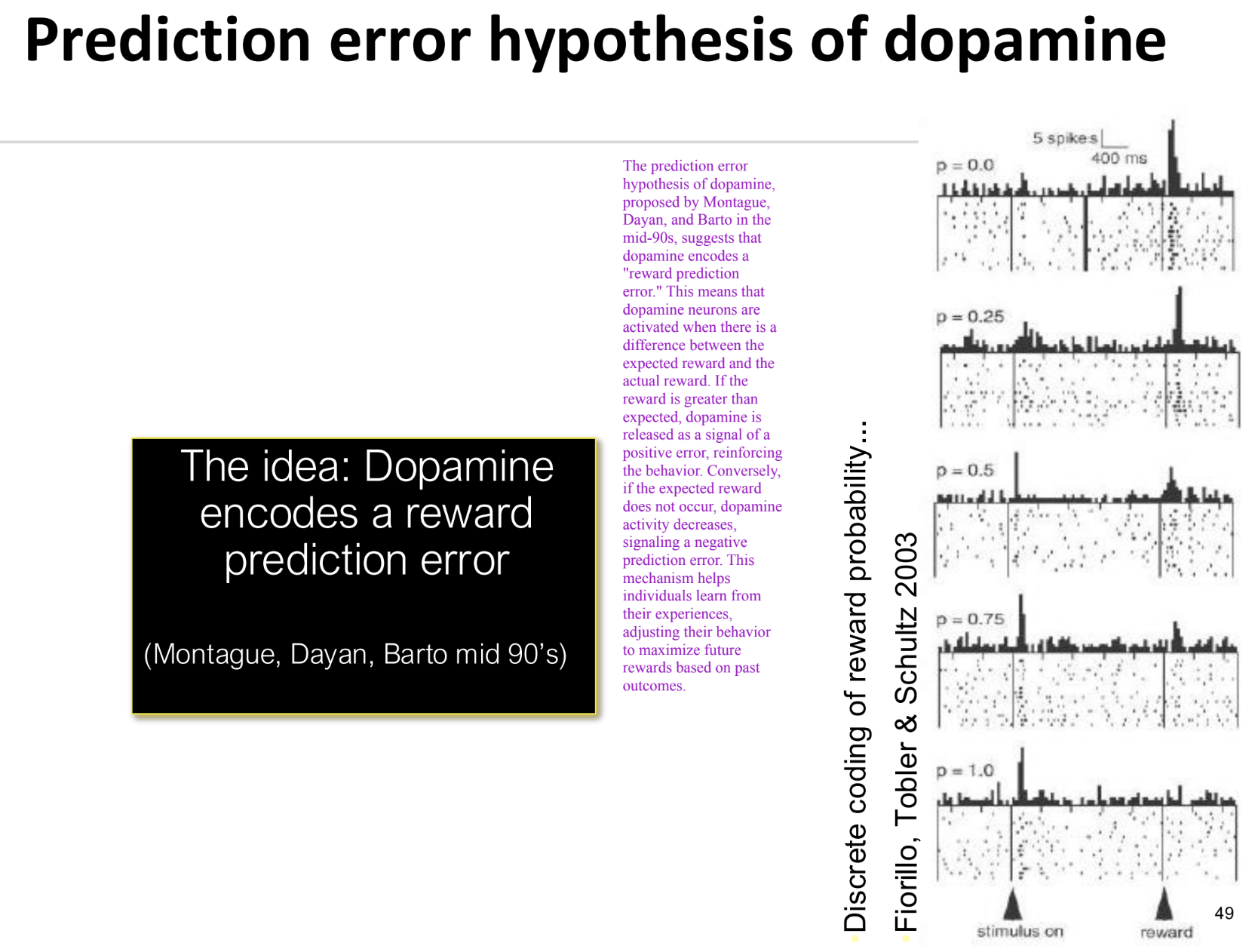Lecture 18: Decision Making and Reward
1/110
Earn XP
Description and Tags
By Jordana Burstein for Cognitive Neuroscience
Name | Mastery | Learn | Test | Matching | Spaced |
|---|
No study sessions yet.
111 Terms
What is the basic process of decision-making in the brain? (Deciding)
Decision-making starts with sensory information gathered from the environment. This is processed by the brain, leading to a decision to act, which results in a motor action (e.g., movement or speech). This flow is from perception → evaluation → action.
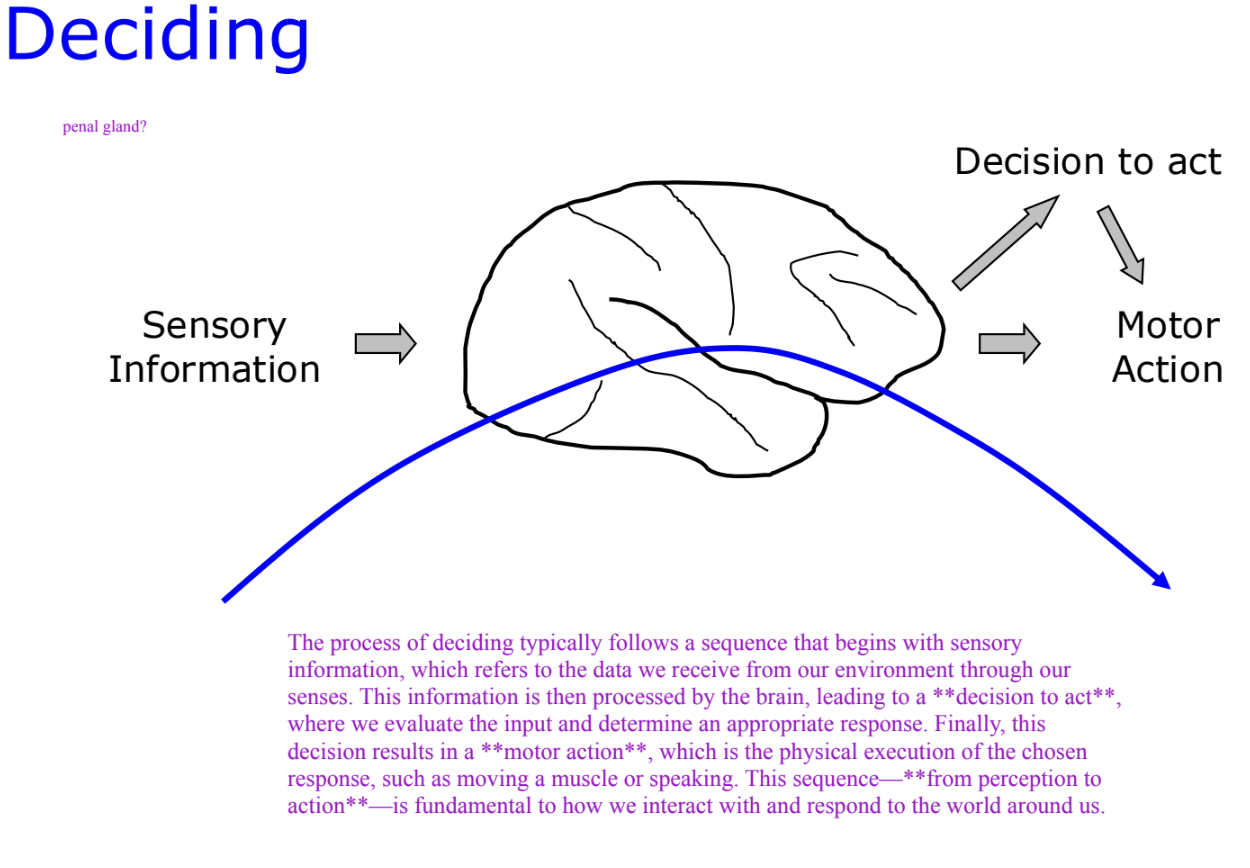
What are the historical roots of the concept of decision-making? (Dualism)
The roots lie in Descartes' 17th-century theory of dualism, which separated mind (thinking) from body (doing). Later, Sherrington (1947) showed how the nervous system links input and output, laying groundwork for modern neuroscience.
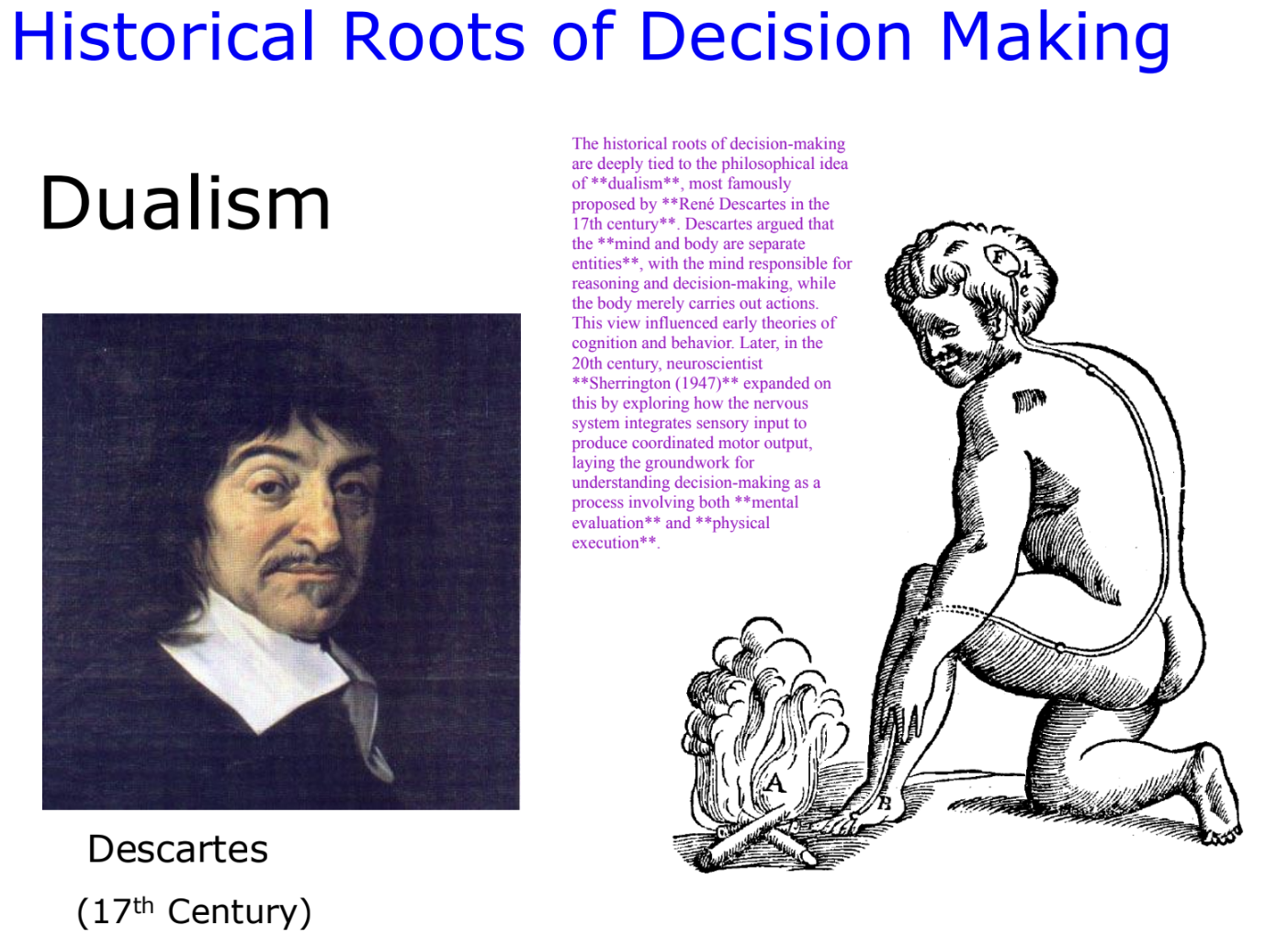
Who was René Descartes and why is he important to the study of decision-making? (Dualism)
Descartes was a 17th-century philosopher who proposed dualism, the idea that the mind and body are separate. He believed the mind (reasoning) controlled the body (action), influencing early theories of cognition.
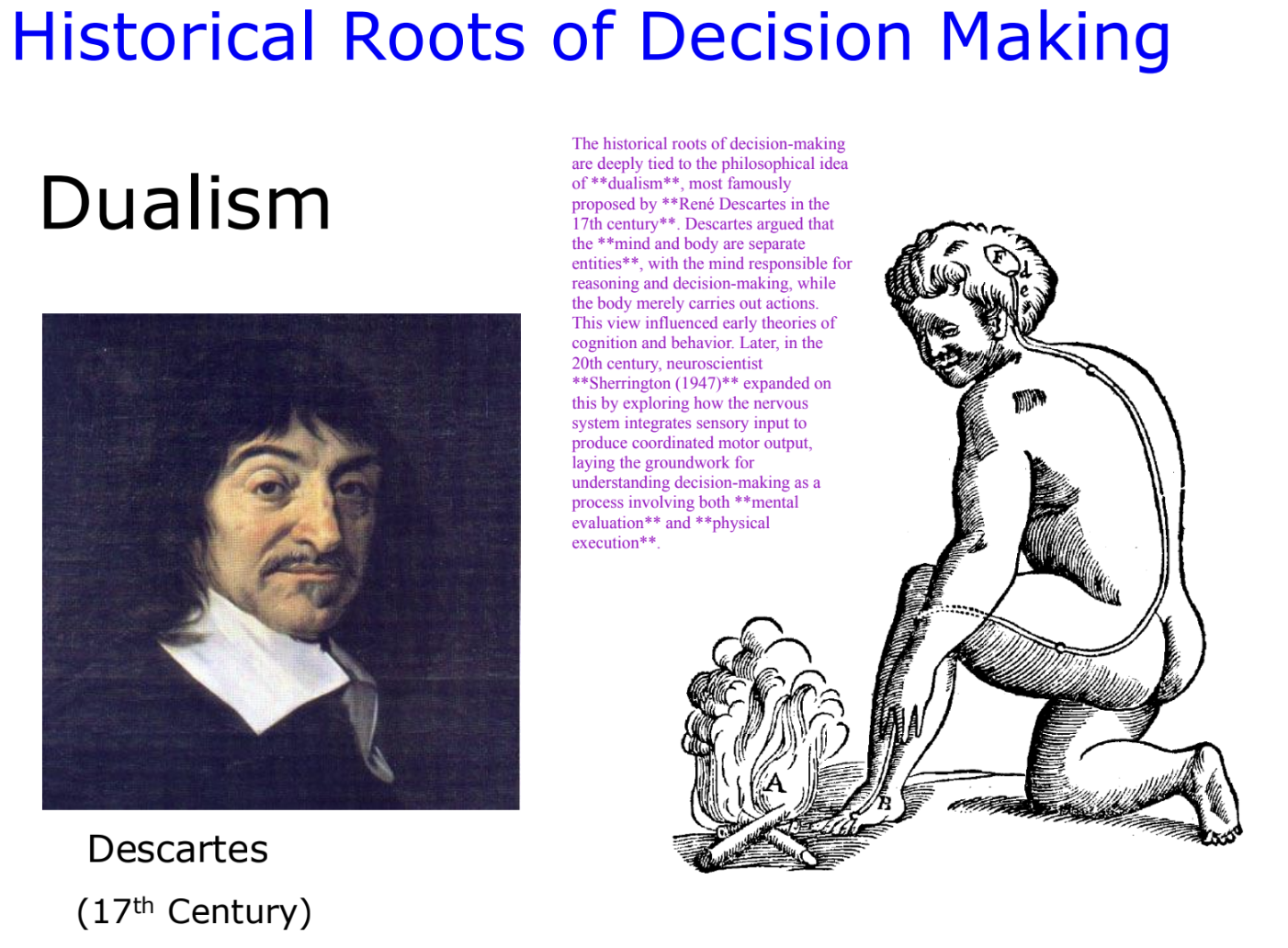
What is the concept of dualism? (Dualism)
Dualism is the view that the mind and body are two distinct entities—the mind is responsible for consciousness and thought, while the body carries out physical actions.
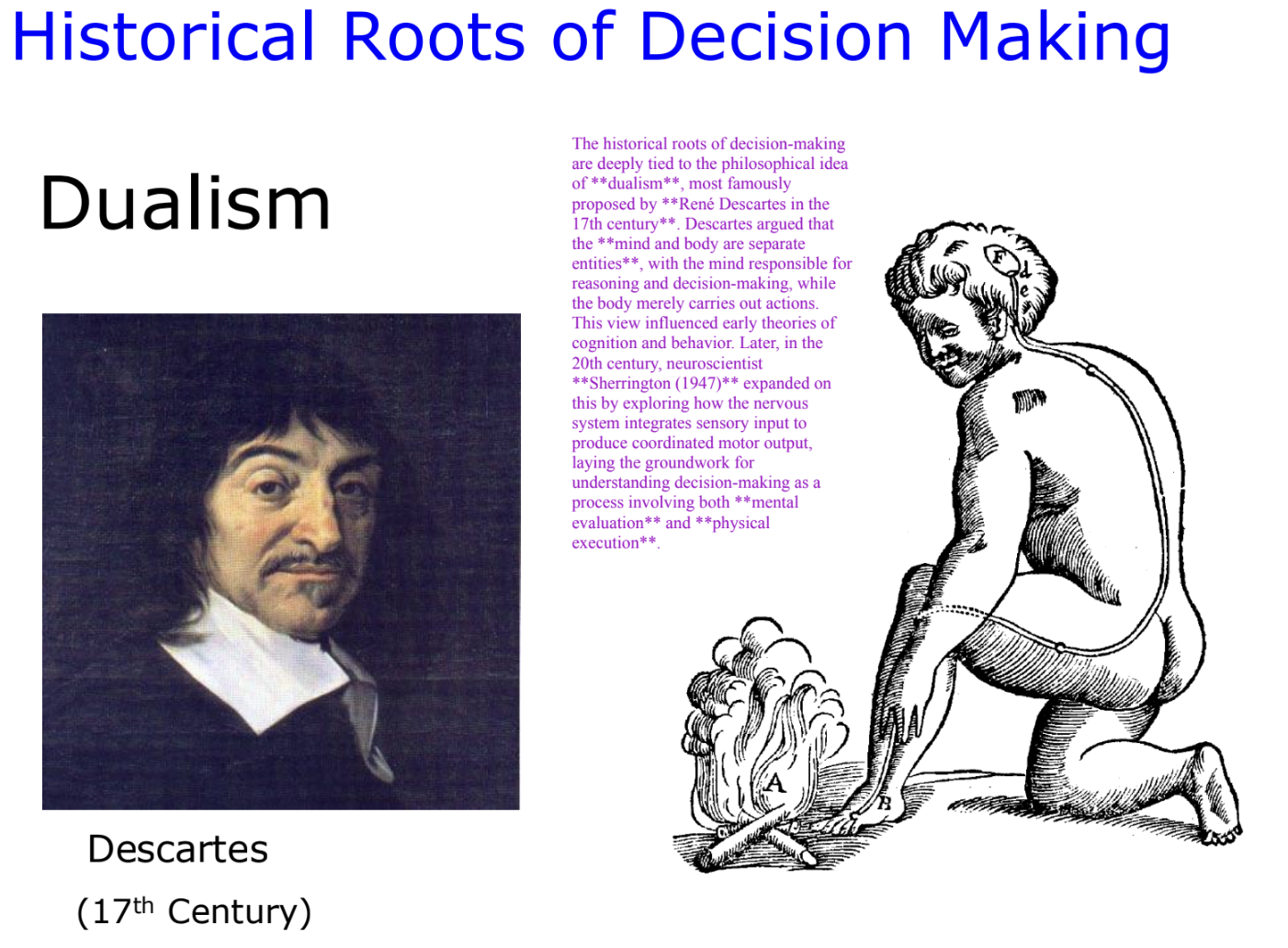
How did Sherrington contribute to the study of decision-making and dualism? (Dualism)
Sherrington (1947) studied reflexes and how the nervous system integrates sensory input to produce motor output. His work connected mental evaluation with physical behavior and helped bridge philosophy and neuroscience.

What’s the difference between dualism, monism, and phenomenalism? (Dualism)
Dualism: Mind and body are separate.
Monism: Only one substance exists. In materialism, the mind = brain activity.
Phenomenalism: Only mental experiences exist; physical objects are just perceptions.
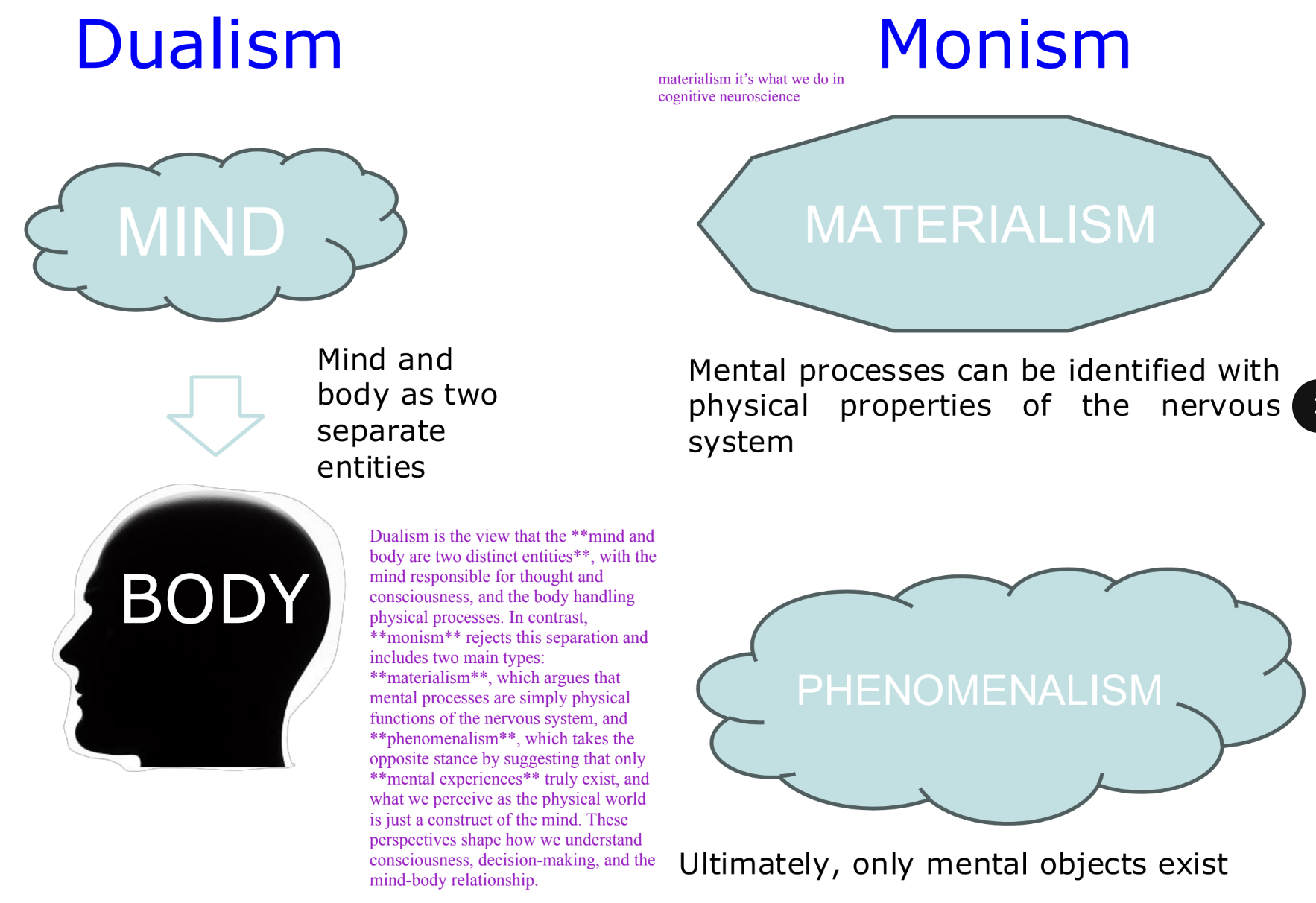
How does dualism explain the mind-body relationship? (Dualism)
Dualism holds that the mind controls thoughts and decisions, while the body carries them out physically. The two interact but are fundamentally different substances.
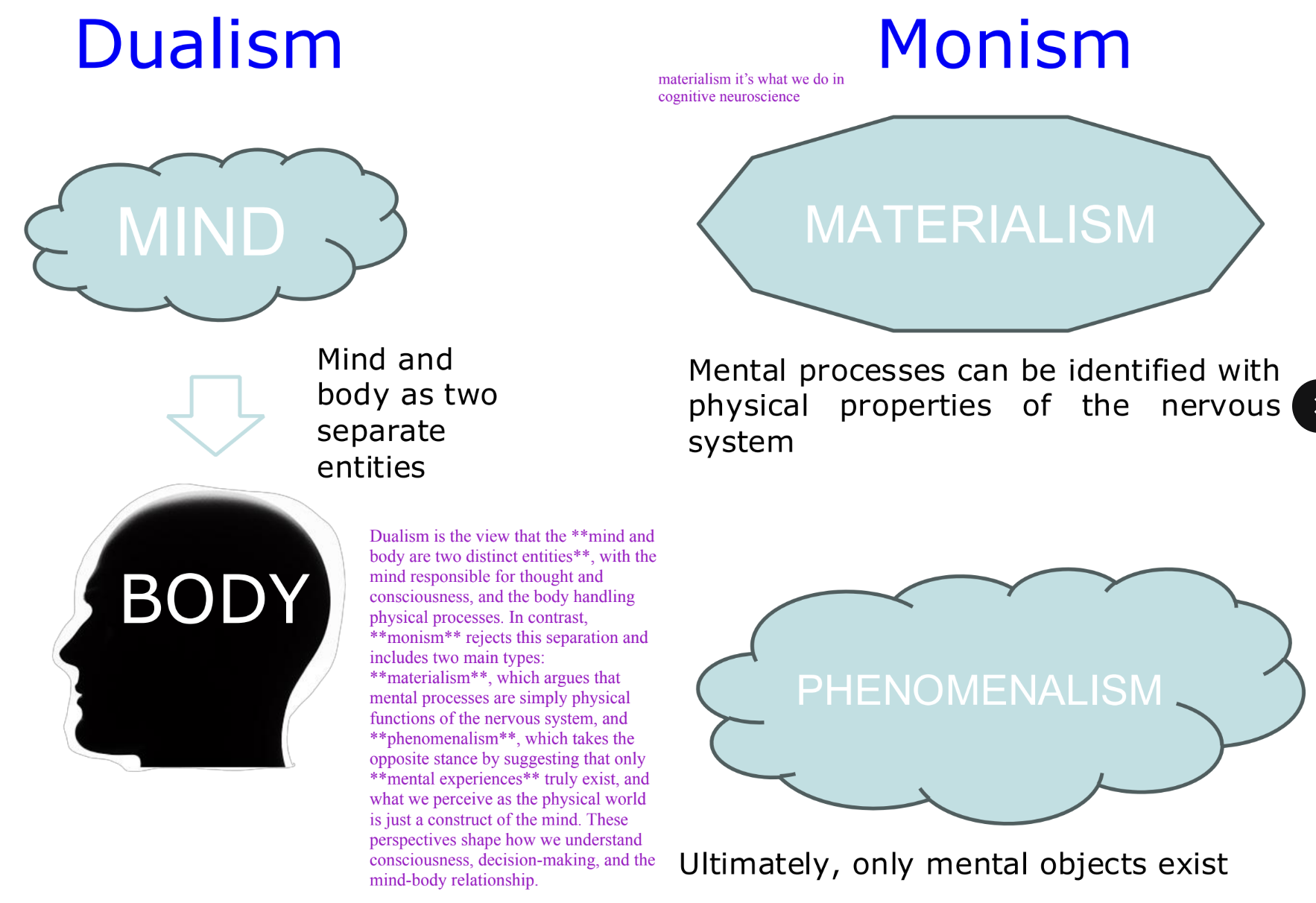
What is monism and how does it relate to cognitive neuroscience? (Dualism)
Monism (especially materialism) claims the mind is just a function of the brain. Mental states are physical states, and everything can be explained by neural processes. It’s the view used in modern neuroscience.
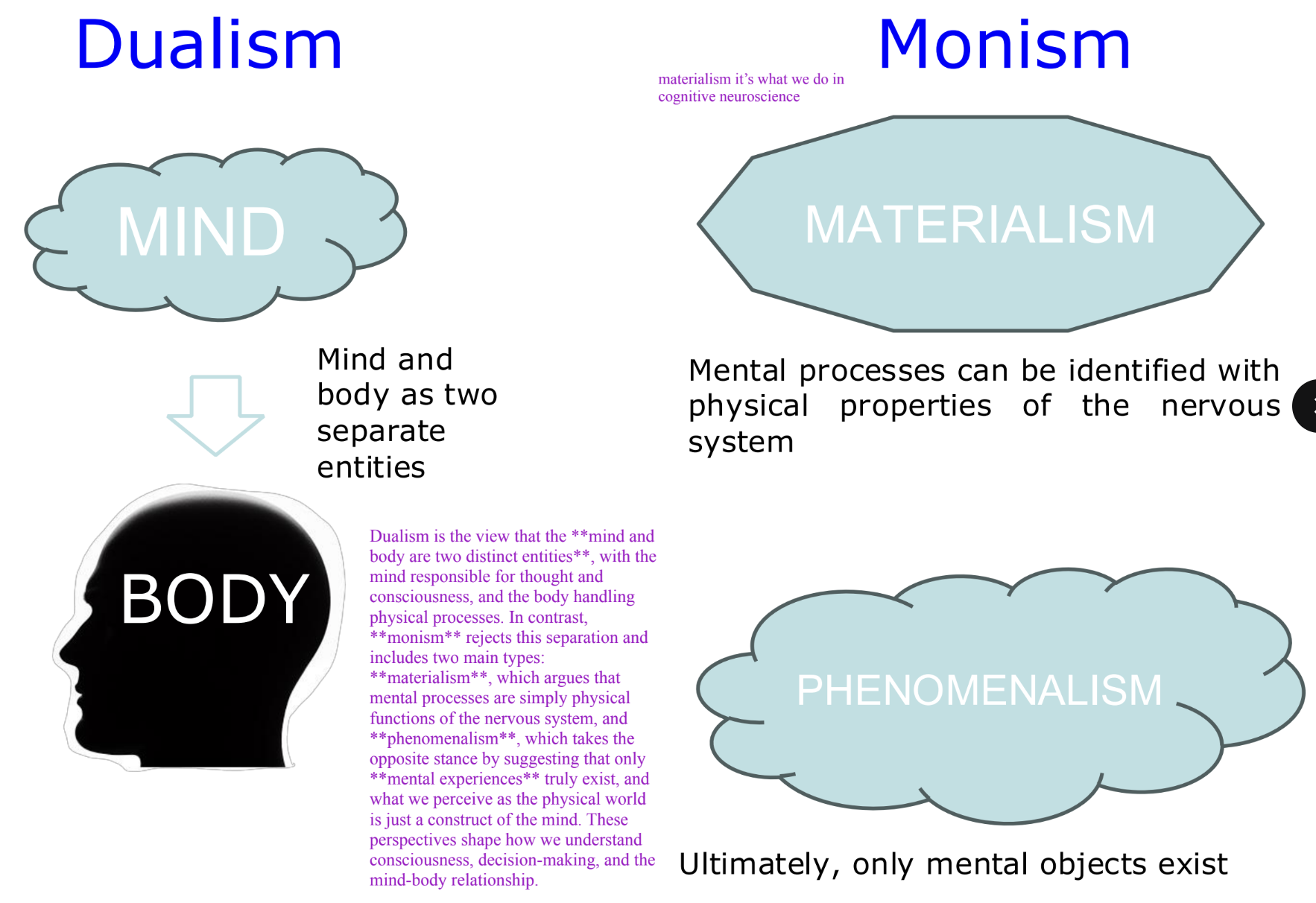
What is phenomenalism in the philosophy of mind? (Dualism)
Phenomenalism suggests that only mental experiences are real—the physical world is a construct of perception, not independent of the mind.
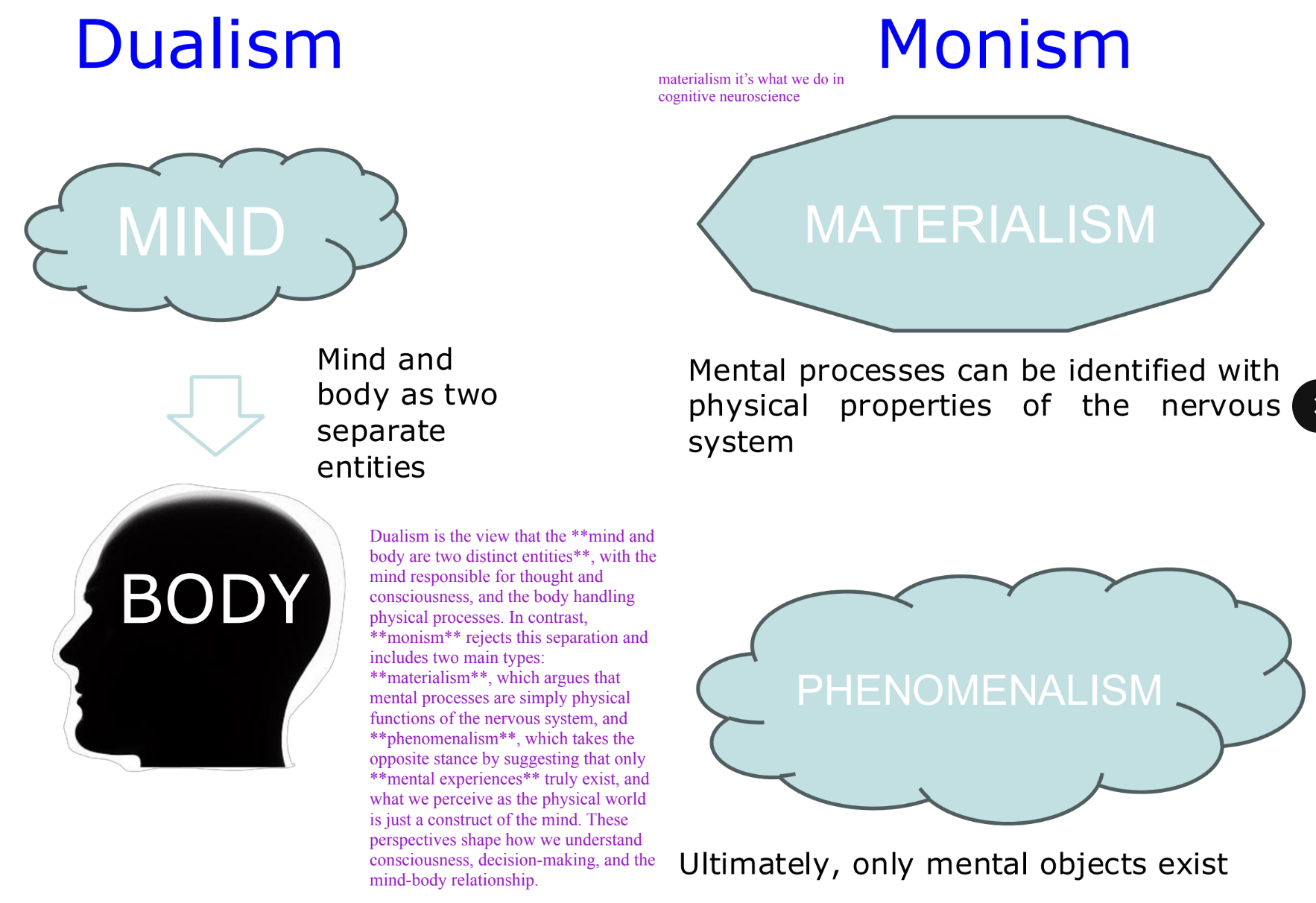
What are the Cartesian Theater and Homunculus argument, and why are they problematic? (Dualism)
The Cartesian Theater imagines a tiny observer (homunculus) inside the brain watching mental events. It suggests a central spot where consciousness "happens." But this leads to infinite regress (who watches the watcher?). It's rejected in modern theory in favor of distributed brain processing.
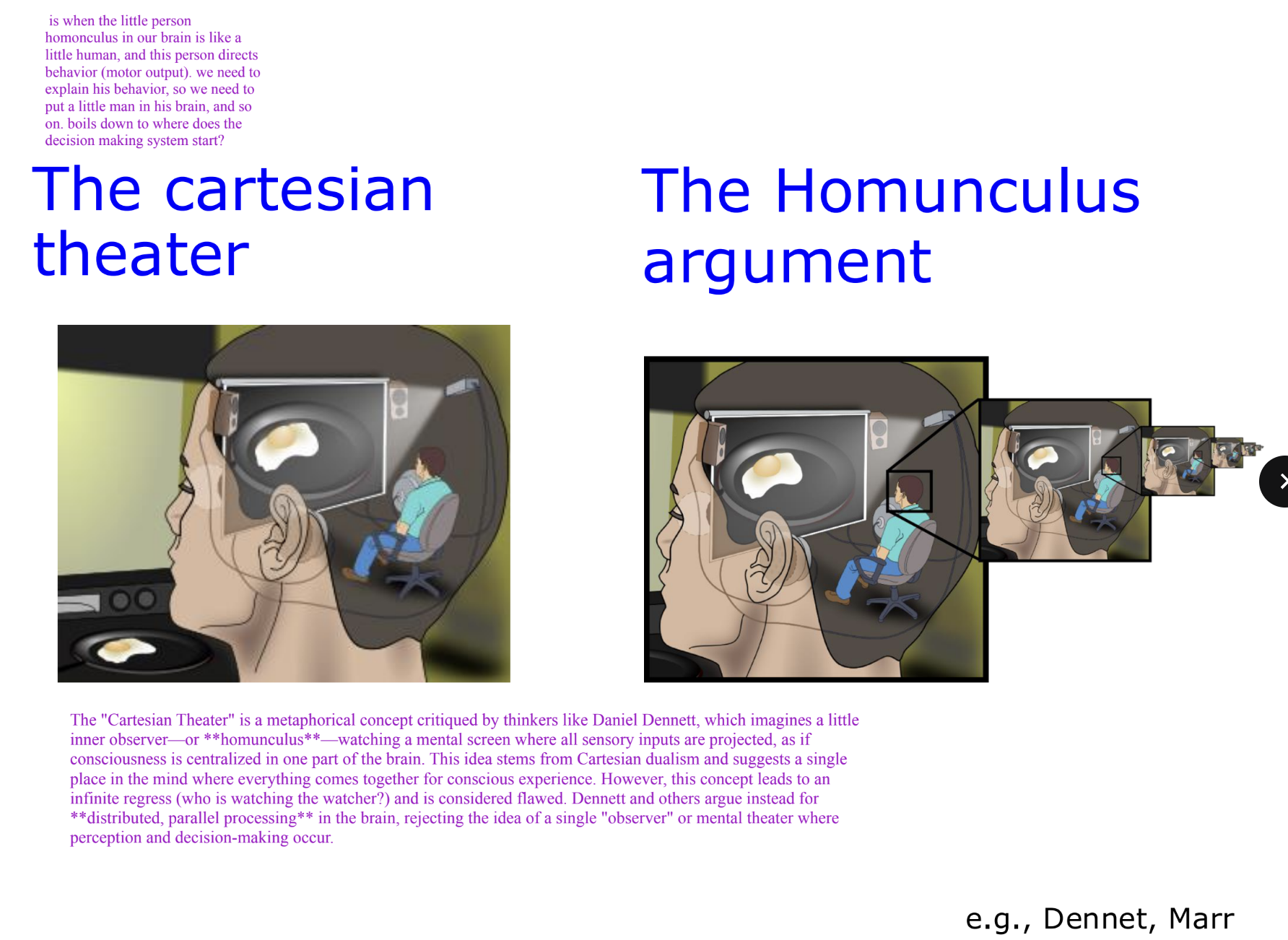
What are the six major decision factors, and what do they do? (Decision Factors)
Sensory Information – Input from the environment that gets processed by the brain.
Memory – Past experiences that help inform current choices.
Learning – Adjustments based on feedback or outcomes from past decisions.
Stochasticity – Randomness or unpredictability in decisions, adding flexibility or creativity.
Conscious Will – Our subjective experience of choosing and having control over our actions.
Motor Action – The physical output that results from the internal decision-making process.
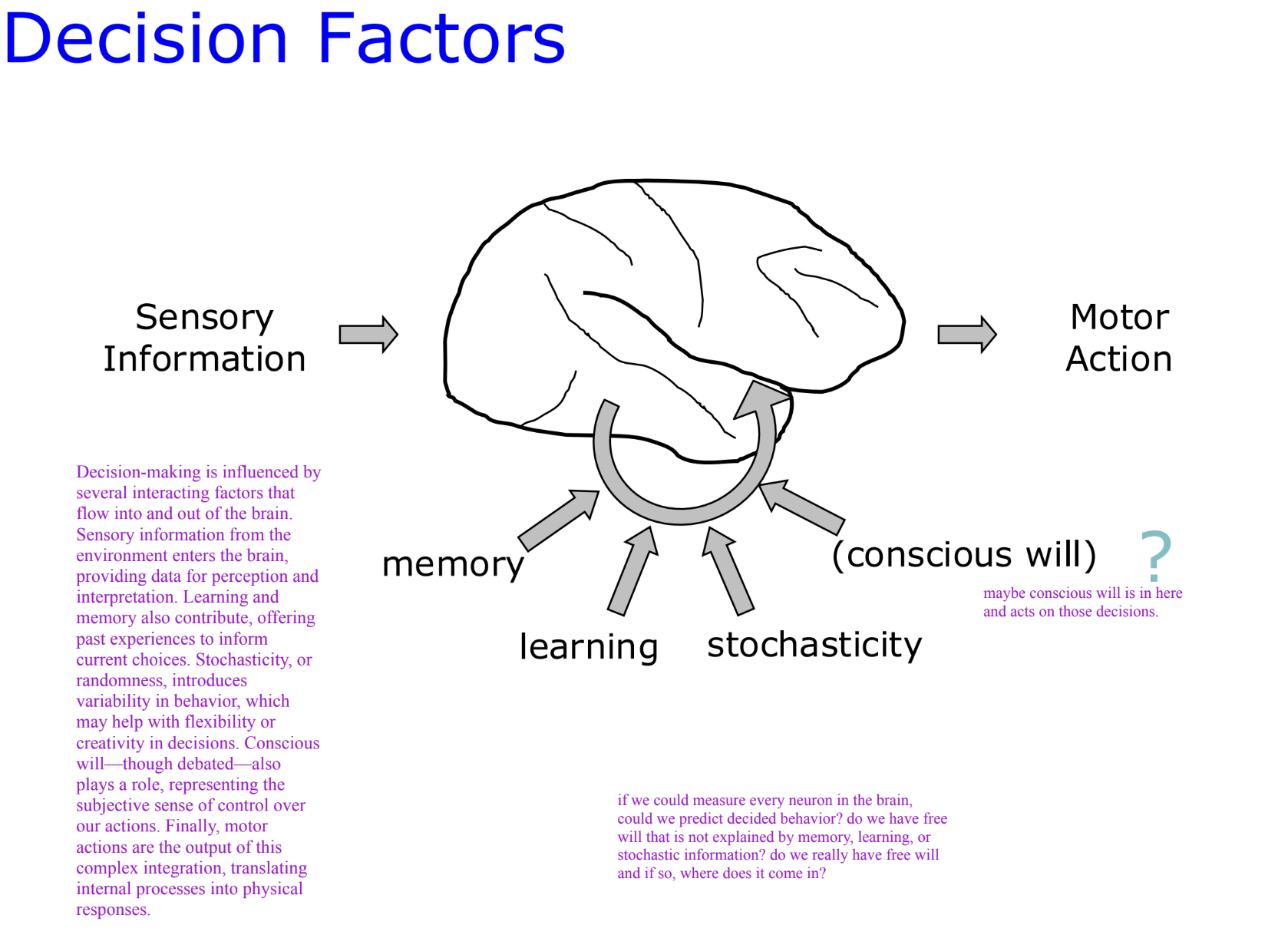
How does conscious will influence decision-making? (Decision Factors)
Conscious will represents our feeling of agency—the belief that we are choosing our actions freely. While it's debated whether this is a true cause or a byproduct of brain activity, it still plays a role in how we understand and reflect on our decisions.
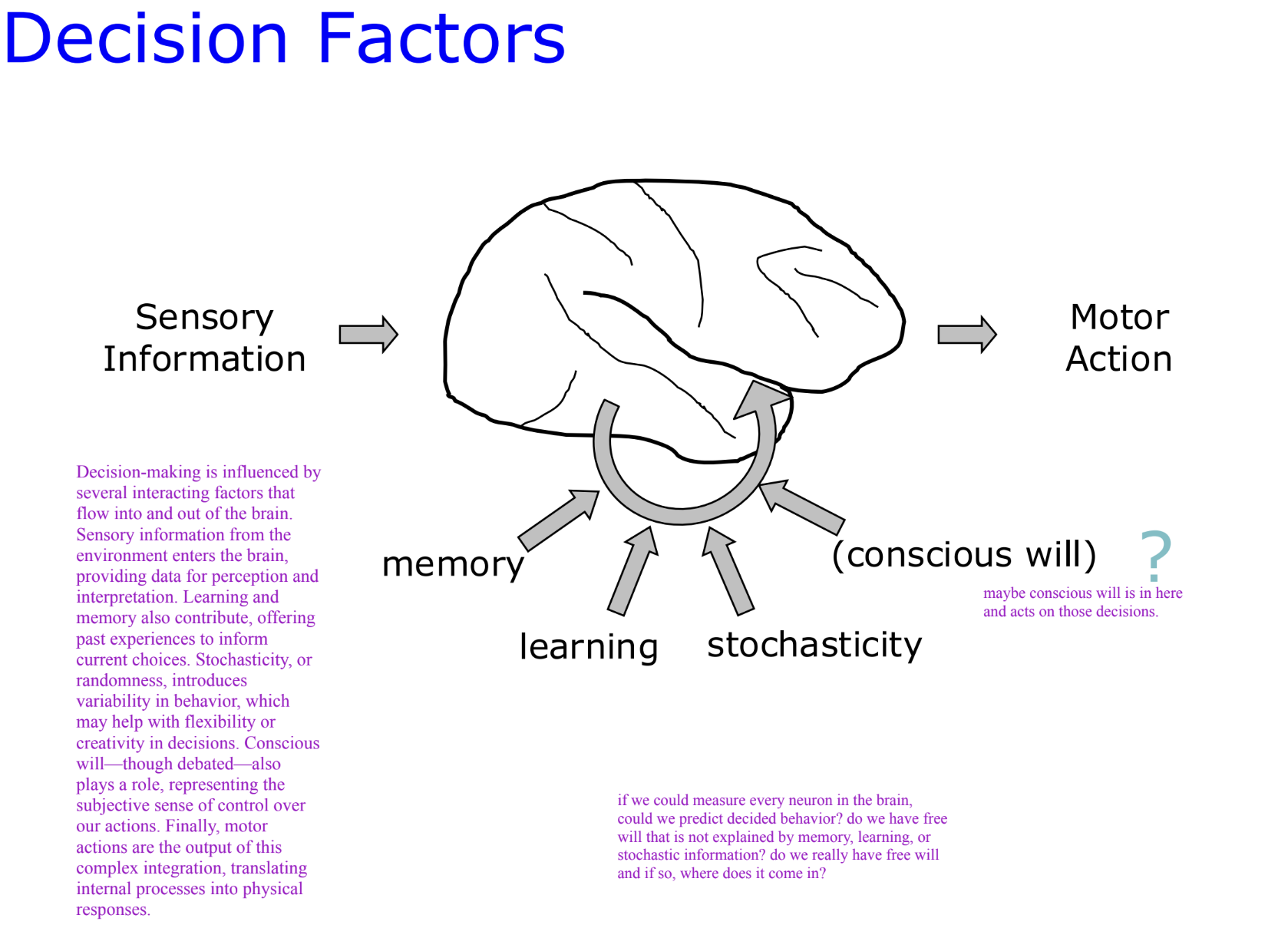
What is stochasticity, and how does it affect decisions? (Decision Factors)
Stochasticity refers to randomness or variability in decision-making. It can explain why we sometimes act unpredictably or differently in the same situation. This randomness can make behavior more flexible or creative, and sometimes it's intentionally used—like flipping a coin when overwhelmed.
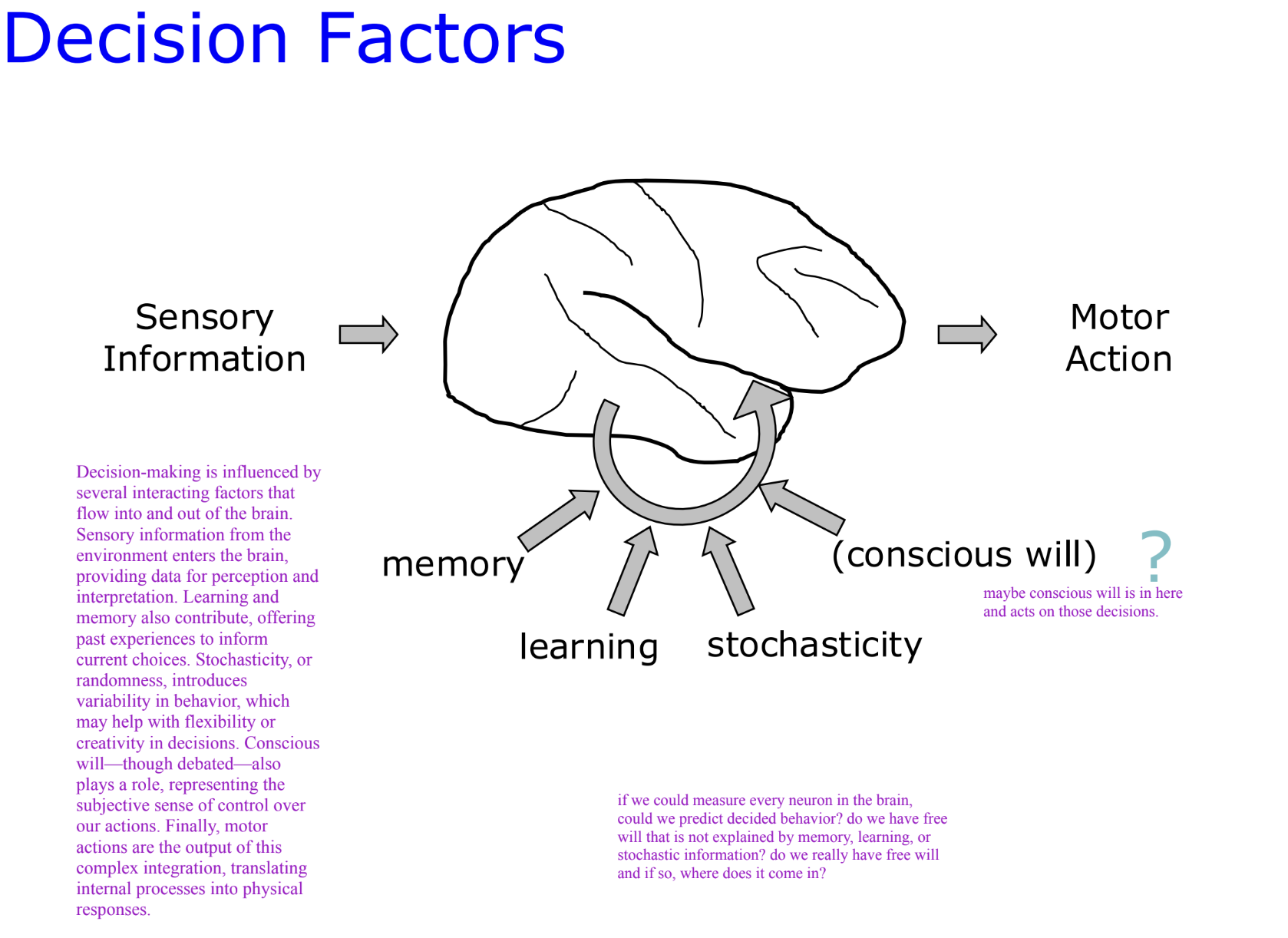
How do sensory information, memory, learning, stochasticity, conscious will, and motor action interact in decision-making? (Decision Factors)
These factors form a loop: sensory info comes in → memory and learning help interpret it → stochasticity introduces variability → conscious will may influence outcomes → a motor action is made. All these steps interact to shape each decision.
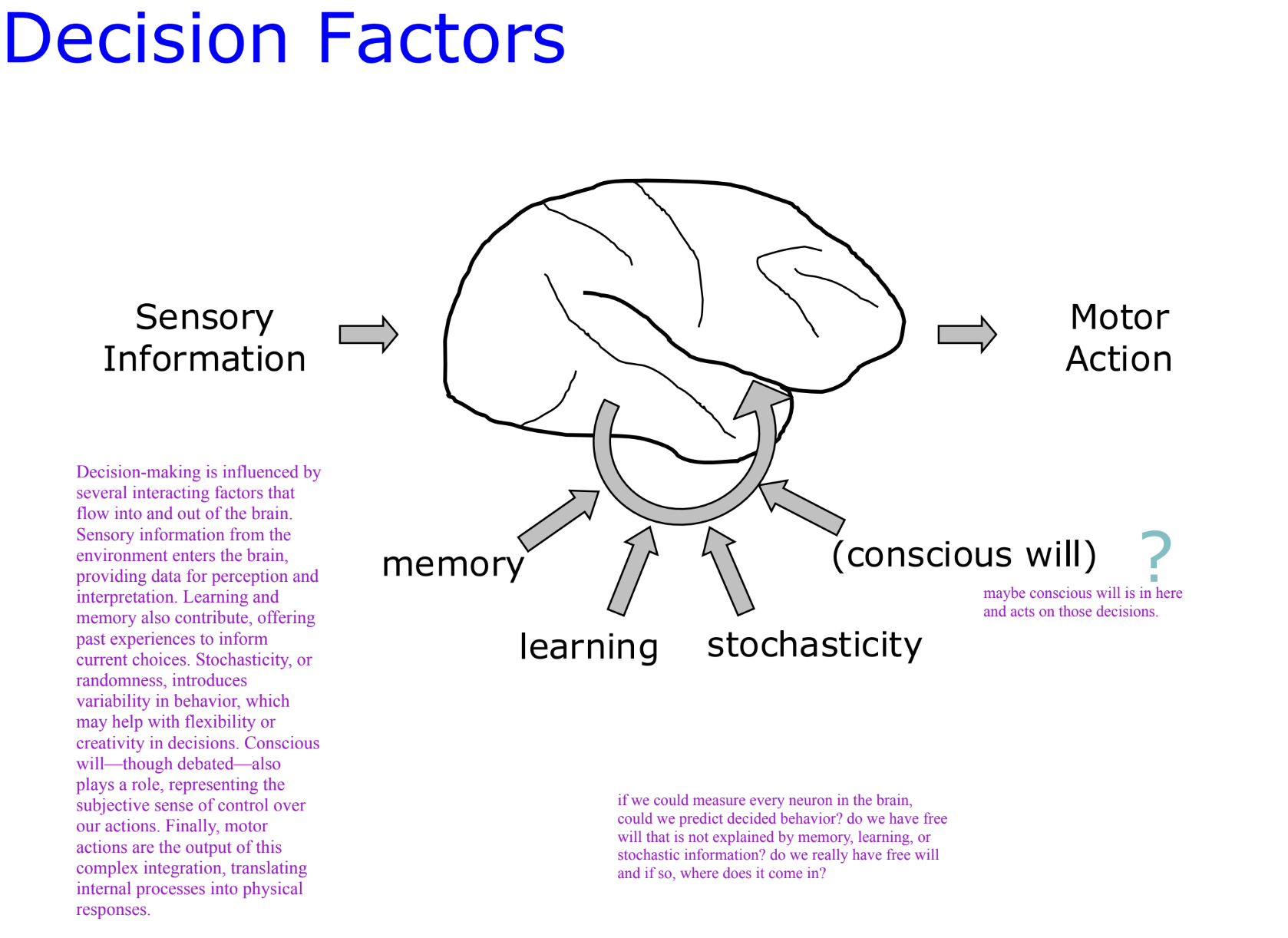
How does the teacher's story about coin-flipping students reflect decision-making and reward? (Decision Factors)
The students use stochasticity (randomness) to avoid personal responsibility. By externalizing decisions to chance, they avoid blame and add drama to choices. This shows how people may escape the pressure of rational decisions, especially when overwhelmed or seeking novelty.
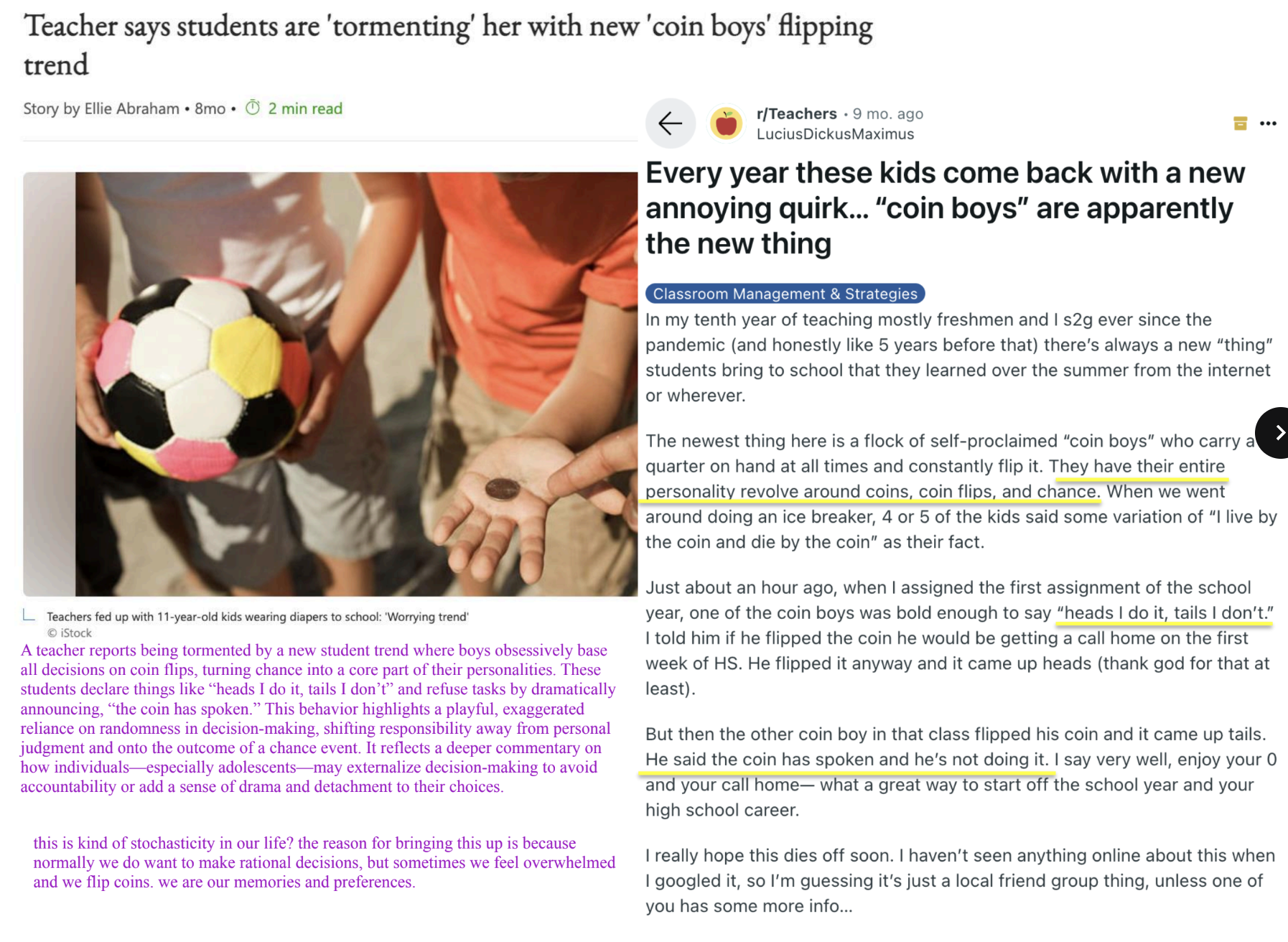
What did Yarbus's experiment show about visual attention and decision-making? (Decision Factors)
In the experiment, people were asked to look at a statue (like Nefertiti), and eye-tracking showed that their gaze patterns weren’t random—they made similar decisions about where to look. This revealed that even visual exploration is a decision-making process shaped by goals and expectations.
Procedure: Subjects viewed the same image; eye movements were tracked.
Result: Gaze patterns varied depending on the task or prompt—showing top-down decision control.

What are models of simple decisions in neuroscience? (Decision Factors)
These are models that explain how basic decisions are made based on sensory and nonsensory inputs (decision variables). They include detecting unexpected stimuli (oddball detection) or choosing between directions (motion discrimination). These tasks show how the brain turns perception into action using both sensory input and internal decision variables.
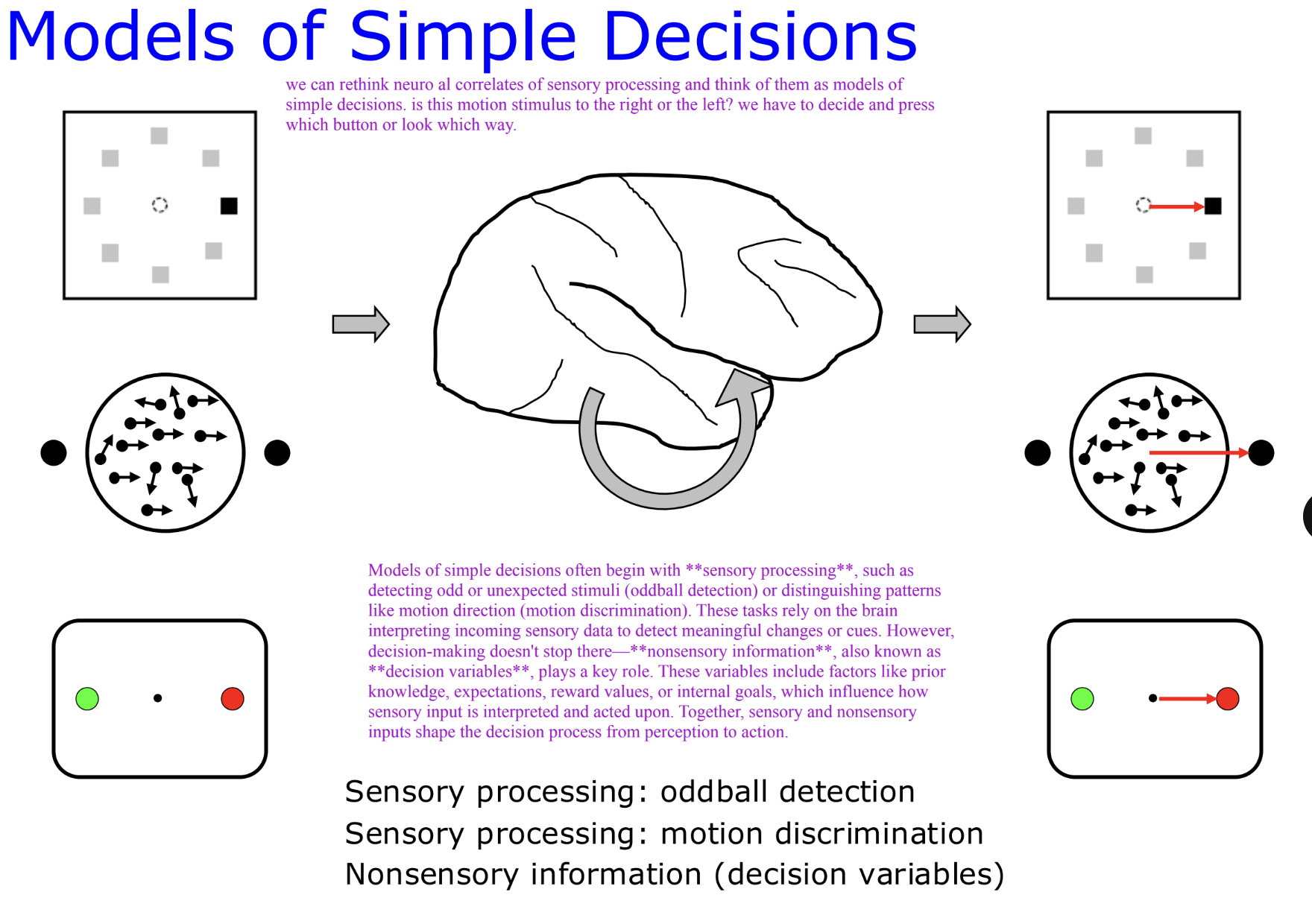
What are the main elements of simple decision-making models, and what do they mean? (Decision Factors)
Sensory Information – The raw data from the environment.
Motor Action – The behavioral response or choice made.
Decision Factors – The internal influences like:
Memory – Past experiences shaping choice.
Learning – Adjustments from outcomes of prior decisions.
Stochasticity – Randomness that adds variability.
Conscious Will – The feeling of choosing deliberately.
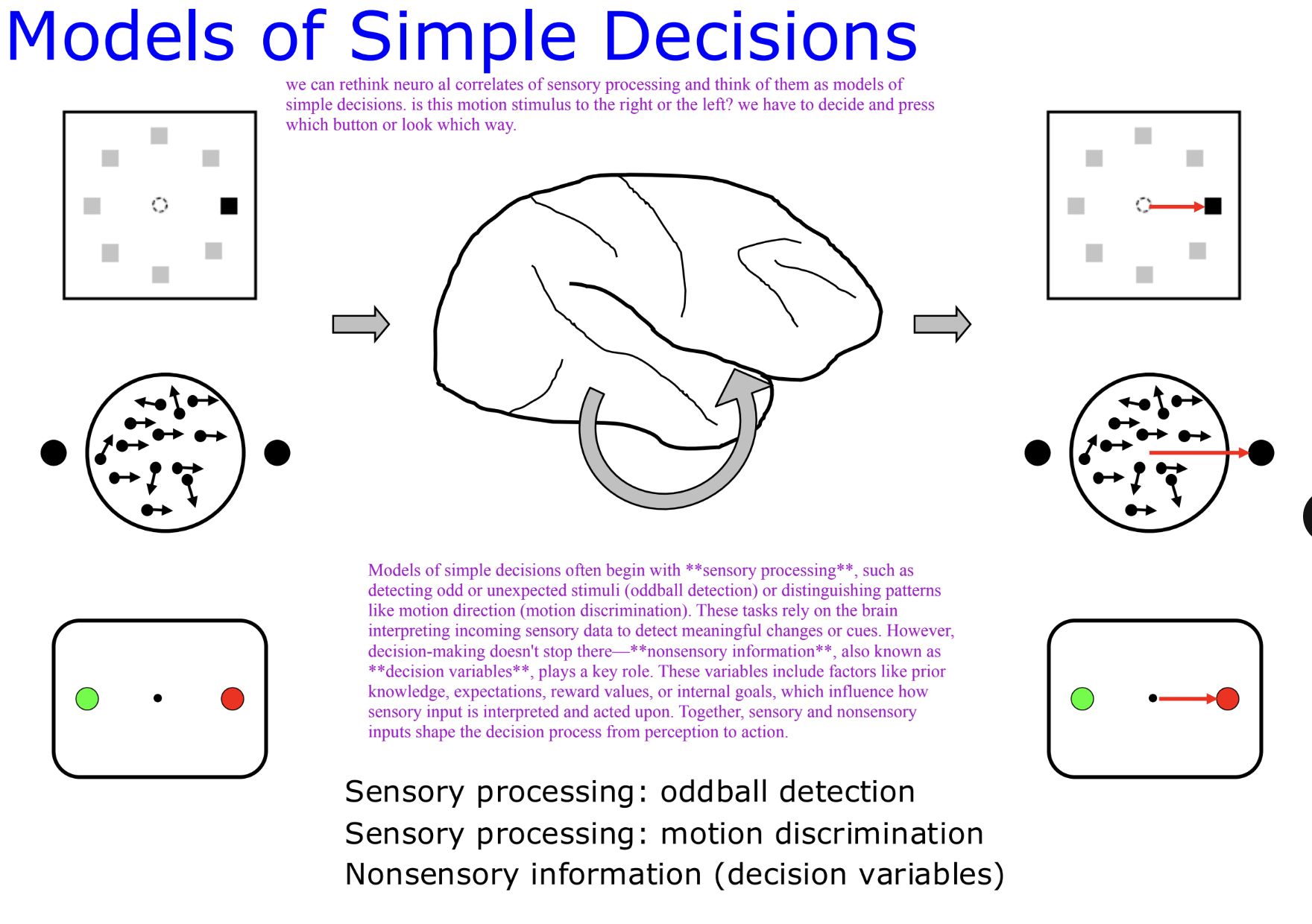
What are the five main topics covered in the outline of decision neuroscience, and what do they focus on? (Decision Areas in Brain)
Saccade Generation & Eye Movement Control – How the brain decides where to look.
Perceptual Decision Making (Newsome) – Using motion/sensory input to make decisions.
Integrative Sensorimotor Processing (Shadlen) – Accumulating evidence over time to guide actions.
Target Selection & Reaction Times (Schall) – Choosing between competing options and timing the response.
Decision Variables & Subjective Choice (Glimcher) – Internal values and expectations shaping personal choices.

What is the Middle Temporal area (MT or V5), and how does it contribute to decision-making? (Decision Areas in Brain)
MT is part of the extrastriate visual cortex and processes motion information. It receives input from V1 and V2 and has neurons tuned to specific directions and speeds. MT helps encode the instantaneous strength of motion, influencing perceptual decisions, especially those involving movement. It works with areas like LIP, FEF, and SC to guide actions such as saccades.
neurons encode for instantaneous strength of motion in preferred direction

What is the Lateral Intraparietal Area (LIP), and what does it do in decision-making and reward? (Decision Areas in Brain)
LIP is located in the intraparietal sulcus and is involved in saccade planning, attention, and decision-making. It gets input from MT and projects to FEF and SC. Neurons in LIP are active before and during saccades, coding for their direction and amplitude. It plays a key role in integrating sensory info and preparing motor responses, reflecting covert decisions before they are executed.
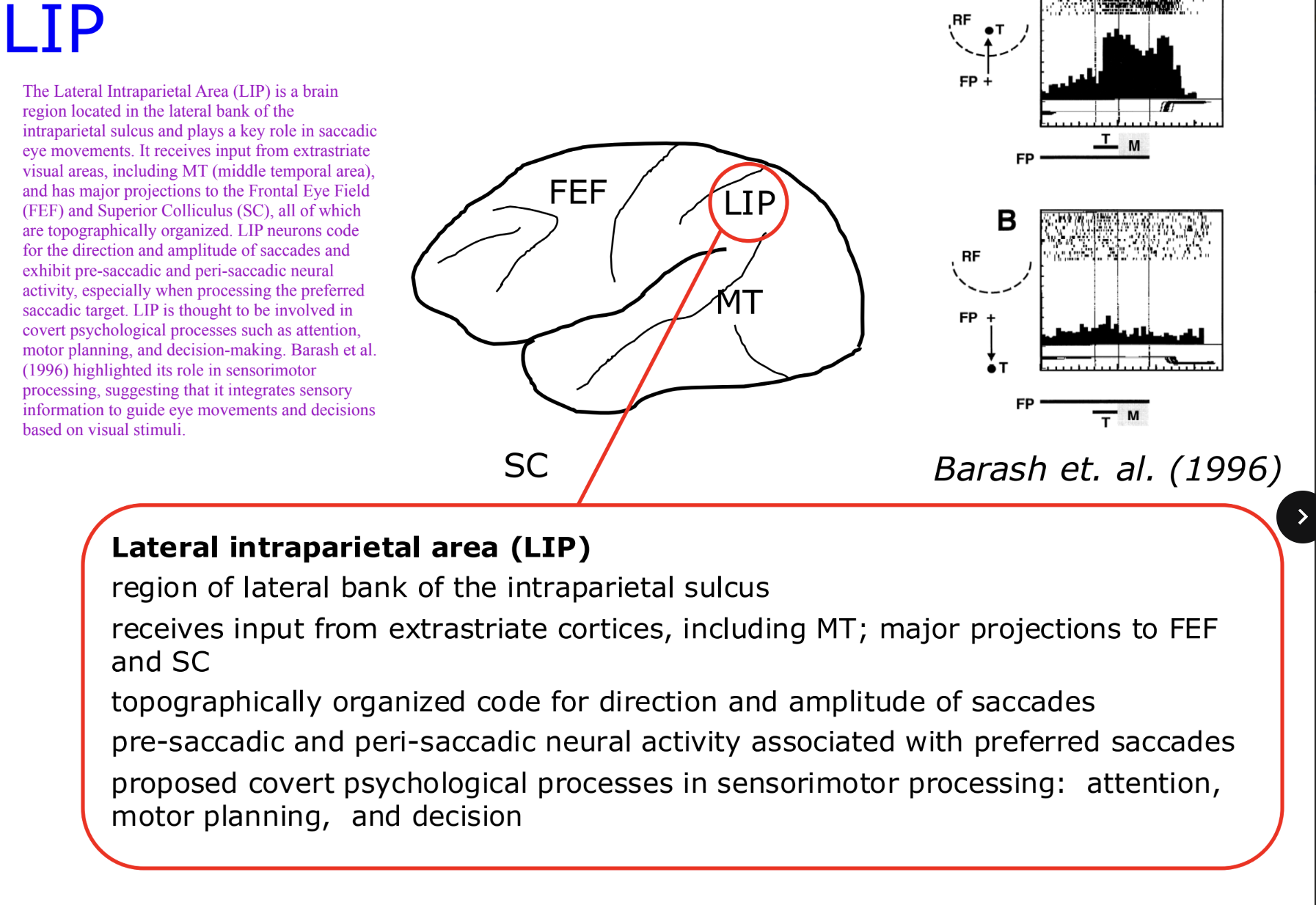
What does the Frontal Eye Field (FEF) do in eye movements and decisions? (Decision Areas in Brain)
FEF is located in the prefrontal cortex and controls both visual attention and motor output for eye movements. Stimulation of FEF can cause saccades. It integrates inputs from MT, LIP, and other visual areas. Its neurons show a burst-sustain-ramp-burst pattern when preparing a saccade, linking sensory input to the motor decision of moving the eyes.
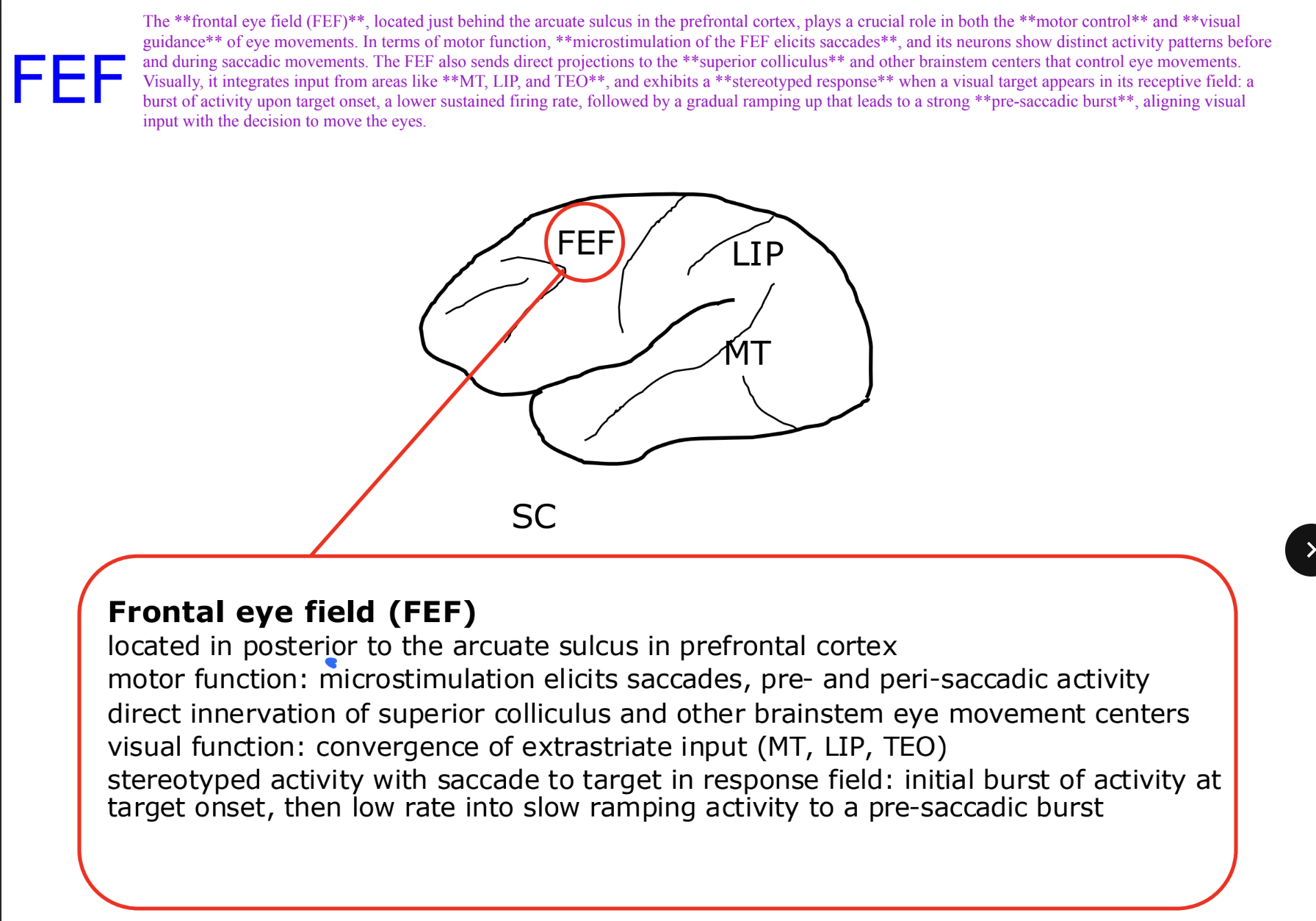
What role does the Superior Colliculus (SC) play in saccade generation and decision-making? (Decision Areas in Brain)
SC is in the dorsal midbrain and contains a retinotopic map of visual space. It receives input from visual areas (retina, striate, extrastriate) and motor areas like FEF and LIP. It codes for saccade direction and amplitude, and stimulation produces eye movements. SC integrates sensory and motor signals to execute saccadic decisions.
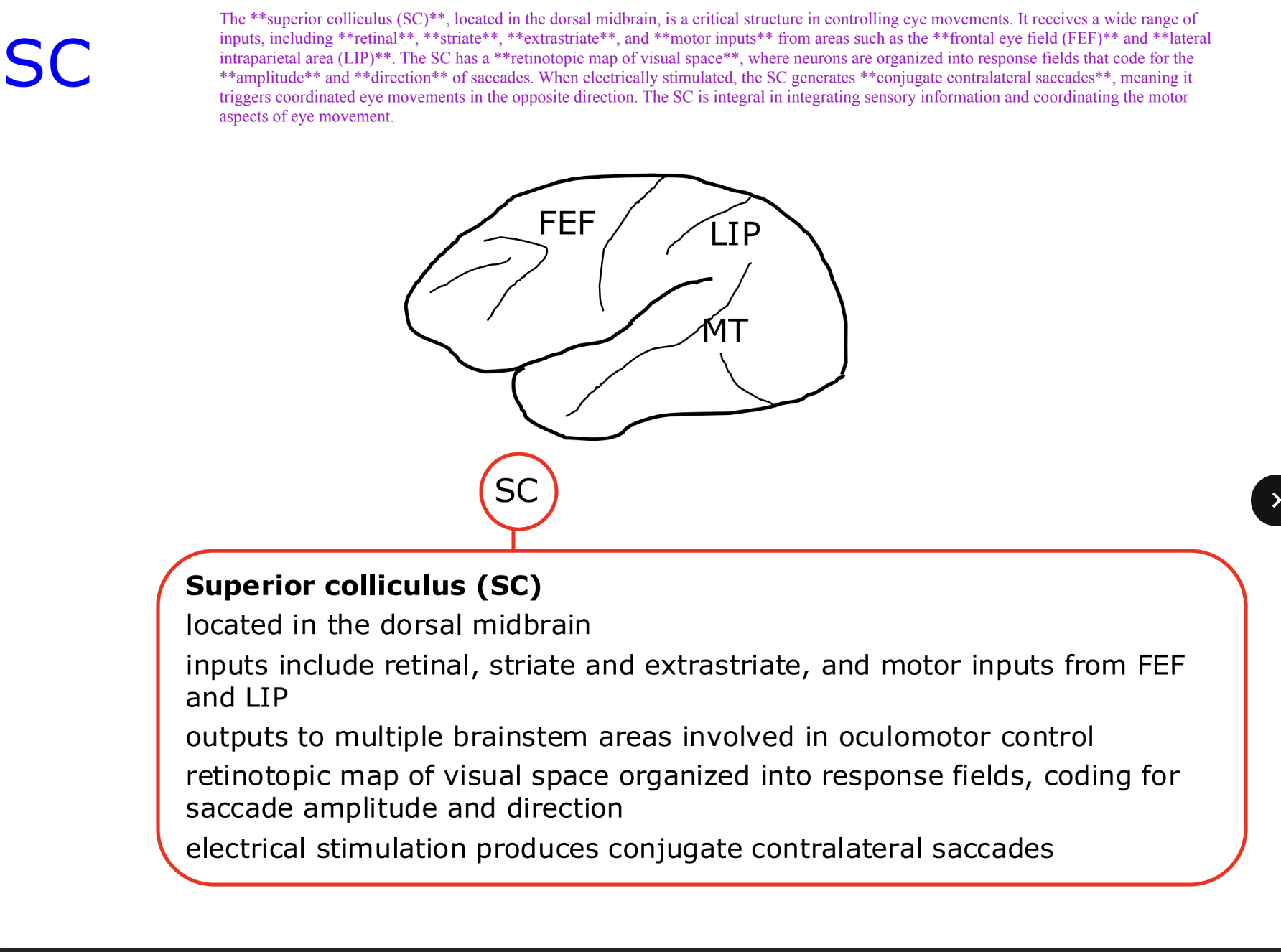
How does the saccade decision network process motion to generate eye movements? (Saccade generation and control of eye movements)
MT processes motion direction and strength.
LIP integrates sensory input and plans saccades.
Info then goes either directly to the SC or through the FEF, which also guides saccade planning.
SC transforms the signal into motor commands.
The oculomotor nuclei in the brainstem execute the saccade by controlling eye muscles.
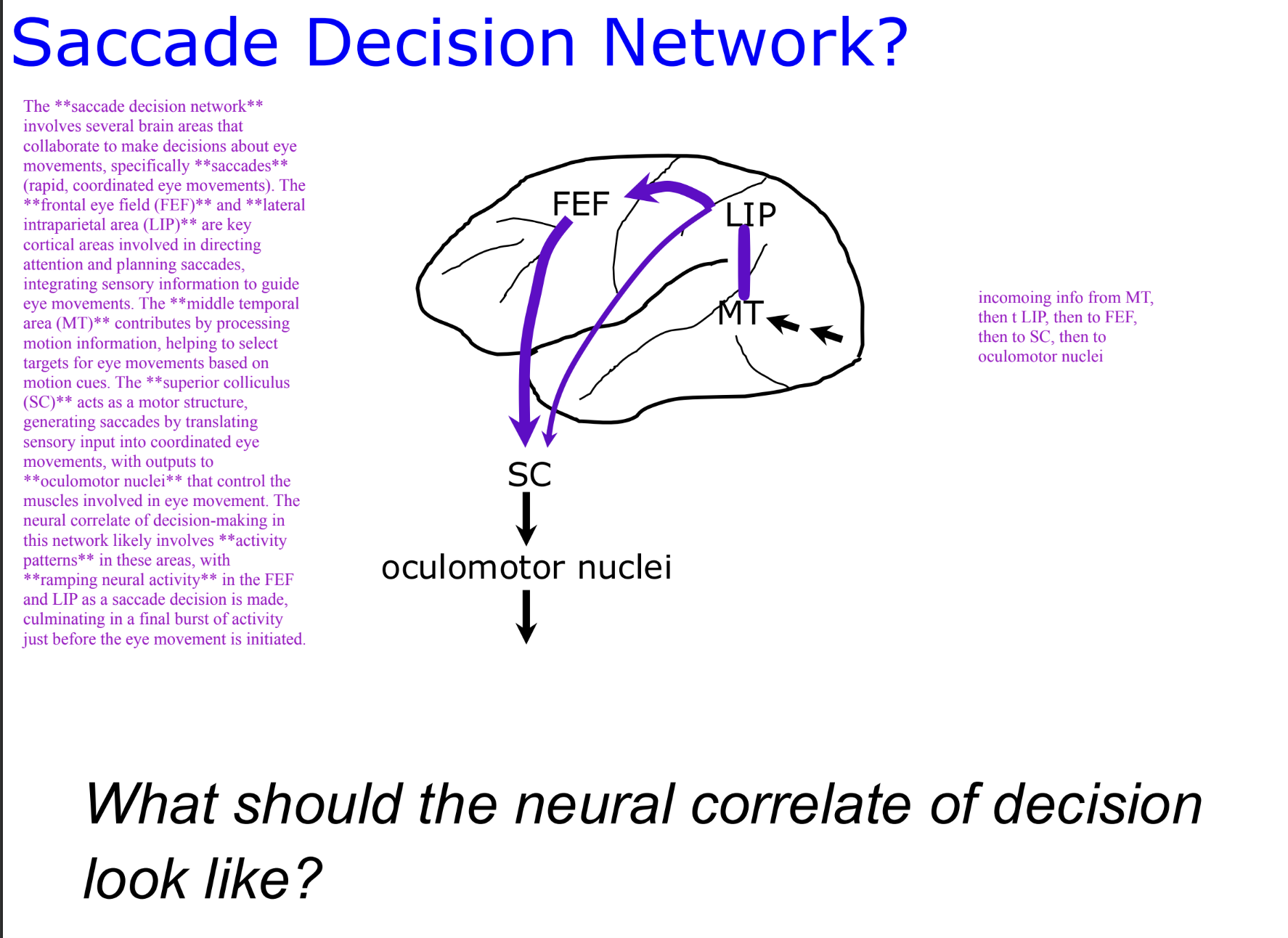
What is expected of a neural correlate of decision-making? (Saccade generation and control of eye movements)
It should involve:
Ramping activity in decision-related regions like LIP and FEF that increases as evidence accumulates.
Threshold activation, followed by a burst of neural firing just before the decision is made.
A correlation between firing rate and decision outcome, especially in perceptual decision tasks.
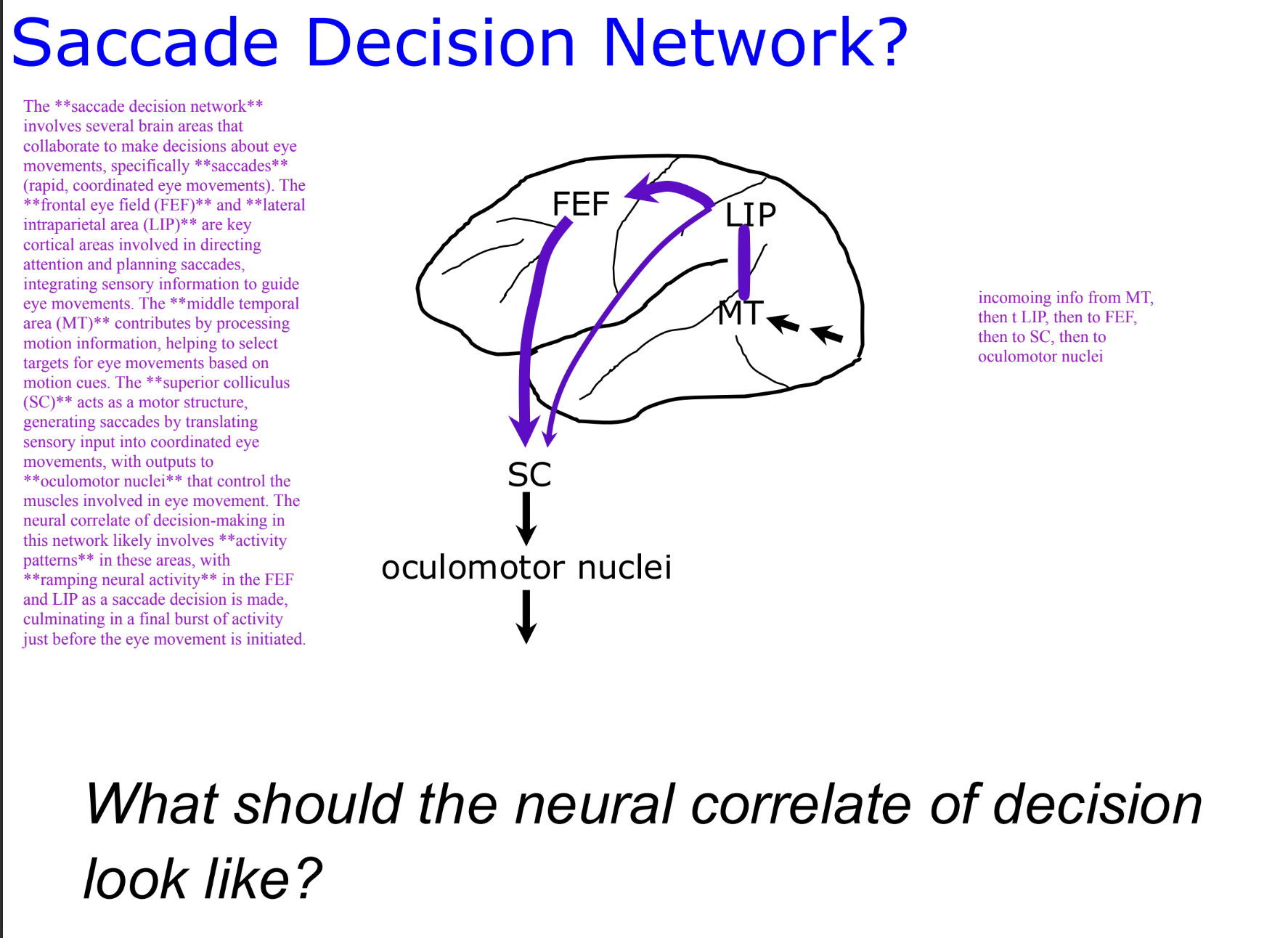
How do MT neurons behave during motion discrimination tasks? (Saccade generation and control of eye movements)
MT neurons fire in response to motion in their preferred direction.
Firing rate increases with motion coherence (0% → 100%).
This activity predicts the perceived direction of motion, linking MT neuron activity to the subject’s decision.

What did Newsome, Britten, and Movshon aim to find out in 1989? (Perceptual Decision Making)
They aimed to determine whether neurons in the MT region are involved in motion-based perceptual decisions, by testing how their firing correlates with behavioral responses during a motion discrimination task.
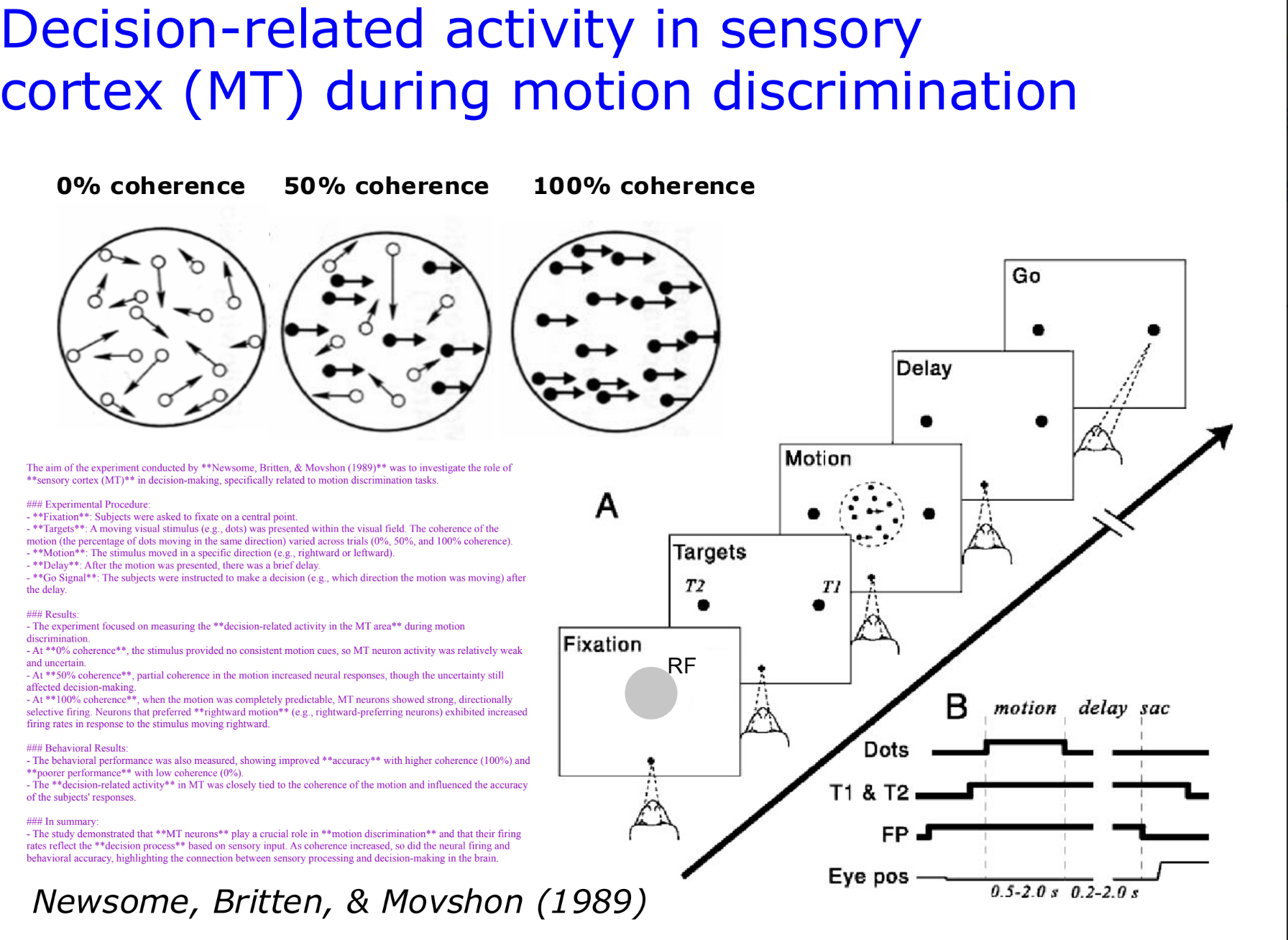
What was the procedure in the Newsome et al. motion discrimination study? (Perceptual Decision Making)
Fixation on a central point.
Presentation of moving dot stimuli with varying motion coherence (0%, 50%, 100%).
Delay period followed the motion.
A go signal prompted subjects to report the motion direction (left/right).
Neuronal firing in MT was recorded throughout.
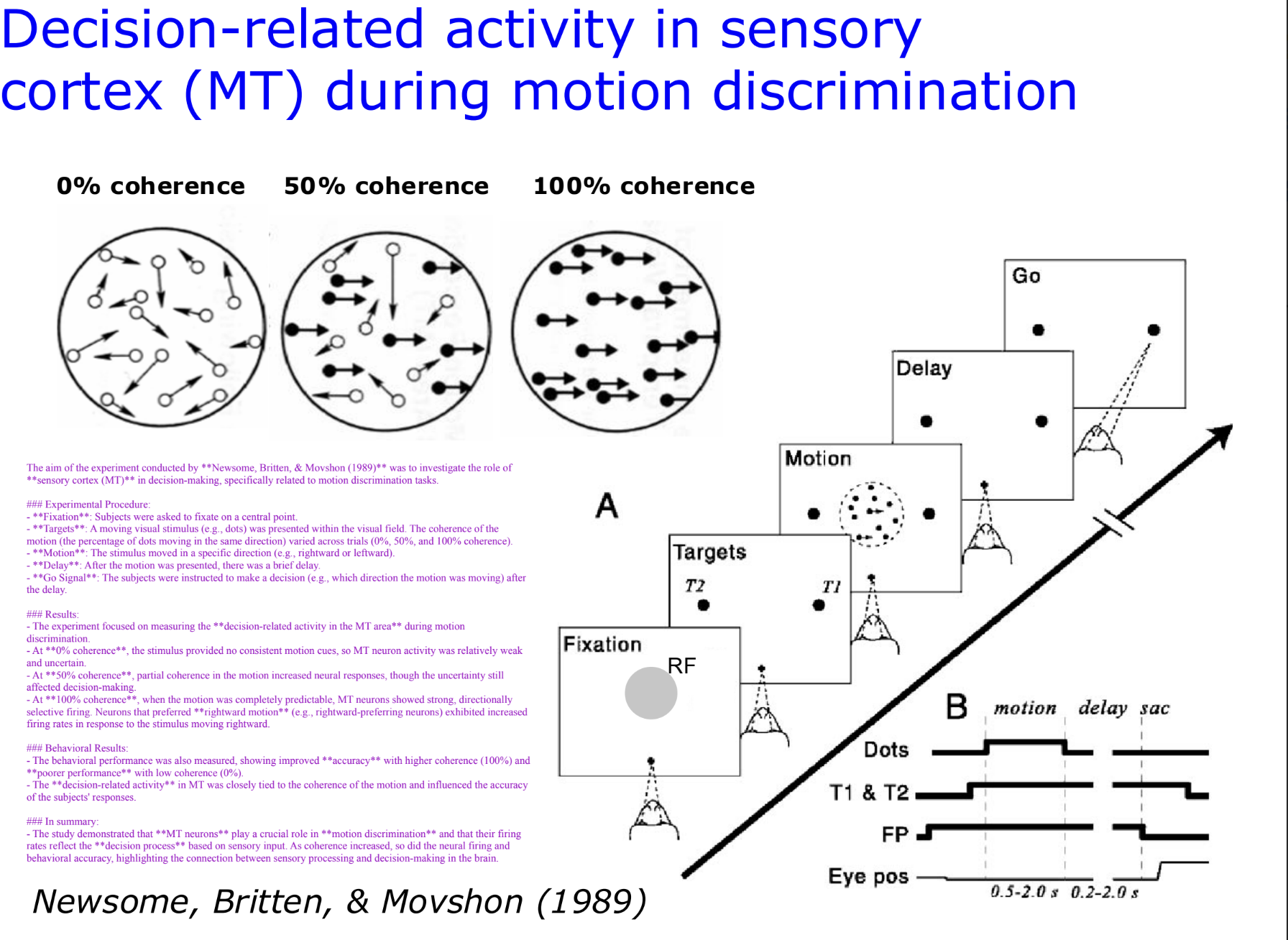
What did Newsome et al. (1989) find? (Perceptual Decision Making)
MT neurons had stronger responses at higher coherence (especially 100%).
Firing rates in direction-preferring neurons predicted motion direction decisions.
Behavioral performance improved with coherence, mirroring MT activity.

What question did Salzman, Britten, and Newsome explore in their 1990 study? (Perceptual Decision Making)
They tested whether stimulating MT neurons could bias perceptual decisions, linking neural firing rates directly to behavioral choices in a causal way.
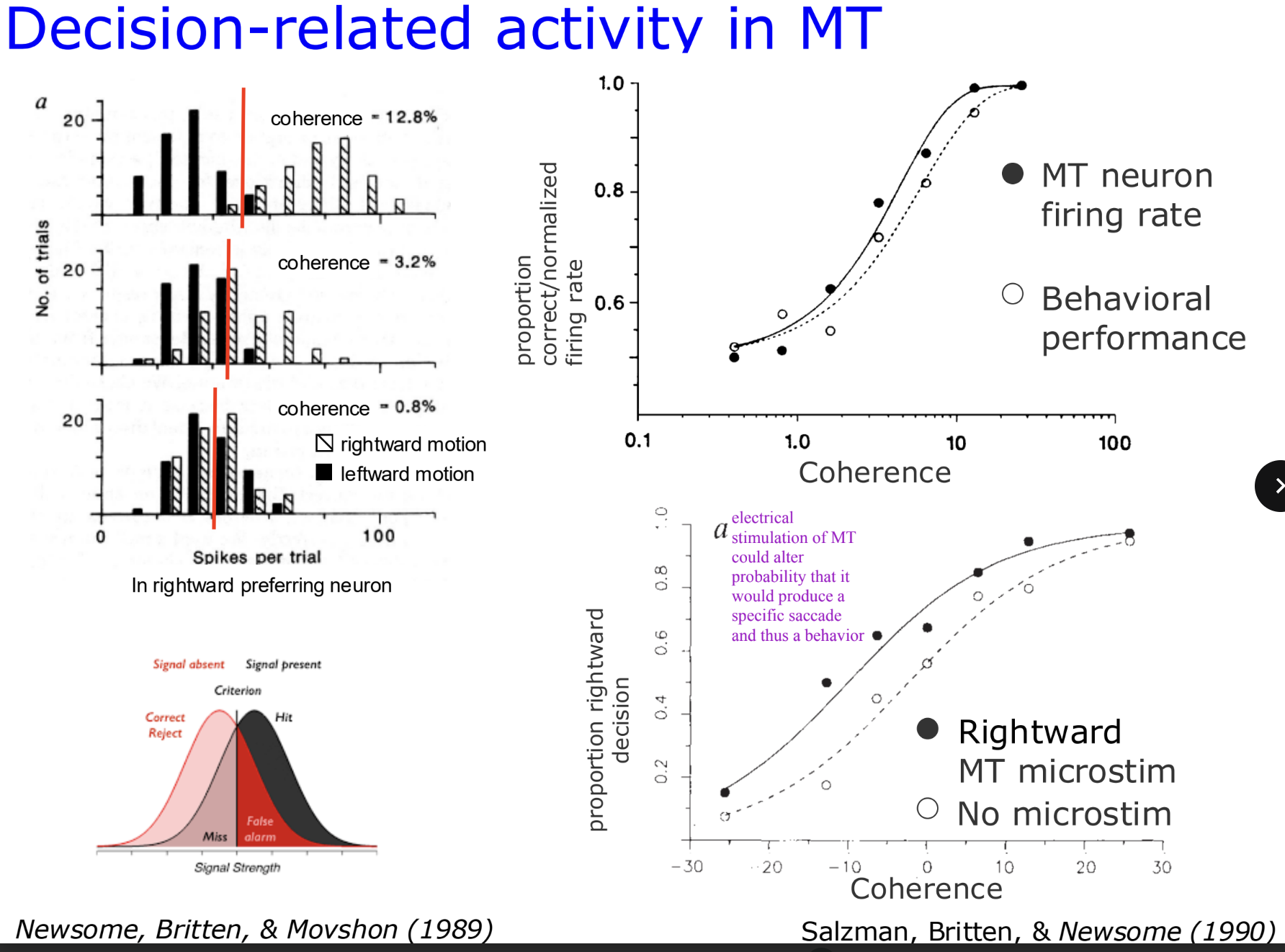
What was the method used by Salzman et al. to test decision bias in MT? (Perceptual Decision Making)
Subjects performed the same motion discrimination task.
During some trials, microstimulation was applied to MT neurons tuned to a specific direction.
The team measured how this affected behavioral choices (e.g., choosing rightward over leftward motion).
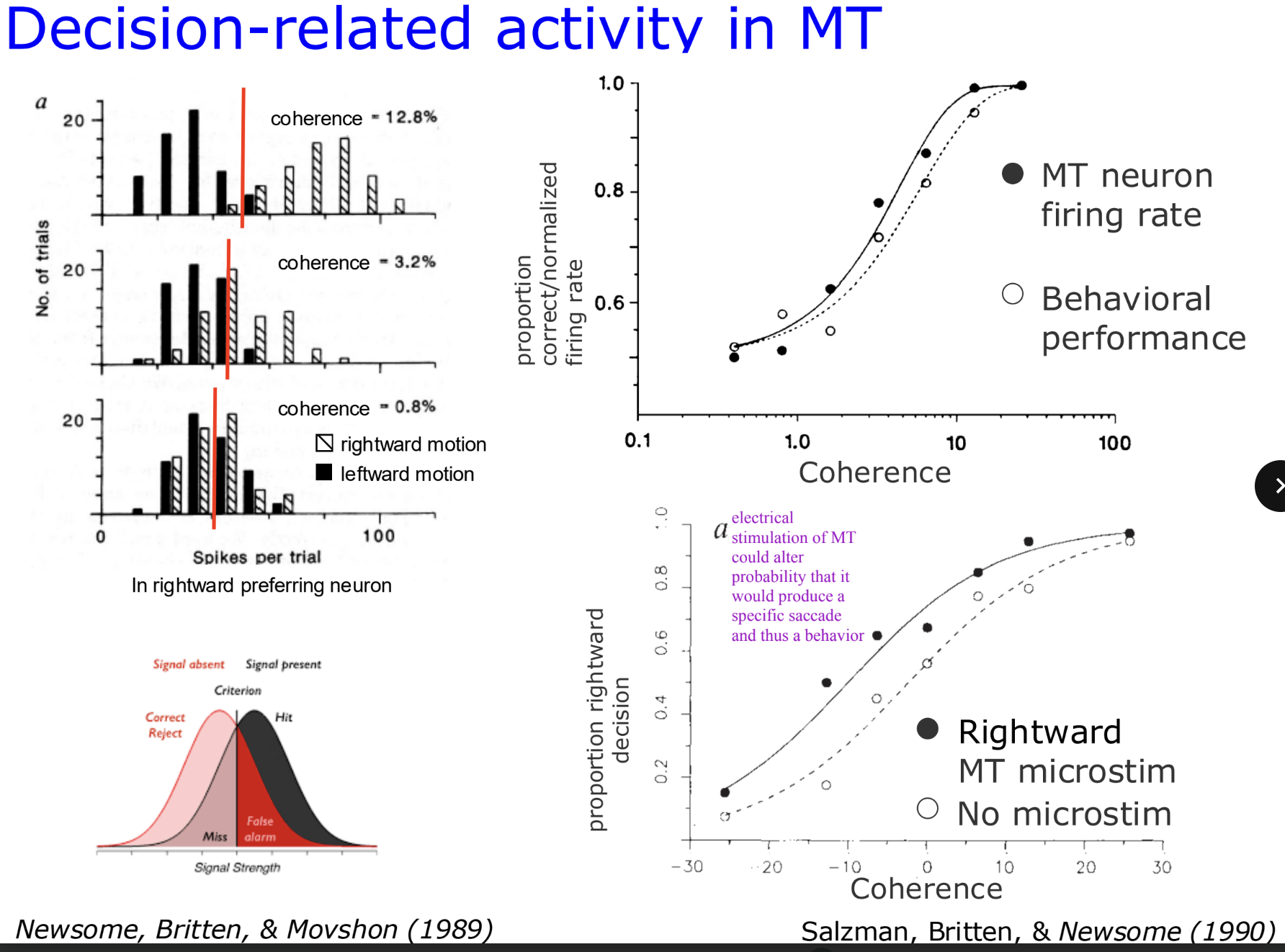
What did Salzman et al. discover about stimulating MT? (Perceptual Decision Making)
Microstimulation of direction-selective MT neurons biased decisions toward the stimulated direction.
Even when actual motion coherence was ambiguous or low, behavior reflected the bias induced by neuron activity, showing that MT contributes causally to perceptual decisions.
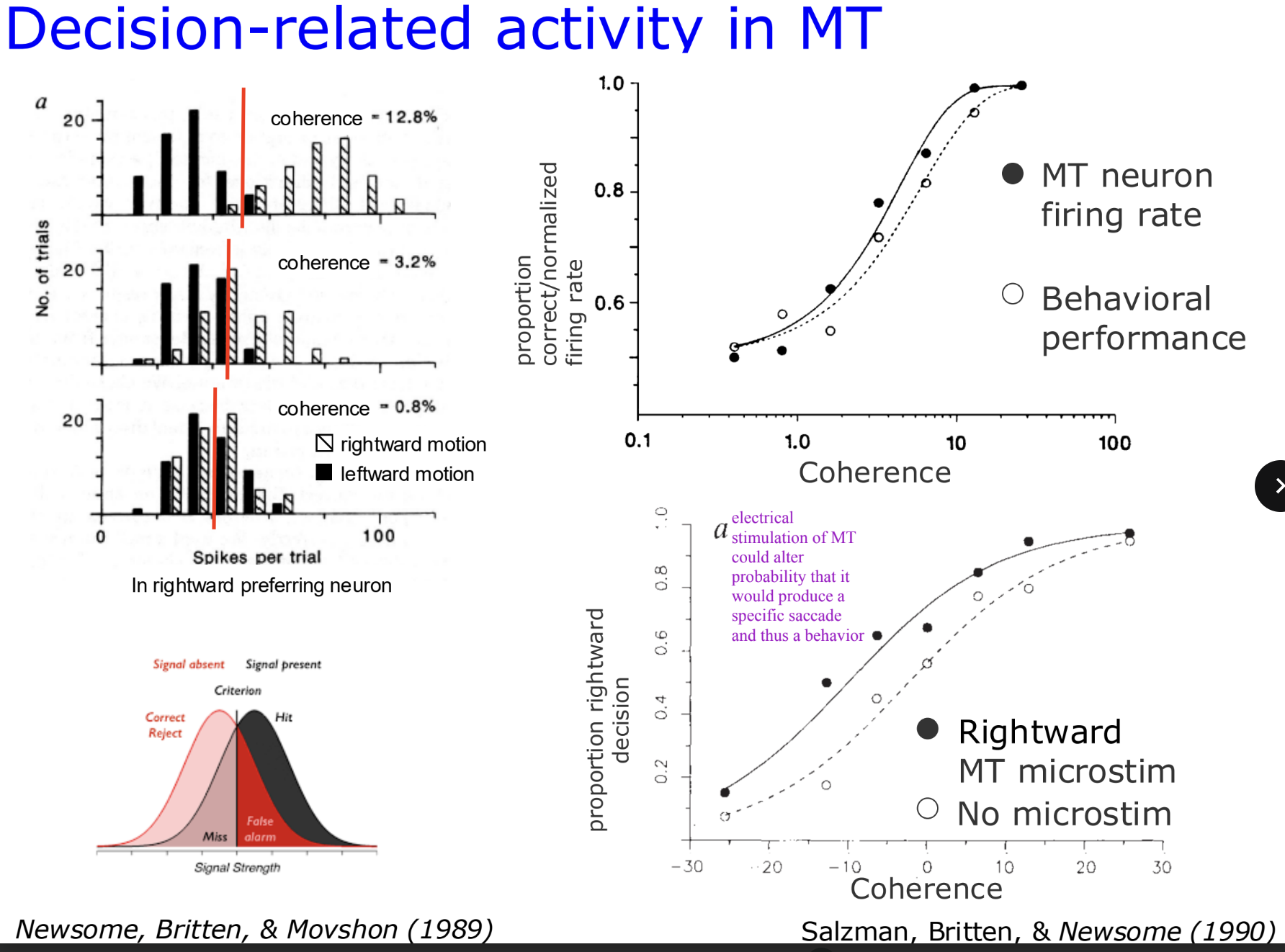
What happens during post-sensory decision-related processing in the brain? (Integrative Sensorimotor Processing)
After initial sensory processing, areas like LIP and FEF integrate that input into a decision plan. This activity reflects the evaluation of the sensory info and leads to a motor command, such as a saccade. The decision flows from MT → LIP → FEF → SC → oculomotor nuclei to execute the chosen action.
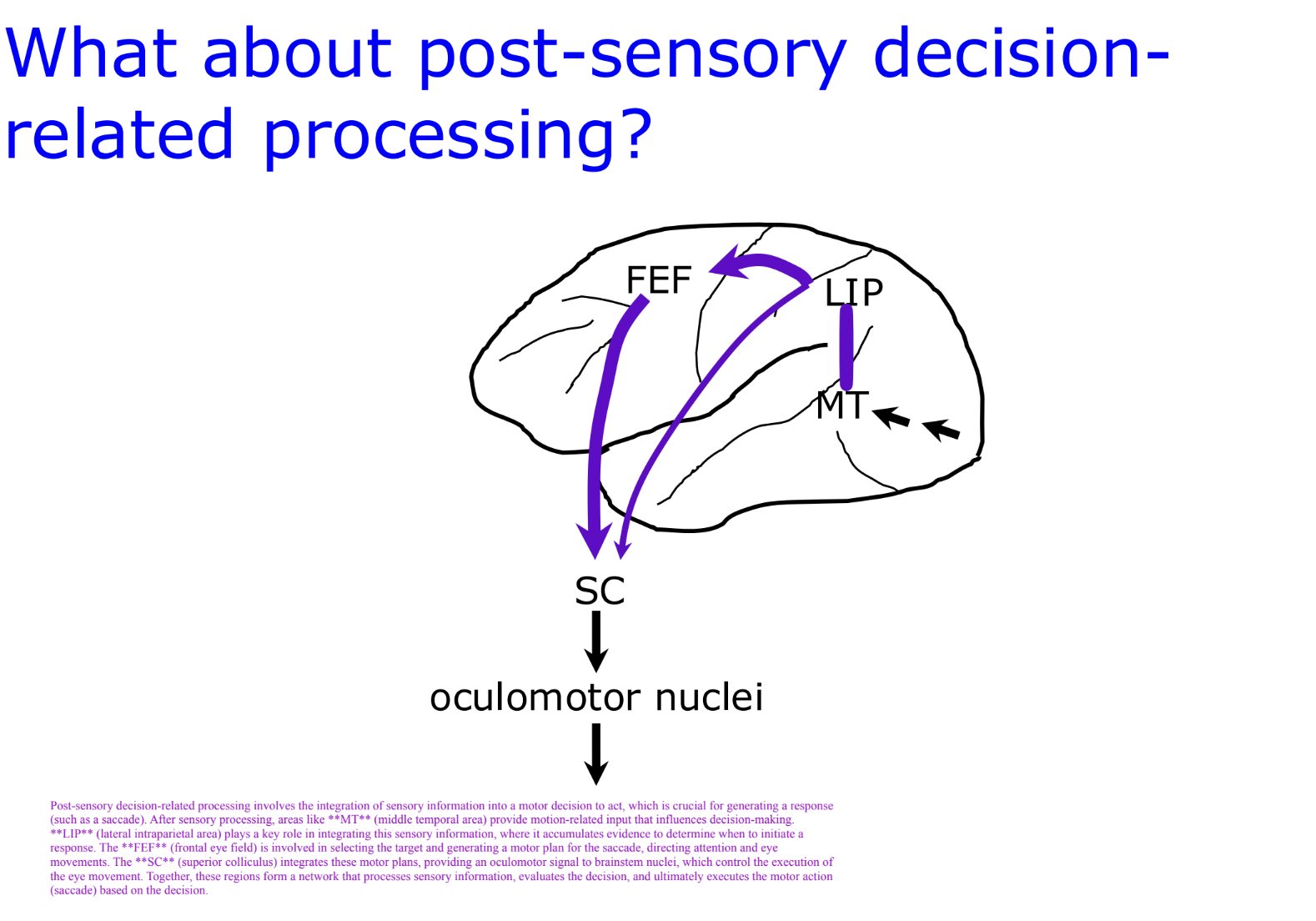
What is integrative post-sensory processing and how did researchers study it? (Integrative Sensorimotor Processing)
It's how neurons accumulate evidence from sensory input to support a decision. In a motion discrimination task, monkeys viewed moving dots with varying coherence. Researchers tracked LIP activity to see how it built up over time, leading to a saccadic decision.
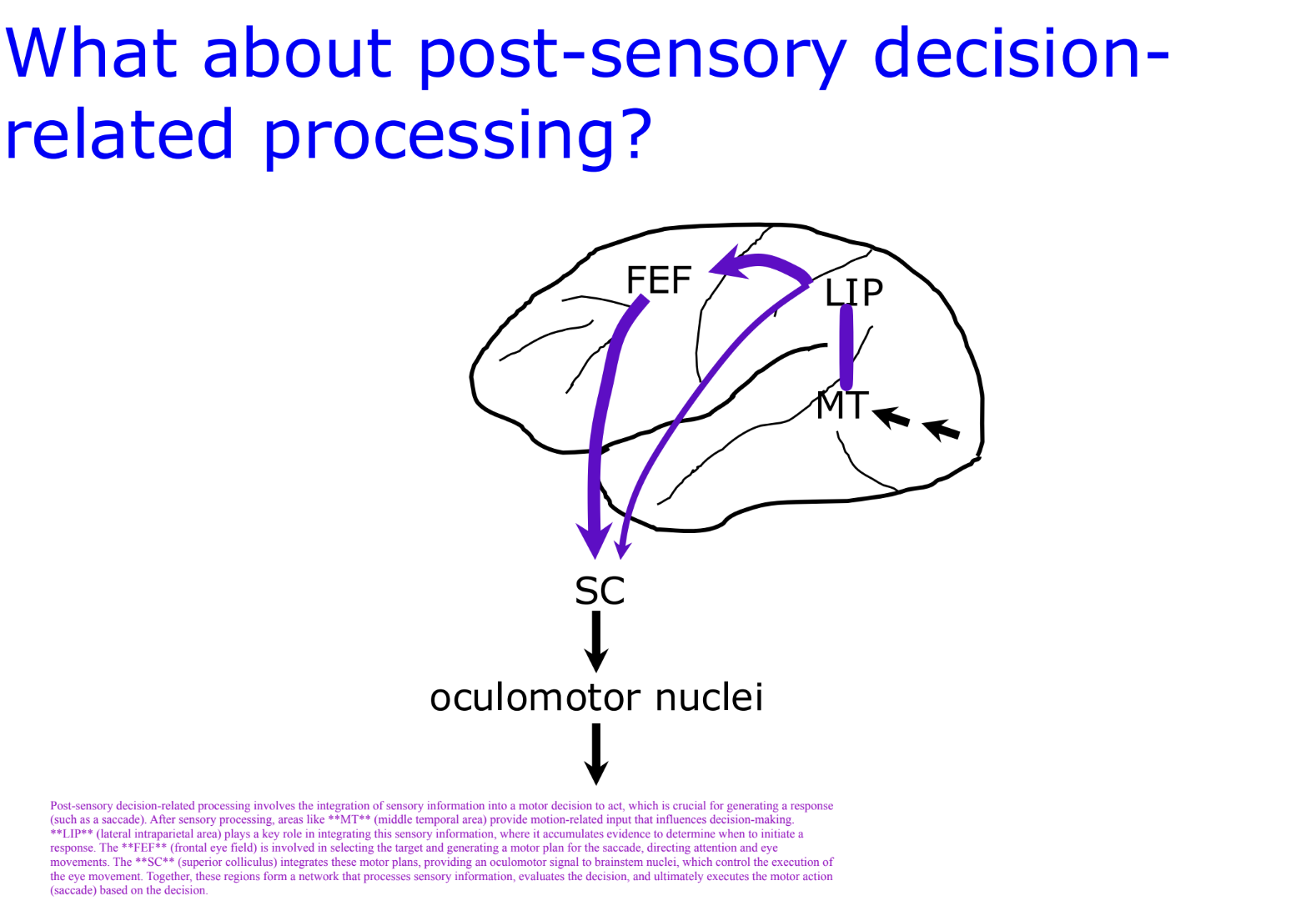
What should integrator neurons show during a motion stimulus?(Integrative Sensorimotor Processing)
Gradual increase in firing during stimulus presentation.
Rate of rise should reflect stimulus strength (higher coherence = faster rise).
Even without a clear signal (0% coherence), firing should still reflect the decision.

What determines how fast decision-related neural activity increases? (Integrative Sensorimotor Processing)
The rate of increase in activity is a function of the strength of the sensory signal—that is, the motion coherence of the stimulus. Stronger sensory evidence leads to faster accumulation and earlier decisions.
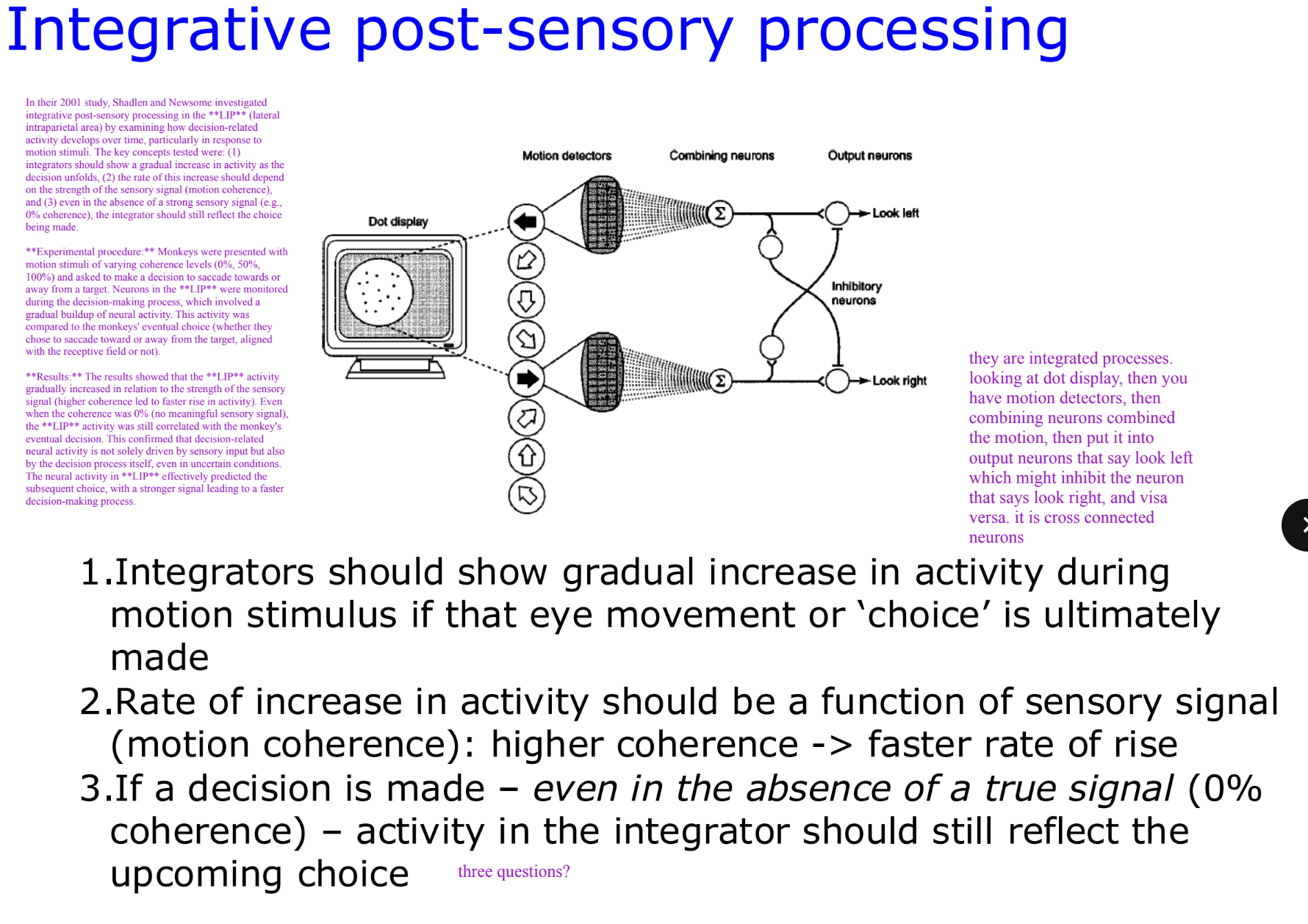
What happens in the brain once a decision is made? (Integrative Sensorimotor Processing)
Once a decision threshold is reached in areas like LIP or FEF, there’s a burst of activity, and the motor command is relayed to SC and oculomotor nuclei, triggering the corresponding eye movement (saccade).
If a decision is made—even in the absence of a true signal (0% coherence)—activity in the integrator should still reflect the upcoming choice.
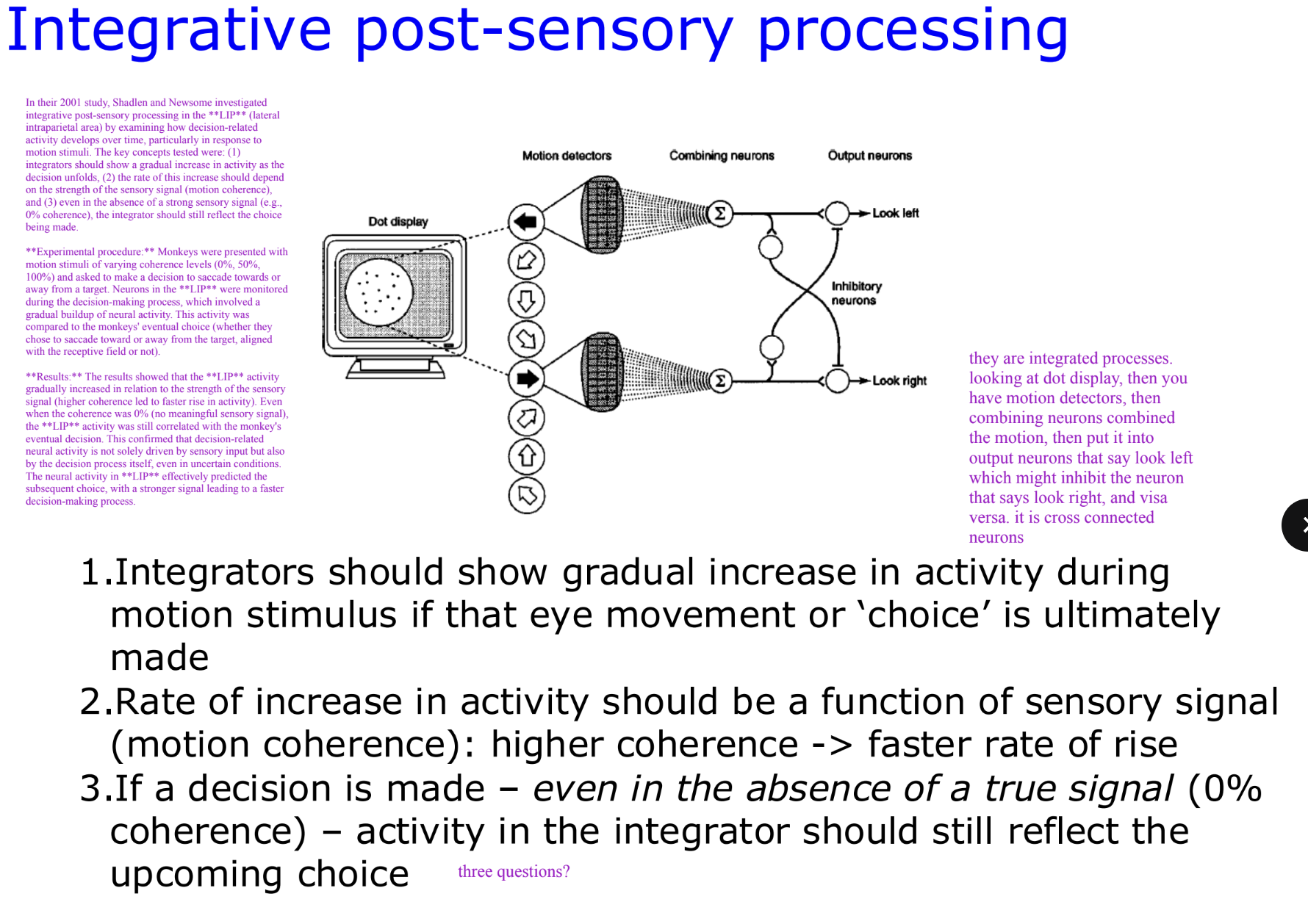
What procedure did Shadlen and Newsome use to study post-sensory decision processing? (Integrative Sensorimotor Processing)
Monkeys saw moving dot displays with varying motion coherence (0%, 50%, 100%).
They had to decide the direction of motion and make a saccade to a target.
Researchers recorded LIP neuron activity to see how it correlated with the monkey’s eventual choice.
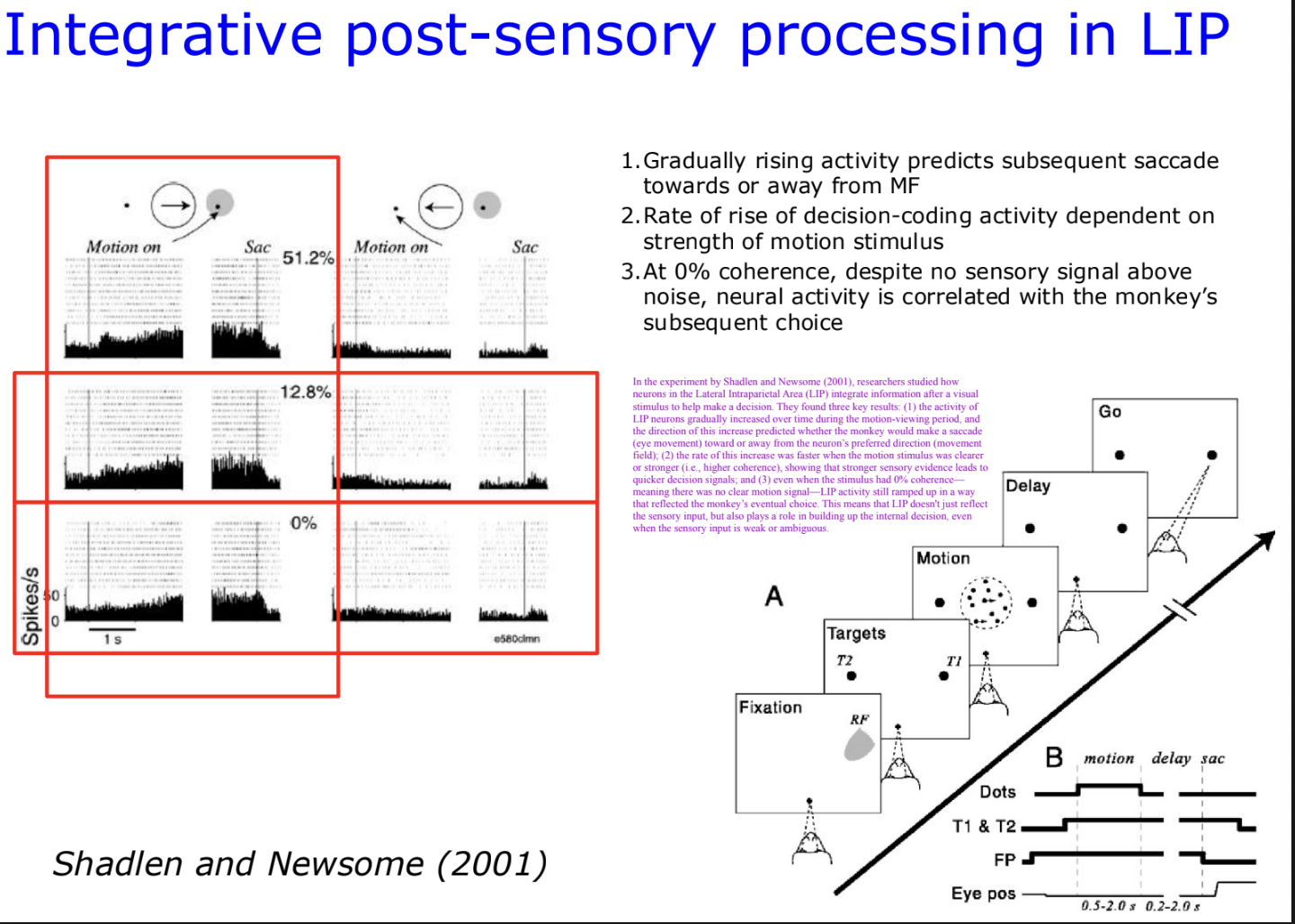
What did LIP activity reveal about decision-making in the experiment? (Integrative Sensorimotor Processing)
LIP neurons showed gradually increasing firing rates during the motion viewing period. This activity predicted the monkey’s choice, rising faster when the motion signal was stronger.

What influenced how fast LIP activity rose in the experiment? (Integrative Sensorimotor Processing)
The motion coherence level. Higher coherence caused a faster buildup of LIP activity, meaning the brain made a clearer decision more quickly.
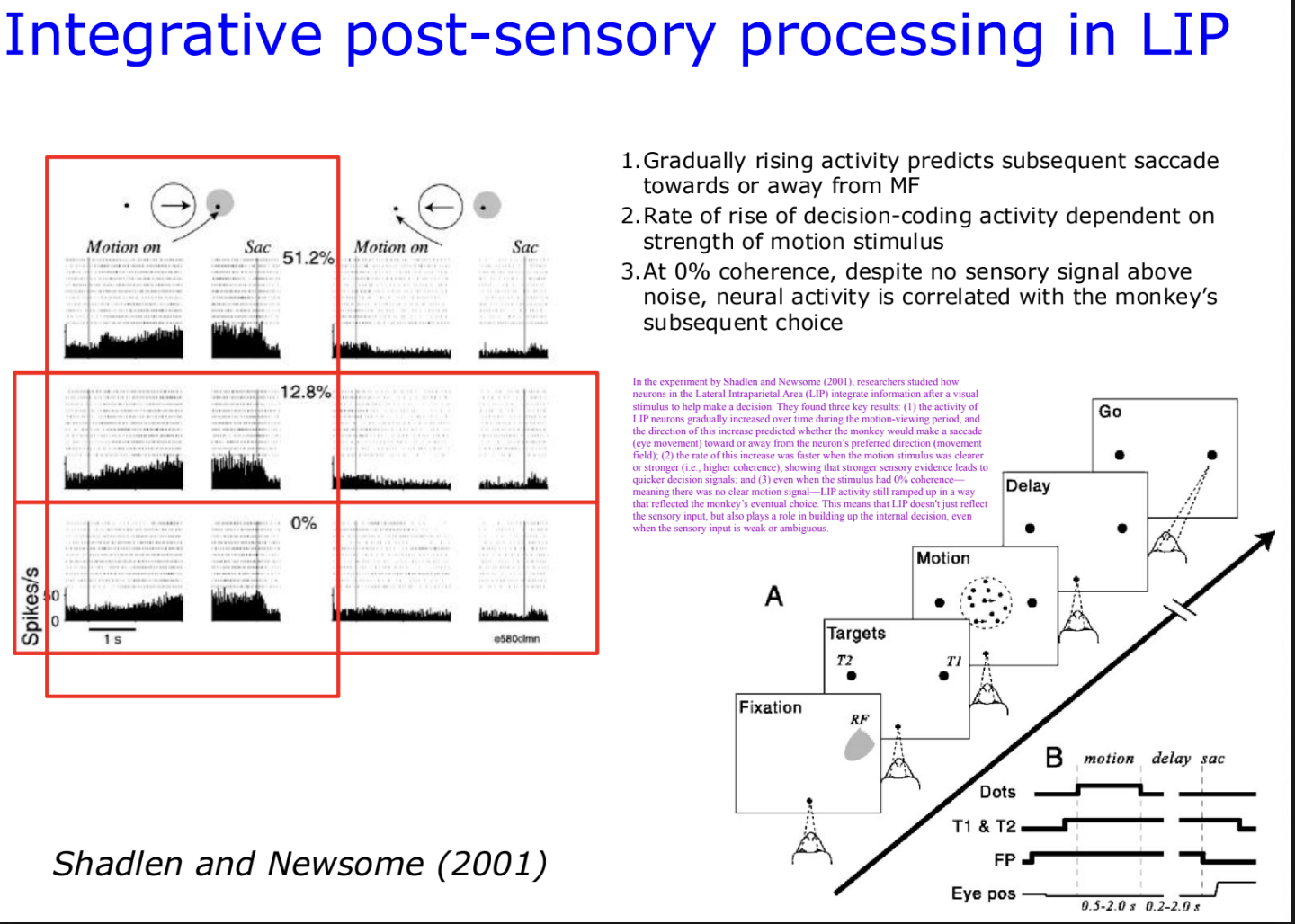
What did LIP neurons do when there was no clear motion signal (0% coherence)? ((Integrative Sensorimotor Processing)
Even with no consistent motion, LIP activity still ramped up and predicted the monkey's choice, showing that decision signals can arise even in ambiguous conditions—reflecting internal decision dynamics, not just sensory input.

What were the main findings from Shadlen & Newsome’s LIP study? (Integrative Sensorimotor Processing)
Gradual rise in LIP activity predicted saccadic choice.
Rate of rise depended on motion coherence.
At 0% coherence, activity still reflected the upcoming decision.
Confirmed LIP as a site of evidence accumulation, not just sensory reflection.
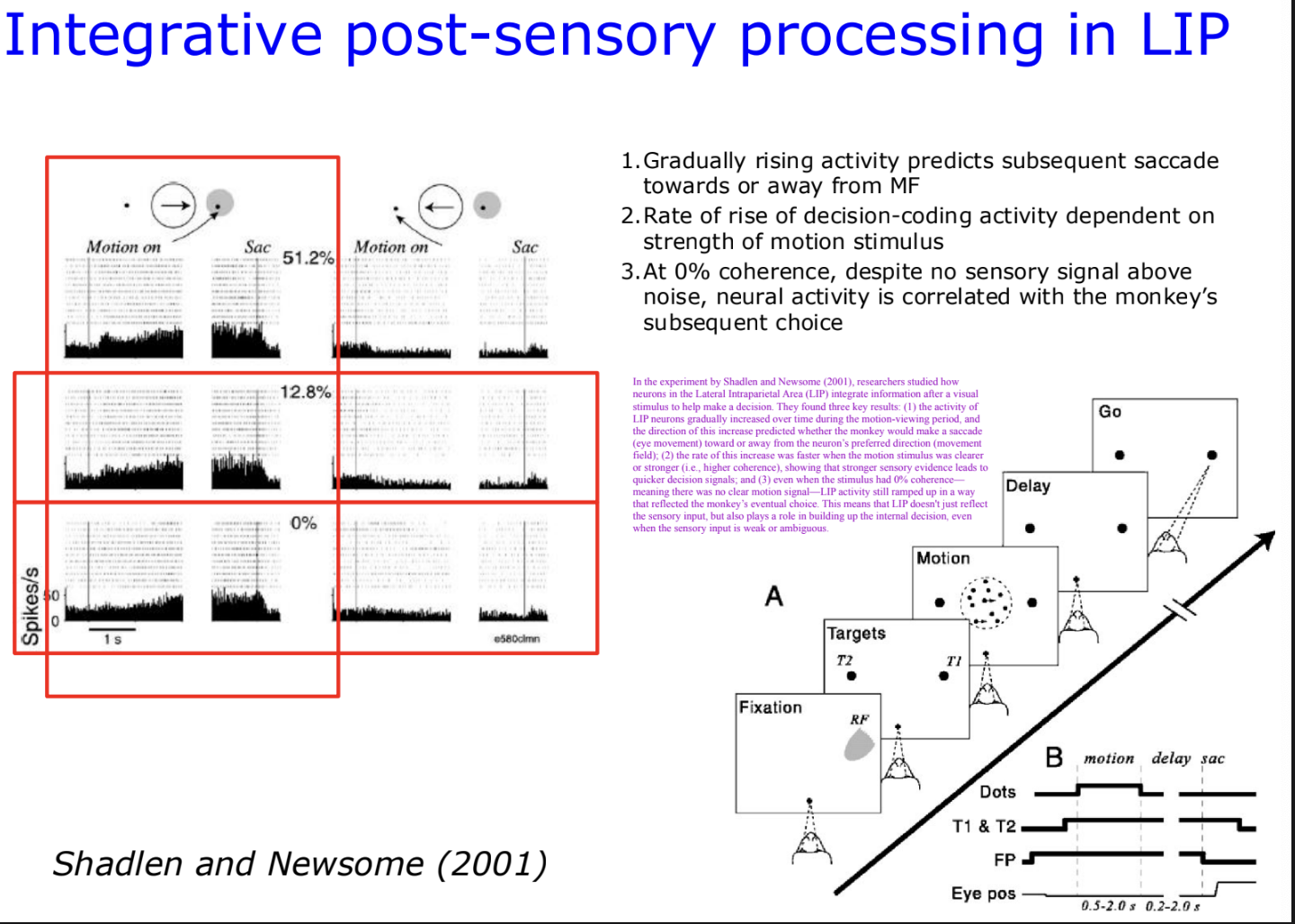
How does neural decision activity influence action selection? (Target selection and reaction times)
Decision-related activity in areas like MT, LIP, and FEF leads to the selection of saccadic targets. As evidence accumulates, activity ramps up until a threshold is reached, triggering motor execution via SC and oculomotor nuclei.
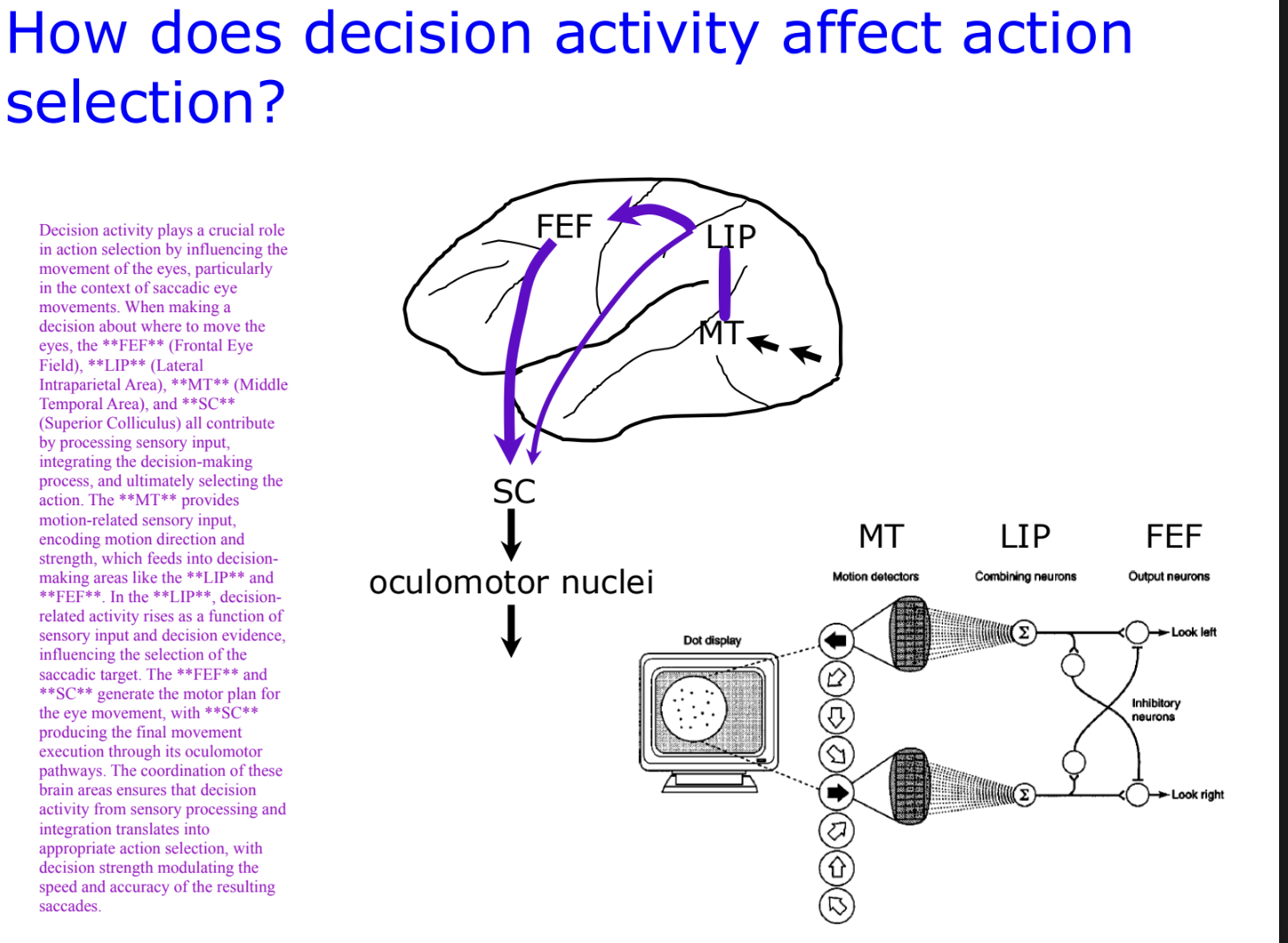
How do MT, LIP, and FEF interact in saccadic decision-making? (Target selection and reaction times)
MT = motion detector (direction/speed of movement)
LIP = combining neuron (accumulates and integrates motion evidence)
FEF = output neuron (initiates eye movement by reaching threshold), with inhibition across competing motor plans (e.g., look left vs. right).

How does decision activity in FEF relate to action selection? (Target selection and reaction times)
According to Thompson & Schall (1996), FEF neurons ramp up in activity until they reach a threshold, at which point a saccade is executed. This neural ramping reflects accumulating evidence favoring a specific action.
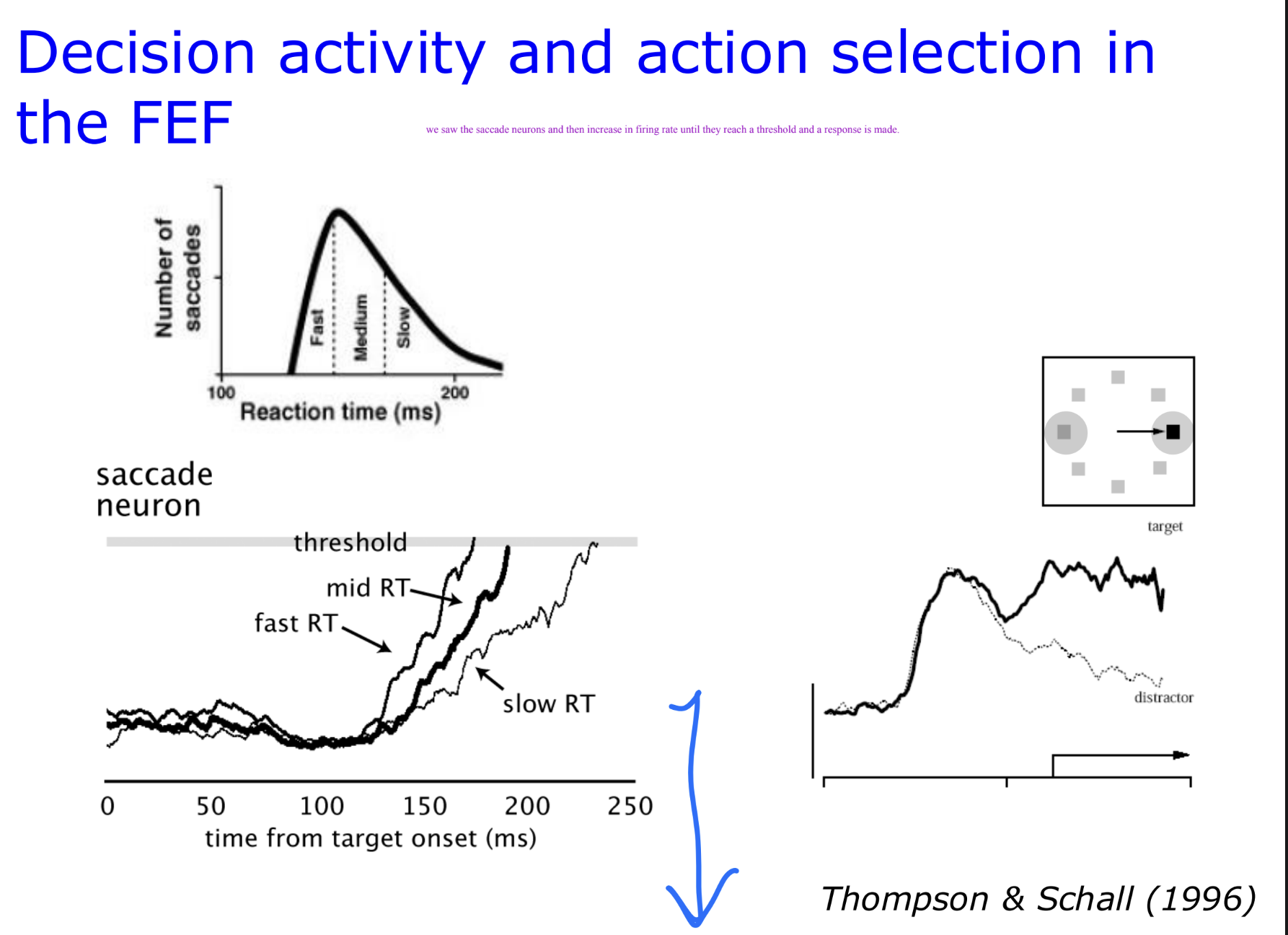
What does the Drift Diffusion Model explain? (Target selection and reaction times)
The DDM models evidence accumulation over time for decision-making. It involves drift (direction of evidence) and diffusion (random noise), where decisions occur once a threshold is crossed.

What is the DDM evidence for? (Target selection and reaction times)
It supports the idea that decisions emerge gradually via accumulated evidence. Faster, more accurate choices happen with strong signals; slower, more variable ones occur with weak or noisy inputs.
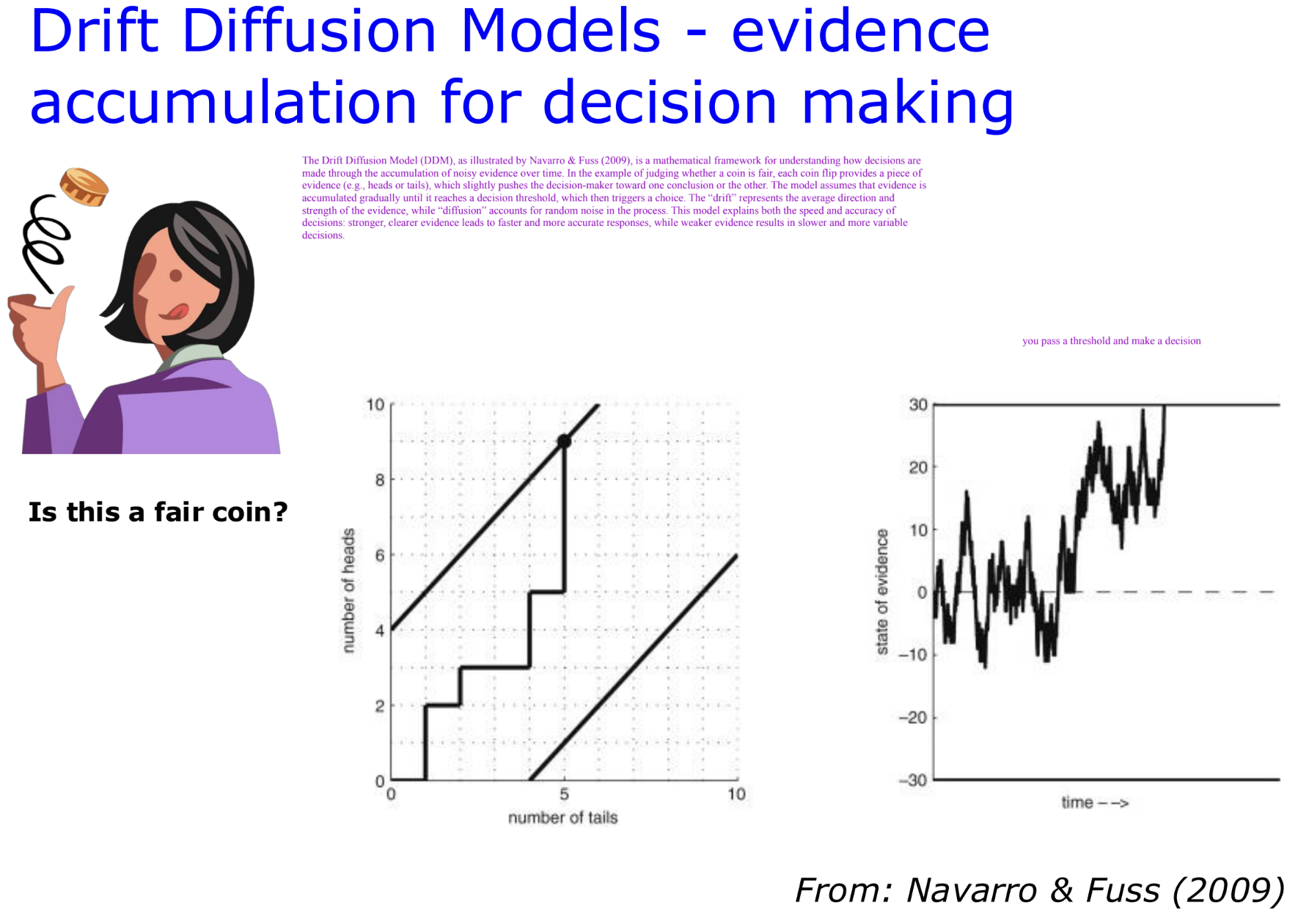
How does the Drift Diffusion Model apply to the fair coin example? (Target selection and reaction times)
Each flip is a noisy signal (e.g., head or tail). You gradually accumulate a count of outcomes. Once the accumulated "evidence" (e.g., more heads than expected) reaches a threshold, you decide the coin is biased or fair.
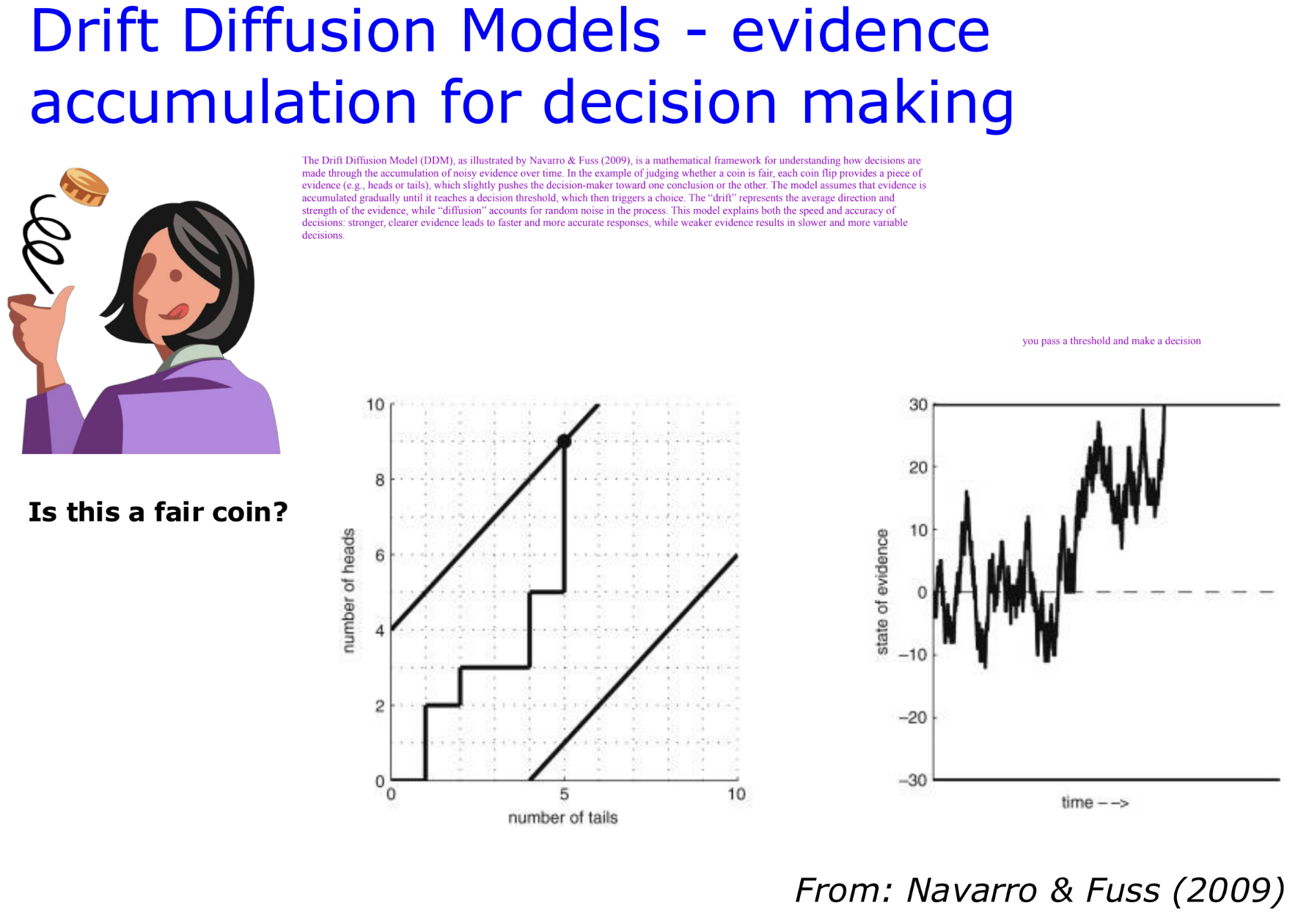
What was the goal of the auditory decision task with rats and humans? (Target selection and reaction times)
To study how evidence is accumulated over time in a decision task. They tested whether decision-making relied more on memory noise or evidence noise, using auditory clicks presented from two sides.
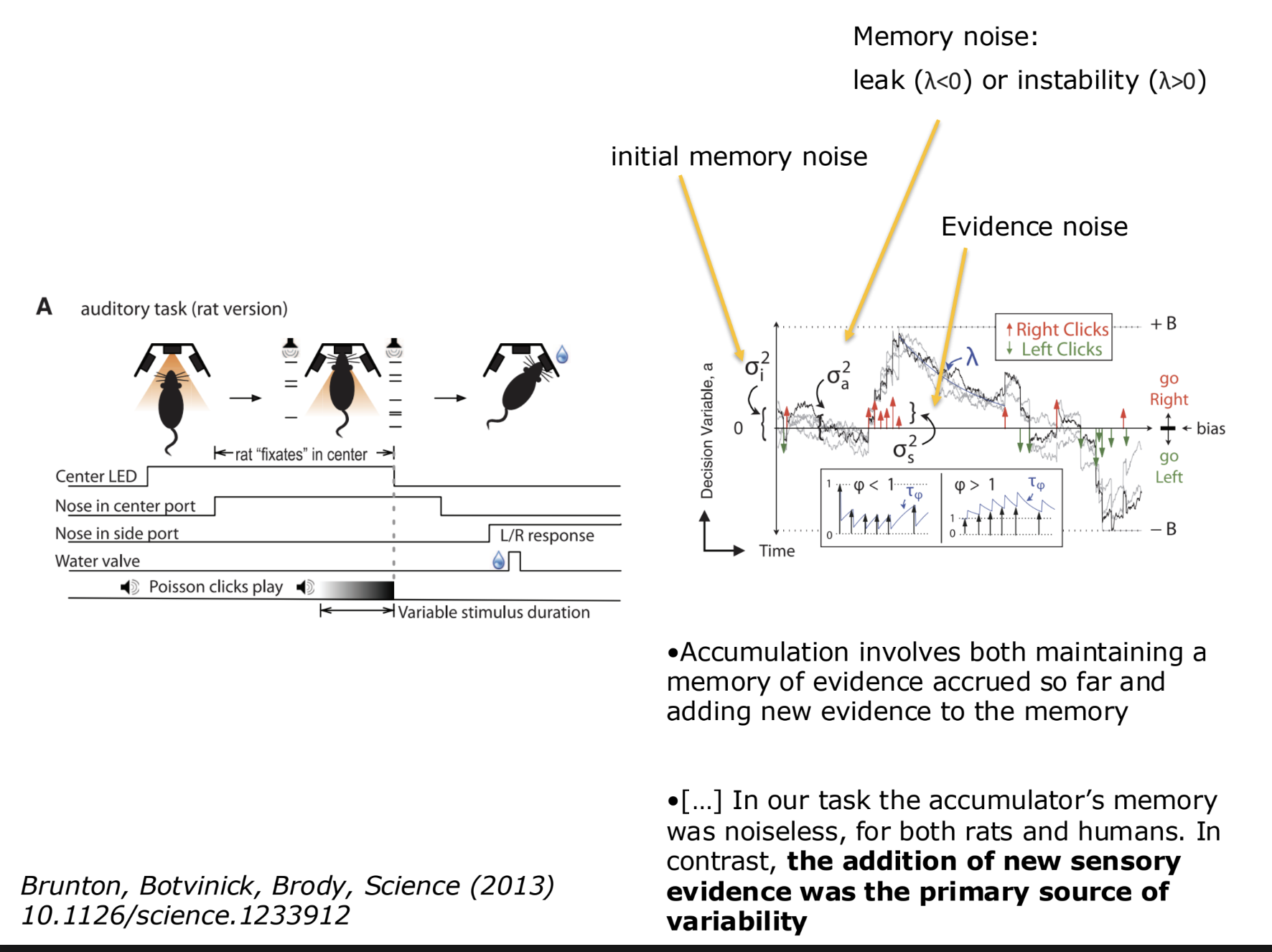
What is memory noise in the rat experiment? (Target selection and reaction times)
It refers to the variability or interference in the recall of past outcomes, which can affect decision-making.
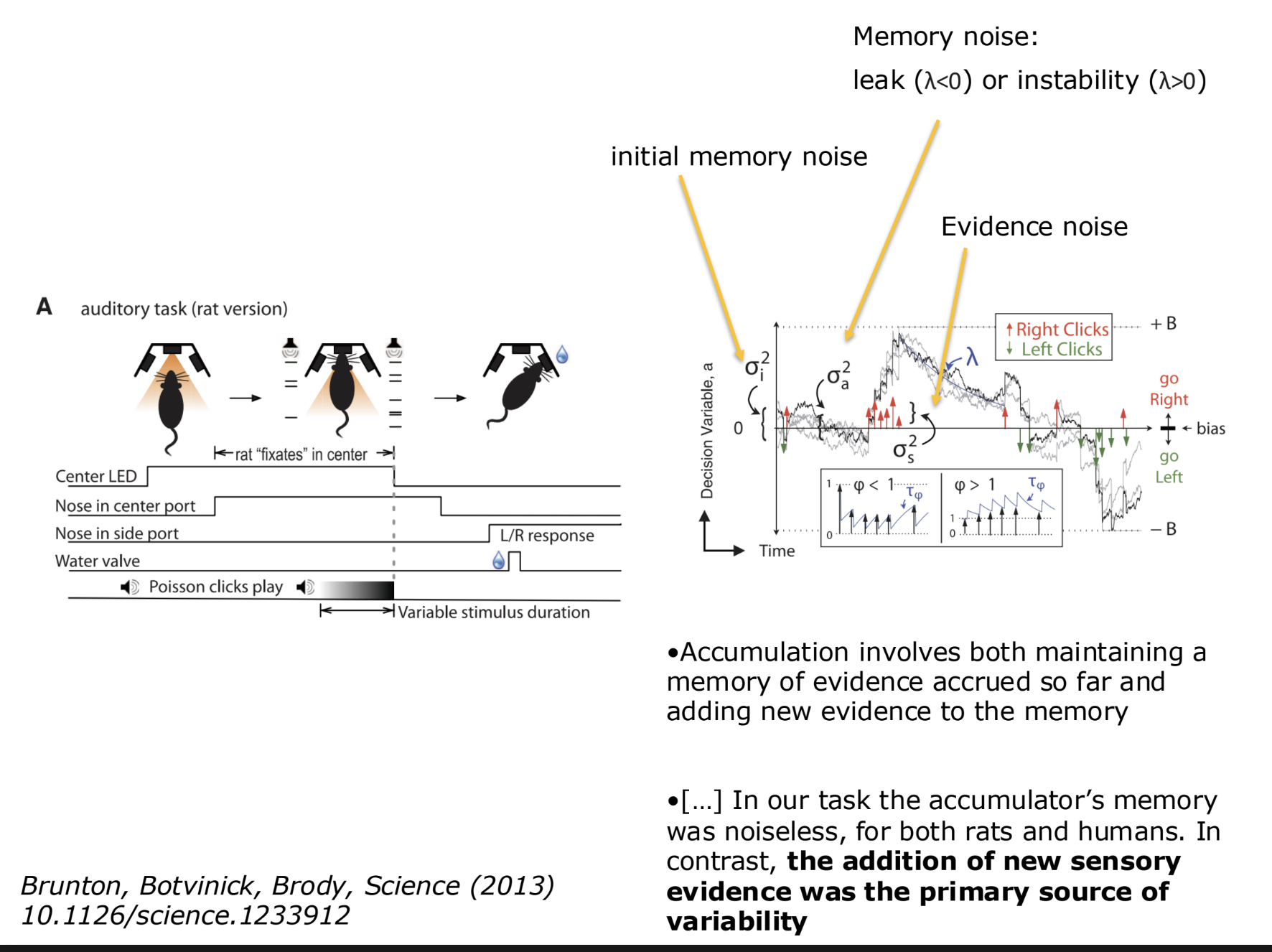
What was the method used in the Brunton, Botvinick & Brody experiment? (Target selection and reaction times)
A rat was positioned with its nose in a center port.
Poisson-distributed clicks were played from left and right.
After the trial, the rat chose the side with more clicks by moving to the side water valve.
Human subjects performed a similar version.
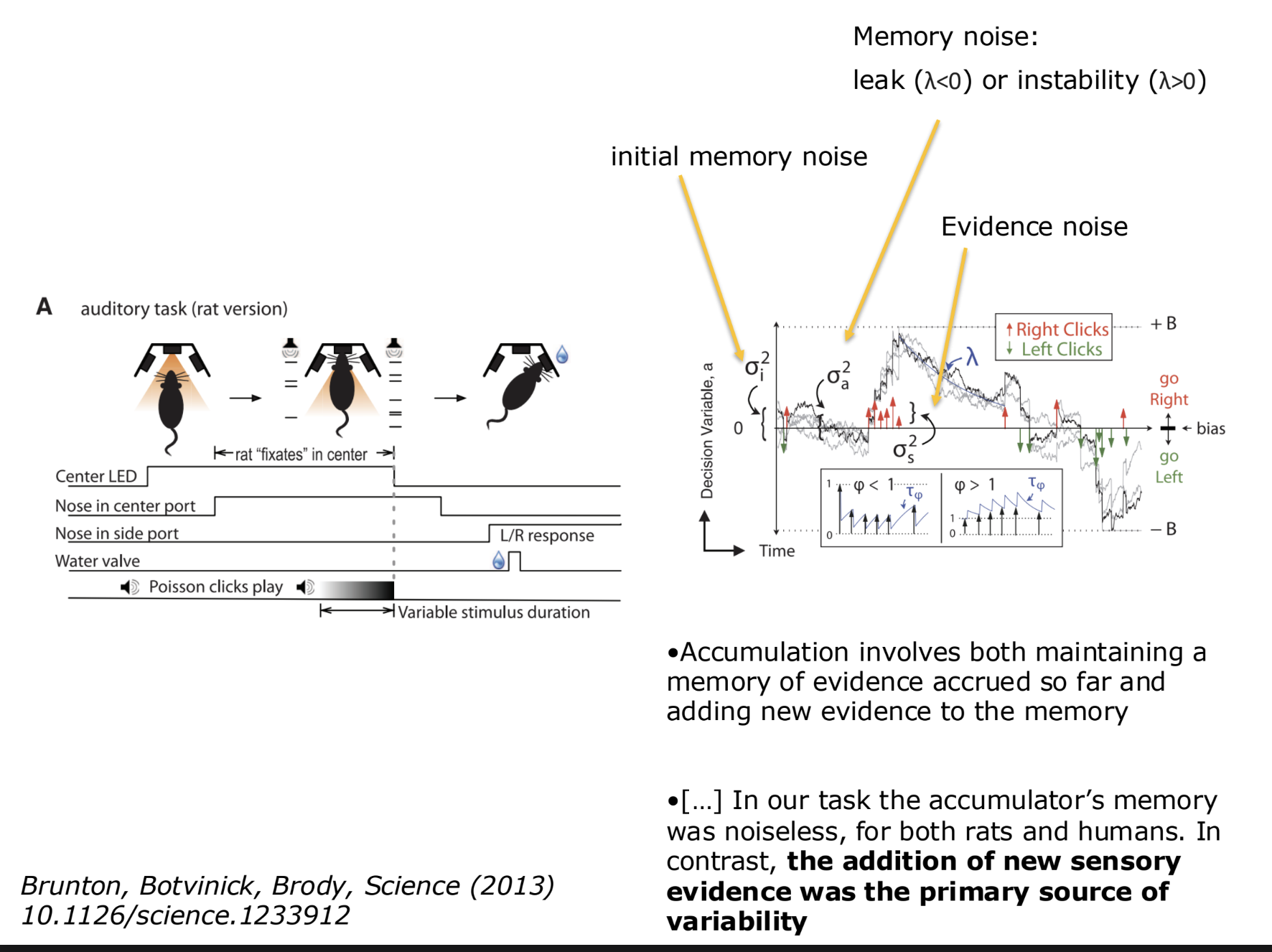
What did Brunton et al. find about memory and evidence noise? (Target selection and reaction times)
Memory of accumulated evidence was noiseless.
The main variability in decisions came from sensory evidence noise—each new click added uncertainty.
Memory noise (leak or instability) was not a major factor.

What is meant by accumulation in decision-making? (Target selection and reaction times)
Accumulation involves both holding past evidence in memory and adding new sensory input. A stable accumulation process allows for decisions based on the totality of evidence over time.
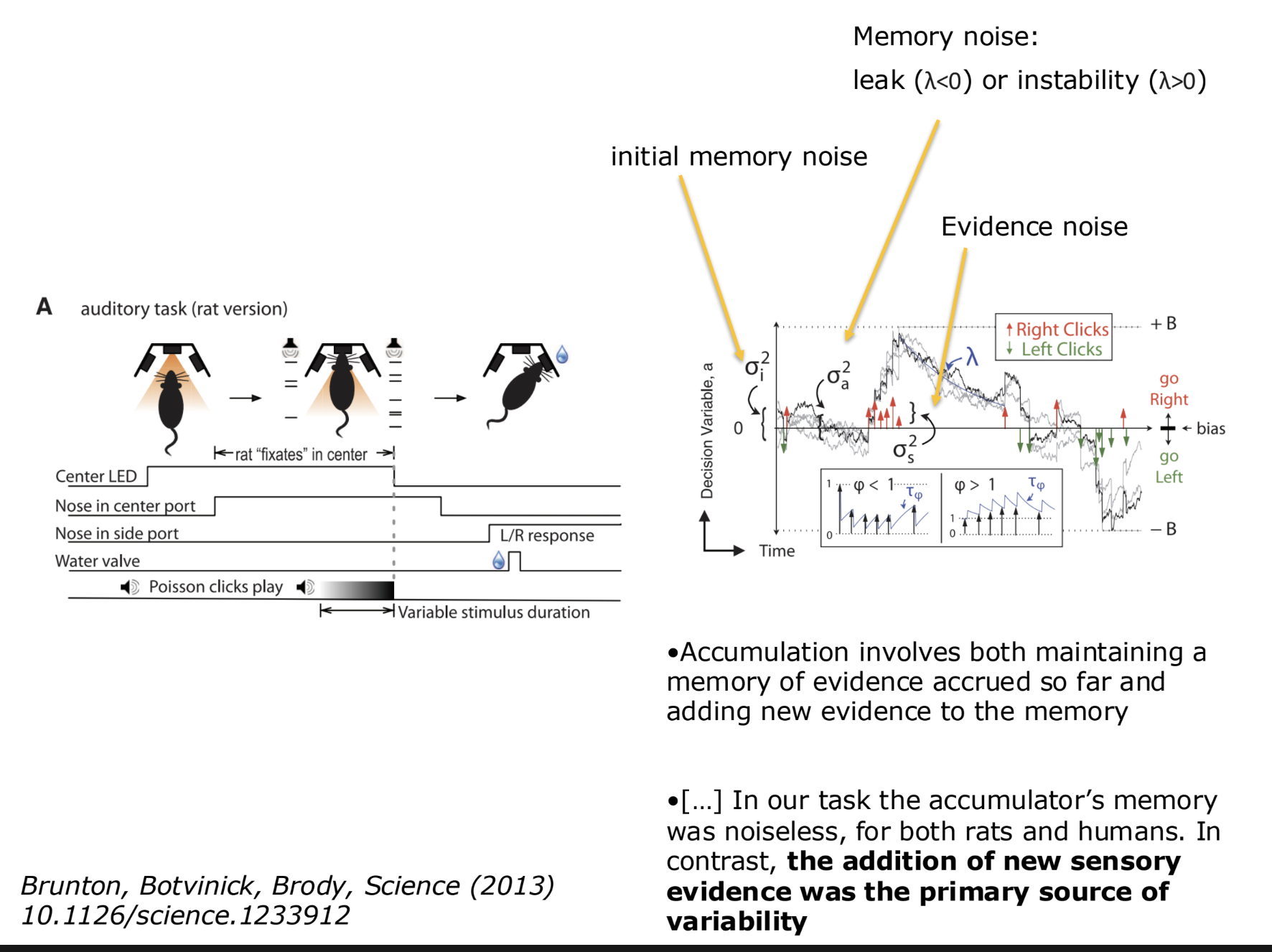
What caused most of the decision variability in Brunton et al.'s task? (Target selection and reaction times)
The addition of new sensory evidence (i.e., each click) was the primary source of noise, not the memory of previously accumulated clicks.
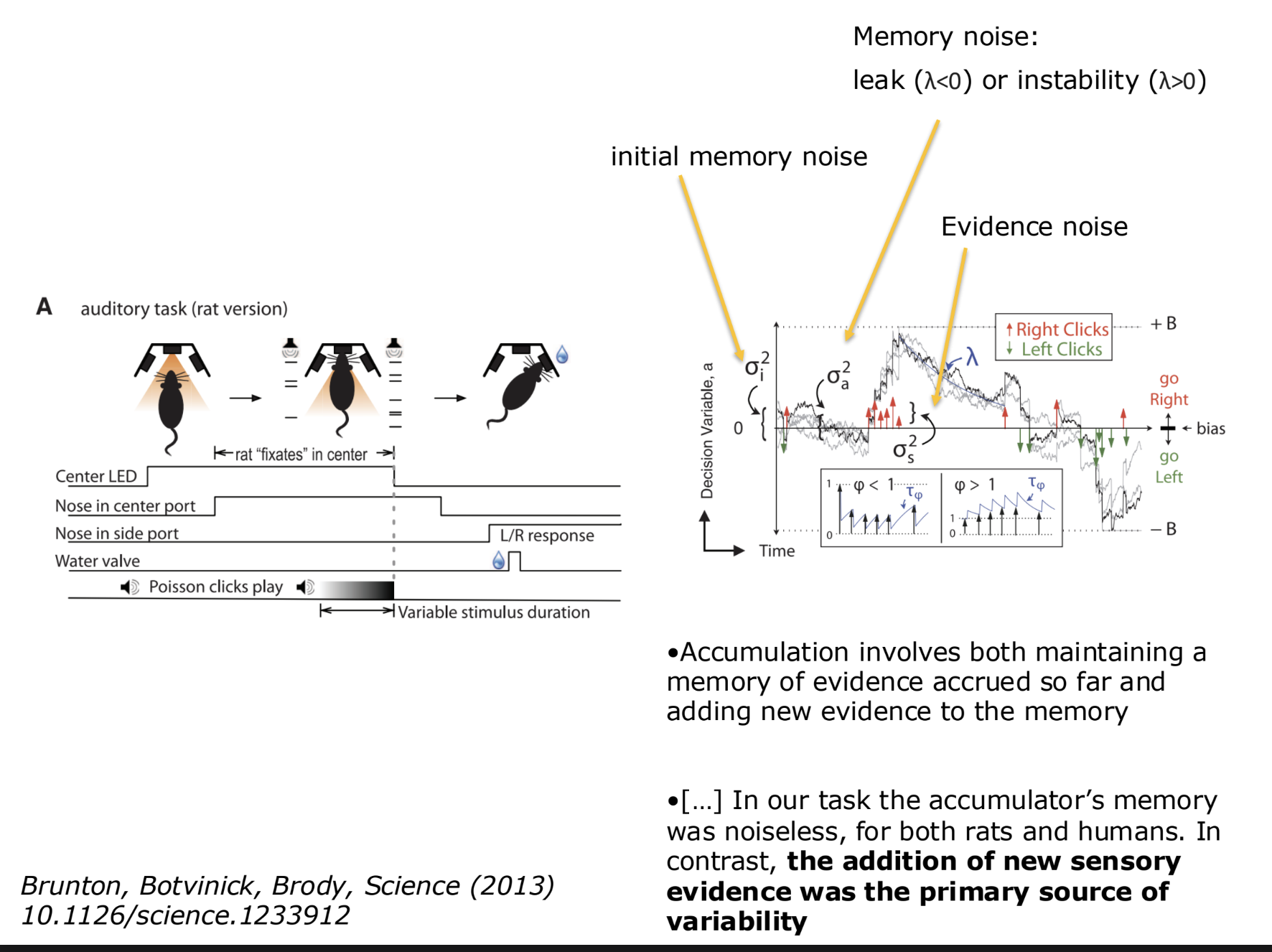
What defines a complex decision in neuroscience? (Target selection and reaction times)
A complex decision involves multiple factors that each contribute probabilistically to the final outcome. These decisions require evaluating and integrating different elements over time, making the process more nuanced than simple stimulus-response choices.
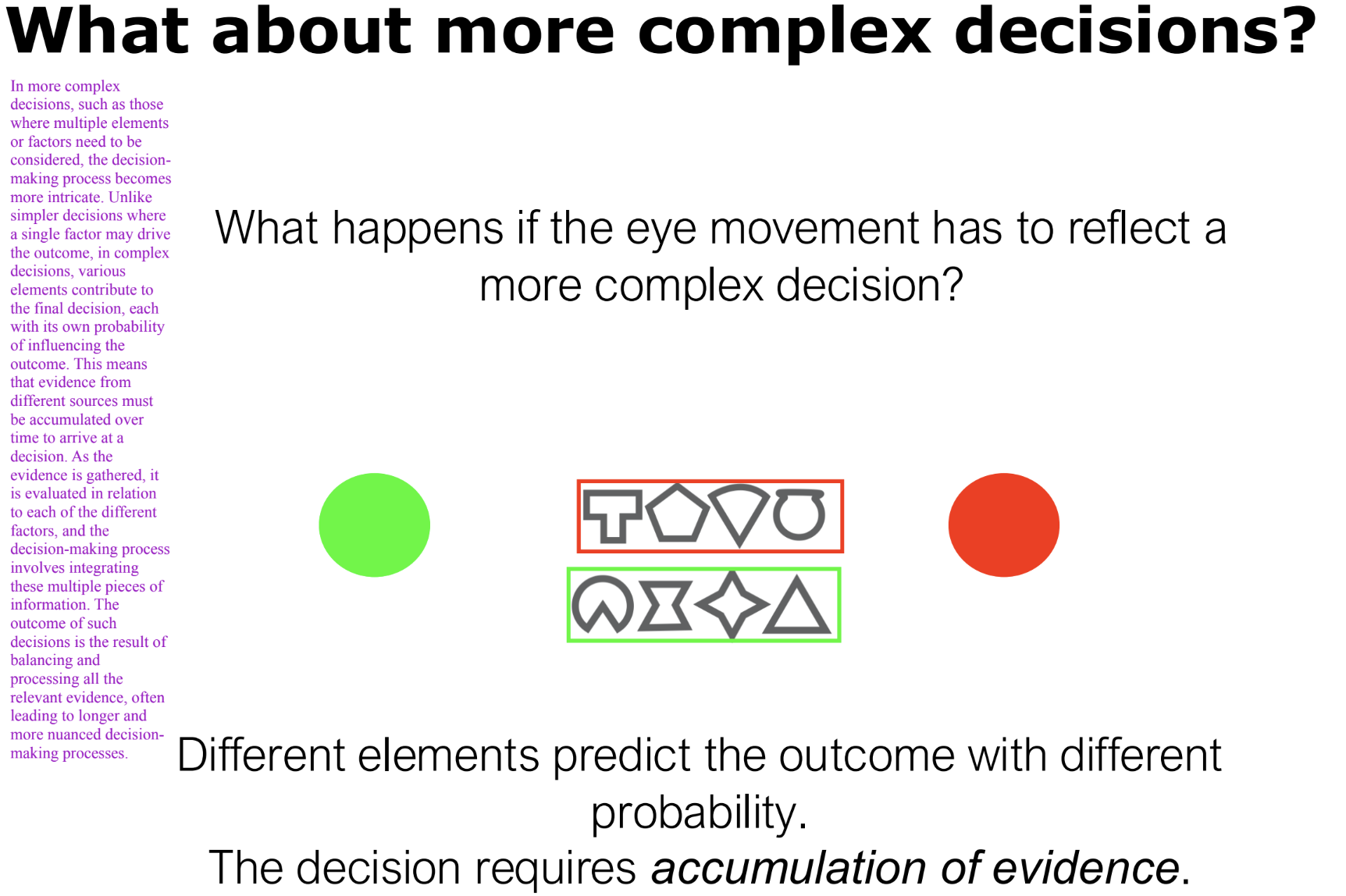
How does a saccadic eye movement change if the underlying decision is complex? (Target selection and reaction times)
The eye movement will reflect a slower, more integrated process. It requires the brain to accumulate and weigh evidence from multiple sources before committing to a movement, leading to delayed or more deliberate saccades.
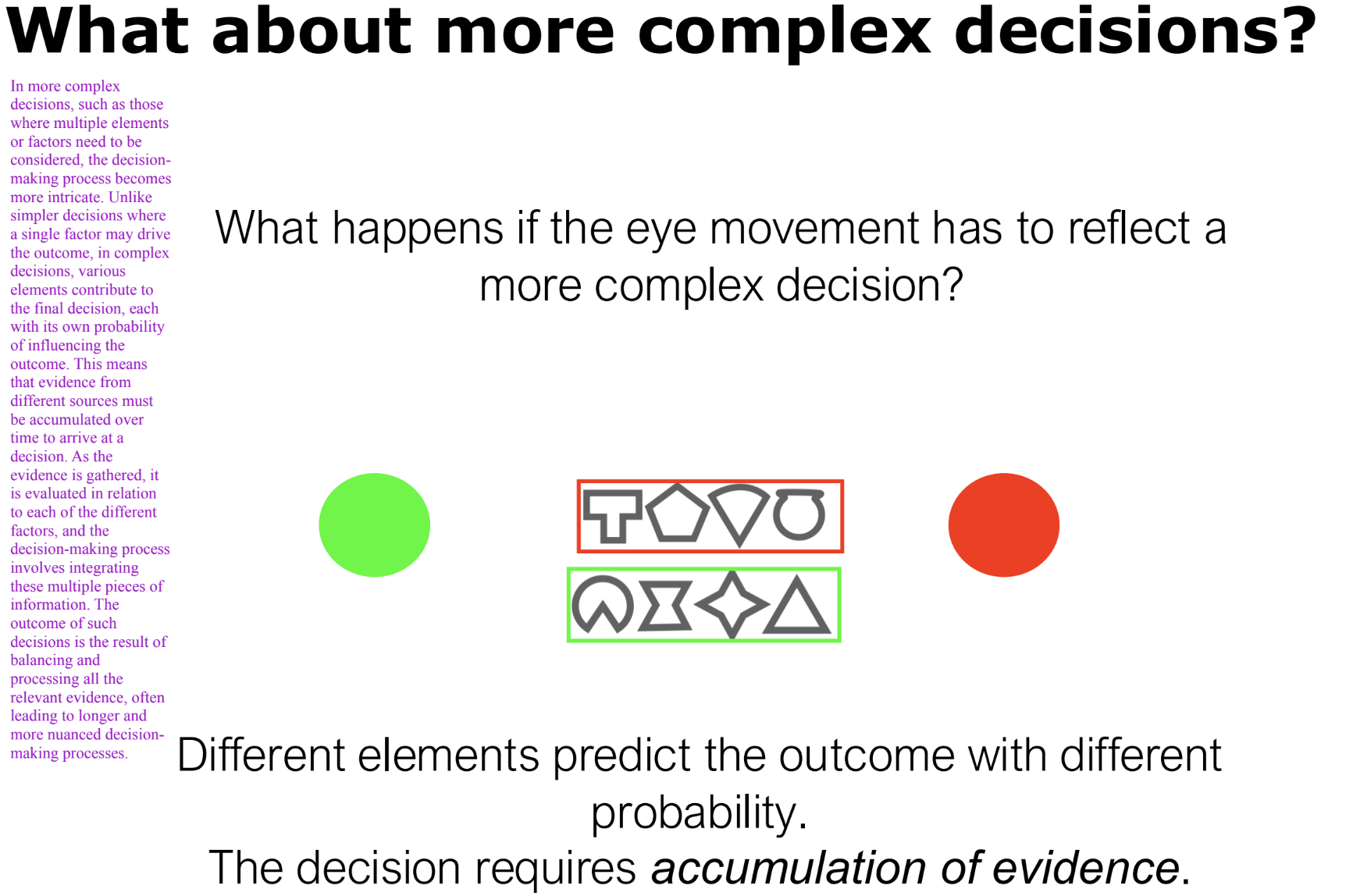
How do different elements contribute to a complex decision? (Target selection and reaction times)
Each element or cue predicts the decision outcome with different probabilities. The brain must assess the reliability of each and combine them to guide the final choice.
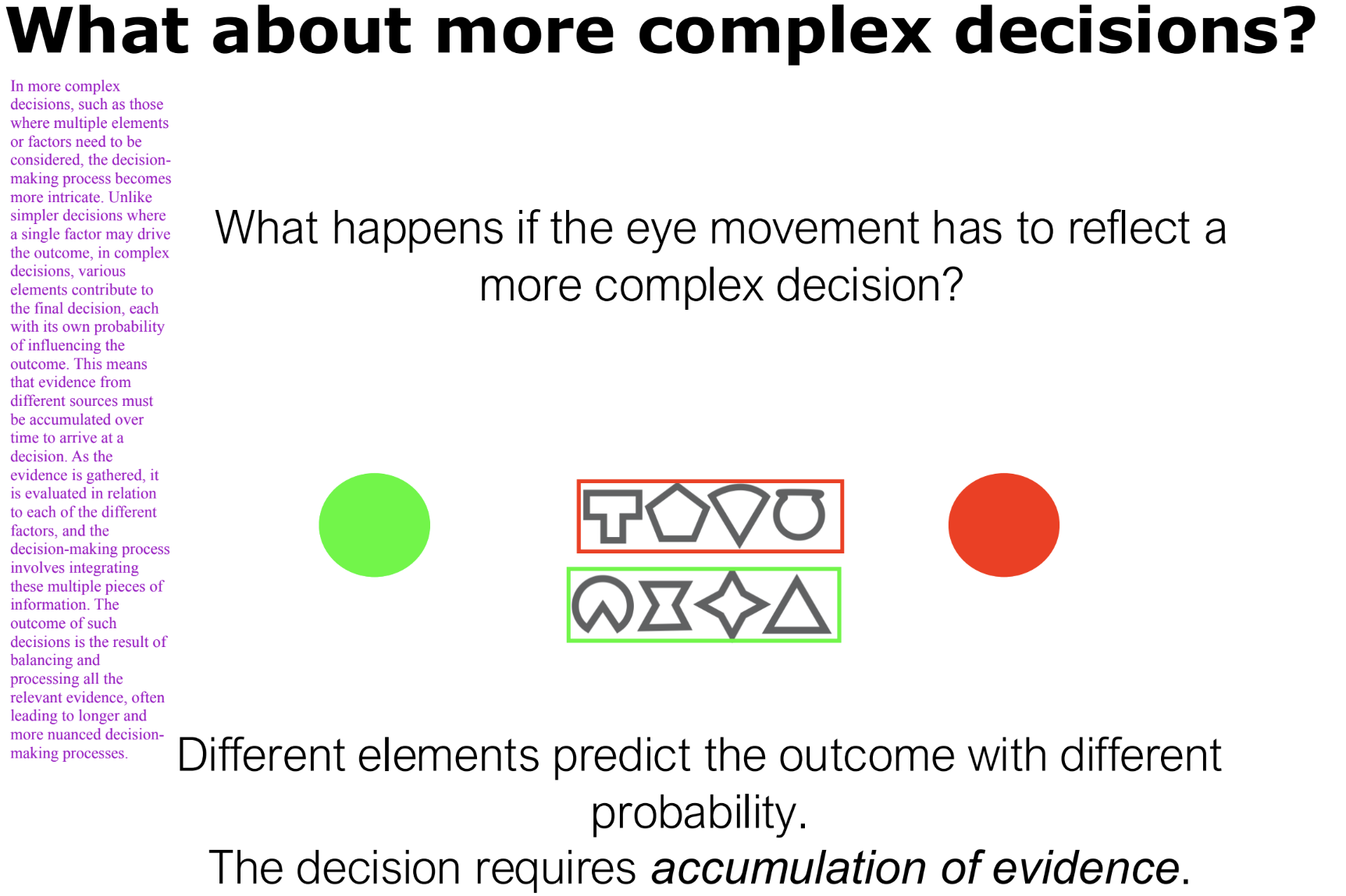
What is required for making a complex decision? (Target selection and reaction times)
Complex decisions require the accumulation of evidence from various sources over time, along with the integration of each piece's relative importance or predictive value.
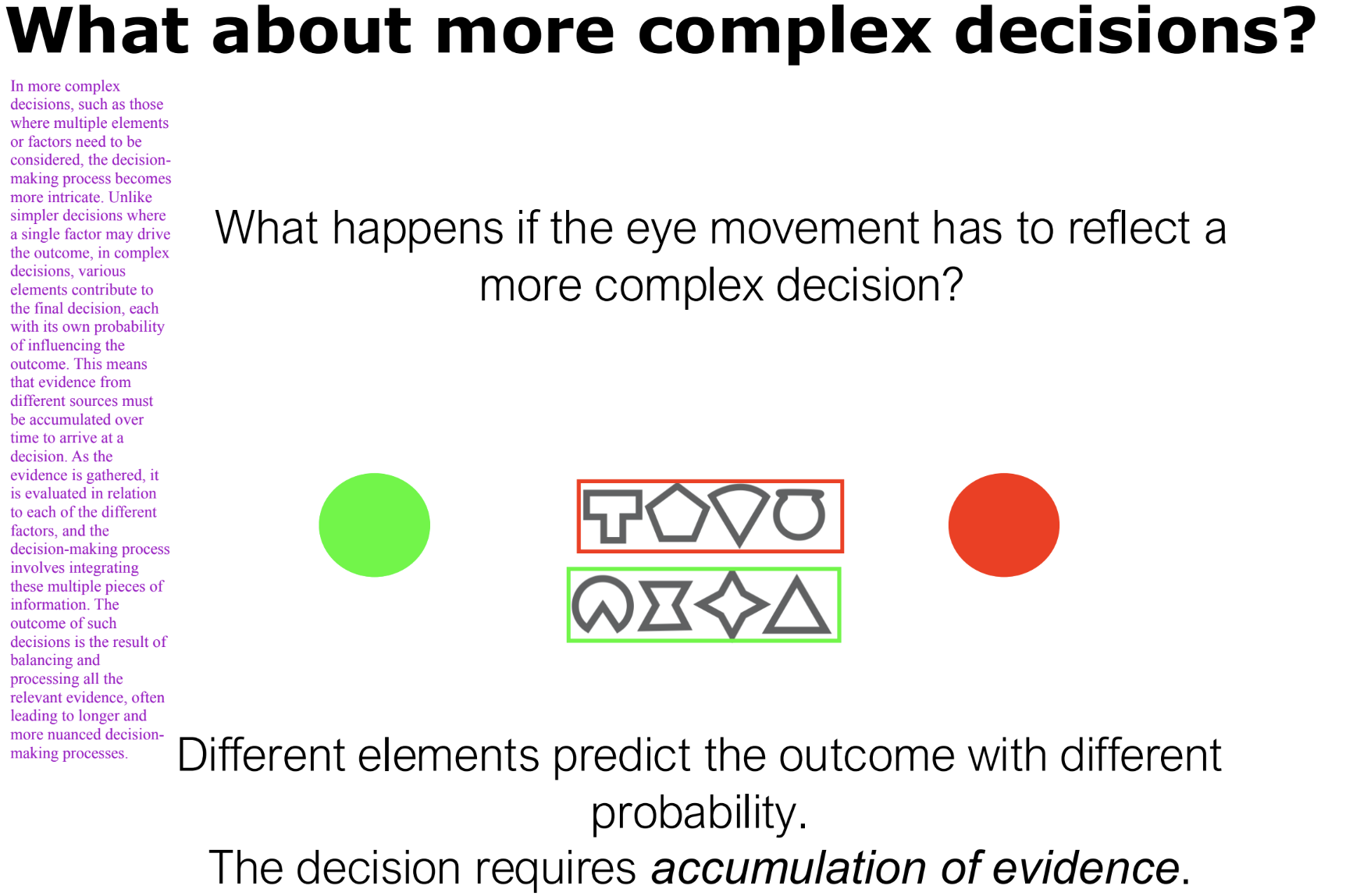
What is meant by accumulation of evidence in the brain? (Target selection and reaction times)
It's the process of gradually collecting and storing sensory or cognitive information until enough support for one outcome is reached, allowing a threshold to be crossed and a decision to be made.
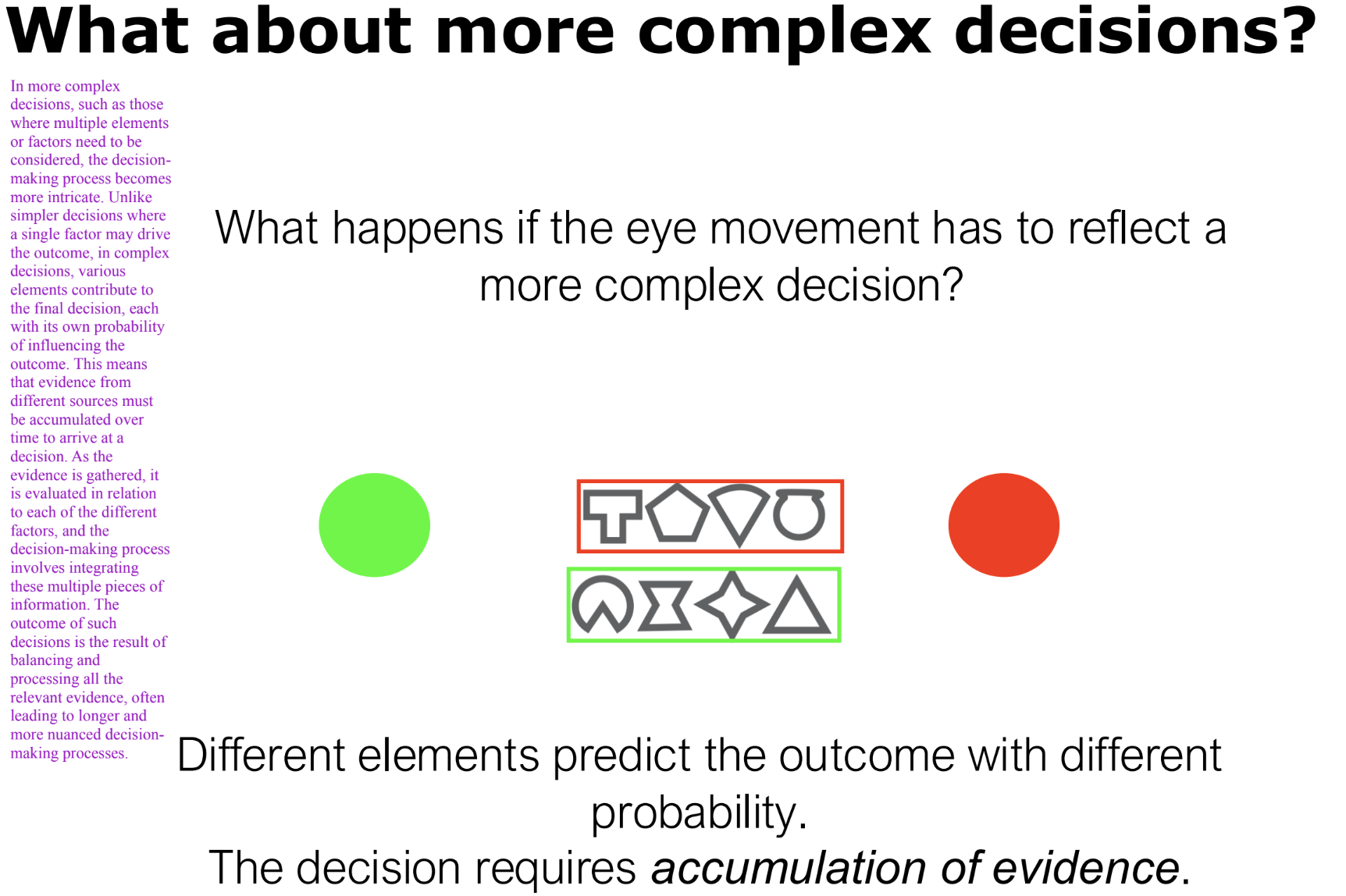
How does nonsensory information contribute to decision-making in the brain? (Decision Variables and Subjective Choice)
Nonsensory information—such as memory, attention, internal goals, and expectations—influences how sensory input is interpreted. Areas like LIP and FEF integrate both sensory (e.g., motion cues) and nonsensory signals to accumulate decision evidence and guide motor actions like saccades.
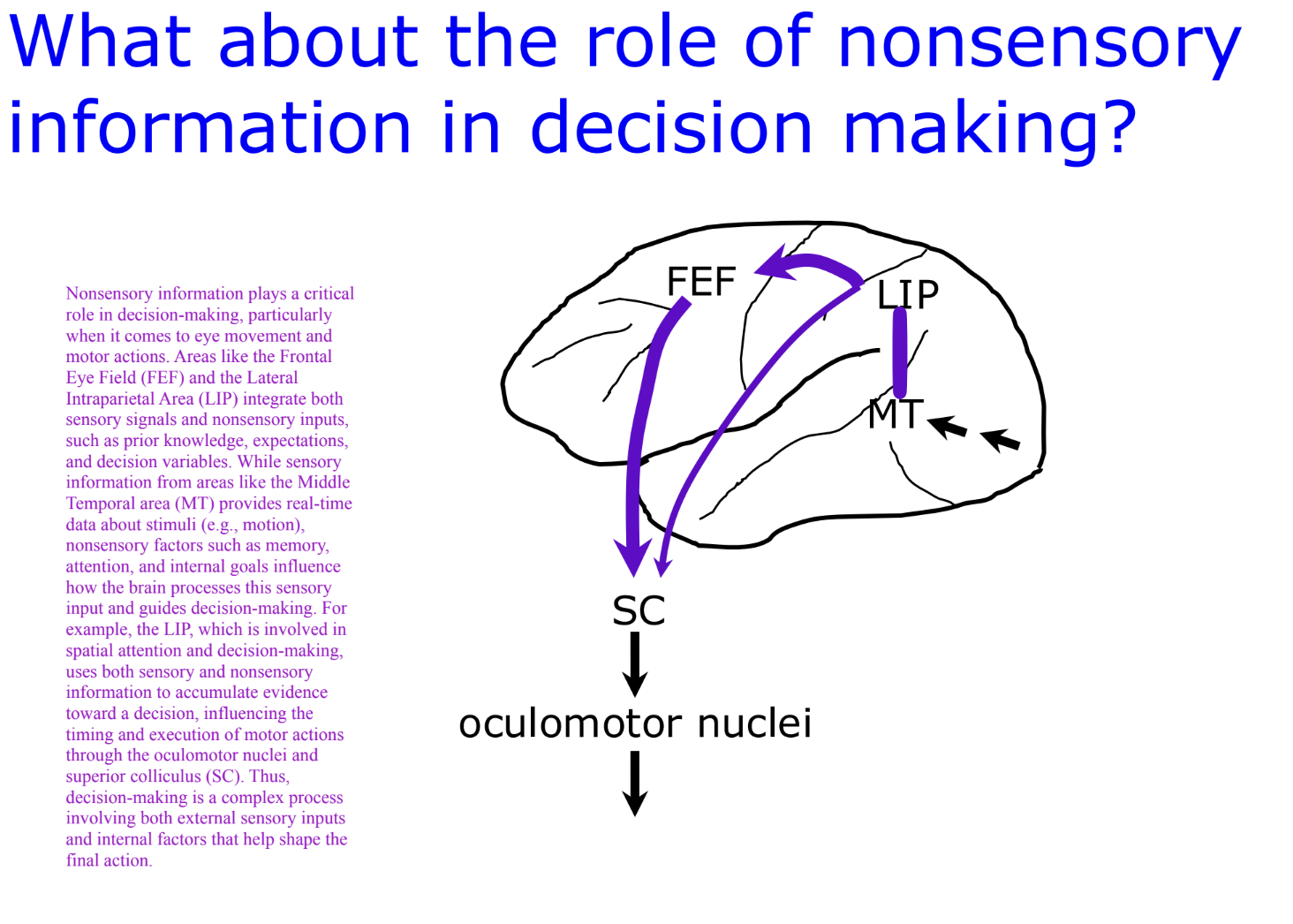
What is the role of the LIP in integrating nonsensory information? (Nonsensory Info in Decision Making)
LIP integrates nonsensory variables like expected utility and reward probability into the decision-making process. This allows the brain to make choices not only based on sensory input but also on internal evaluations of potential outcomes, shaping how and when actions are taken.
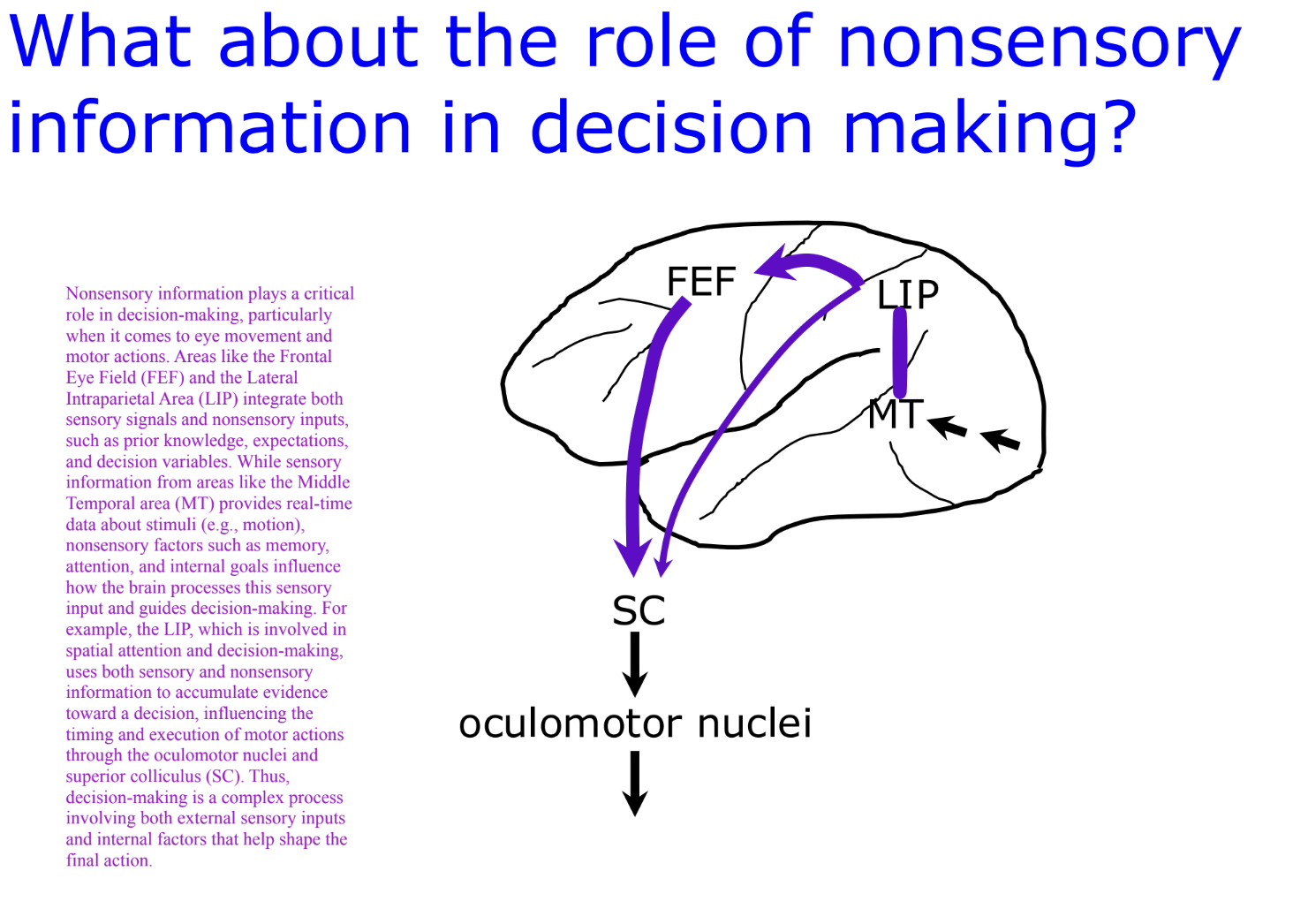
What did Barash et al. (1996) do to study nonsensory integration in LIP, and what were the findings? (Nonsensory Info in Decision Making)
Procedure: They kept sensory stimuli and motor responses constant while varying decision-theoretic variables like reward size and probability.
Findings: LIP neurons reflected changes in expected utility, showing that decision-related activity in LIP includes nonsensory factors. These neurons responded more when the expected reward or likelihood of reward increased, even when the visual and motor aspects remained unchanged.
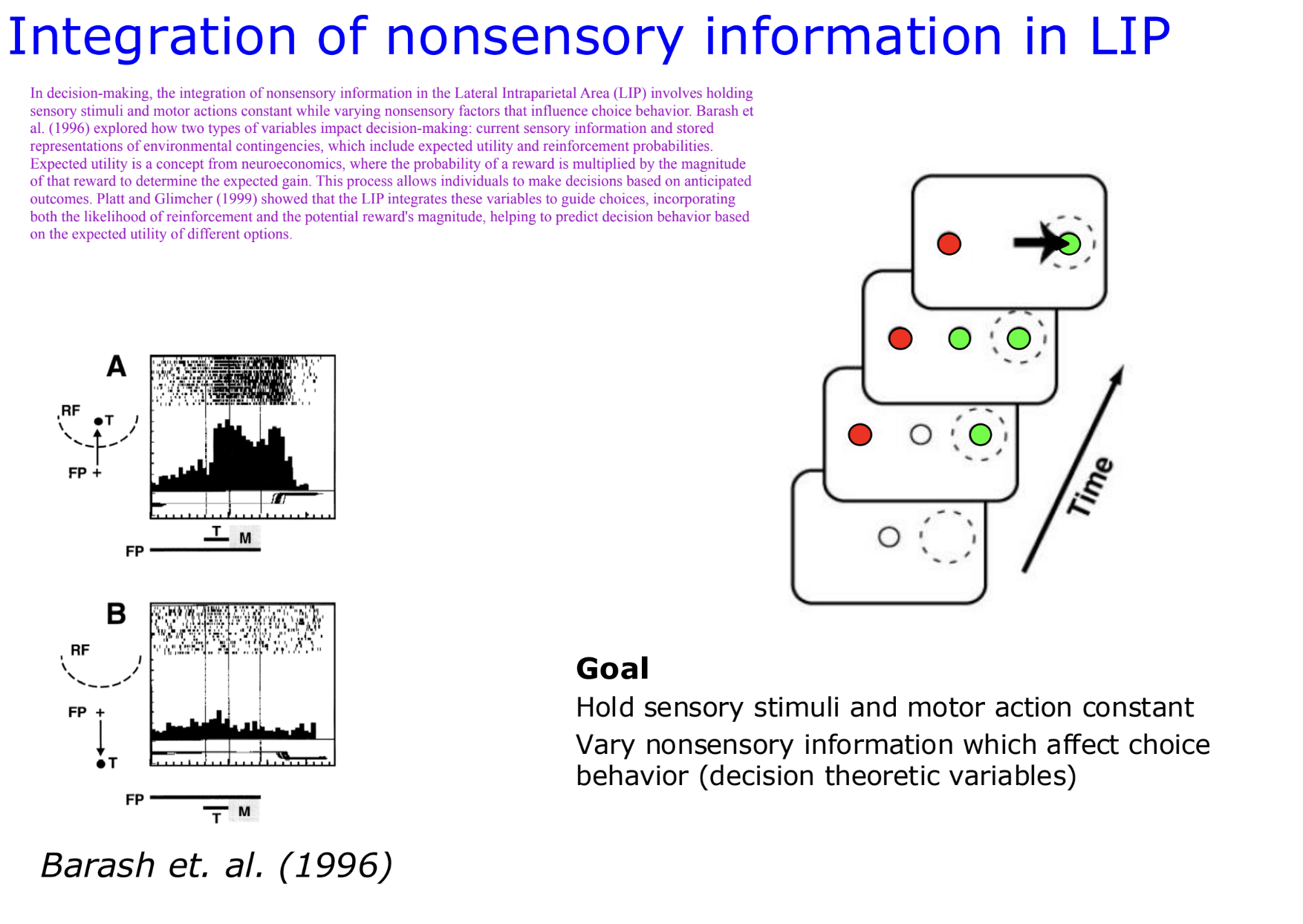
What was the main goal of the Barash et al. (1996) experiment on decision-making? (Nonsensory Info in Decision Making)
The goal was to isolate the effect of nonsensory factors on decision-making by holding sensory and motor conditions constant. This allowed them to demonstrate that internal variables like reward probability and value directly influence neural activity in LIP, revealing its role in value-based decisions.
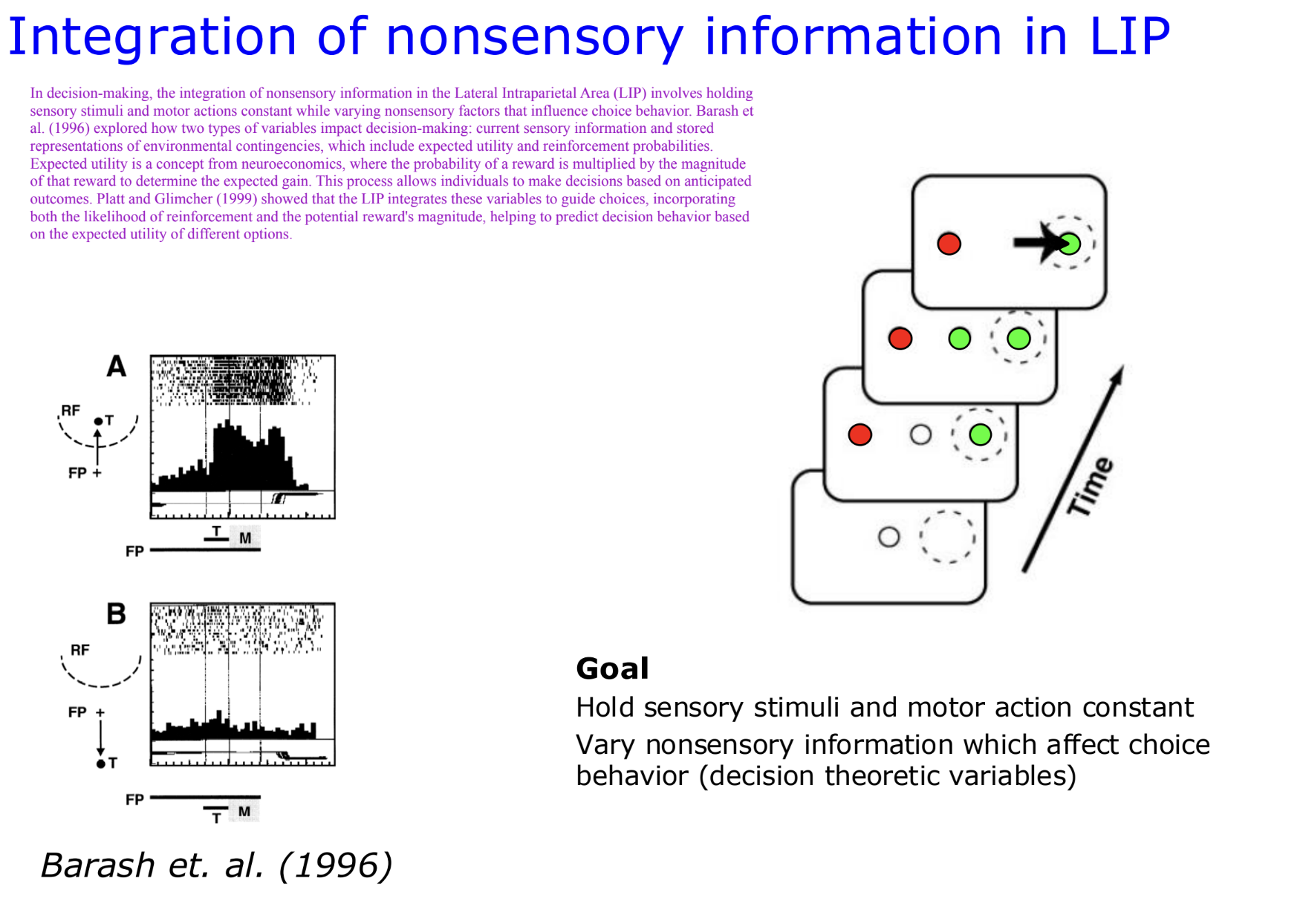
What is neuroeconomics and what does it study? (Decision Variables and Subjective Choice)
Neuroeconomics is the study of how the brain makes value-based decisions by integrating sensory information and nonsensory factors like reward probabilities, magnitudes, and expectations. It combines insights from neuroscience, psychology, and economics to understand how people make choices.
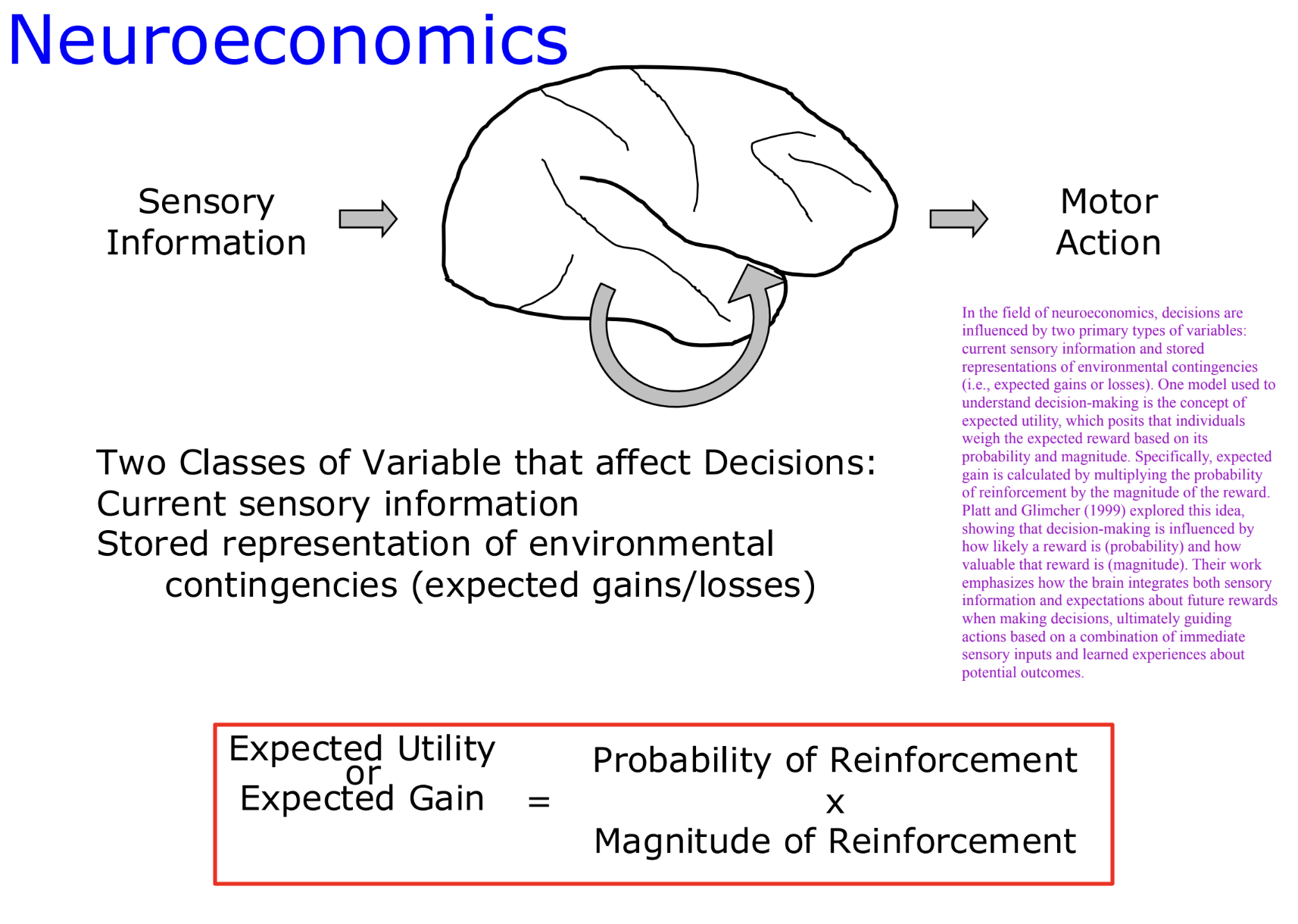
What two main types of variables influence decision-making in neuroeconomics? (Decision Variables and Subjective Choice)
Current sensory information (e.g., visual or motion cues)
Stored representations of environmental contingencies, such as expected gains/losses based on past outcomes, probabilities, and reward values.
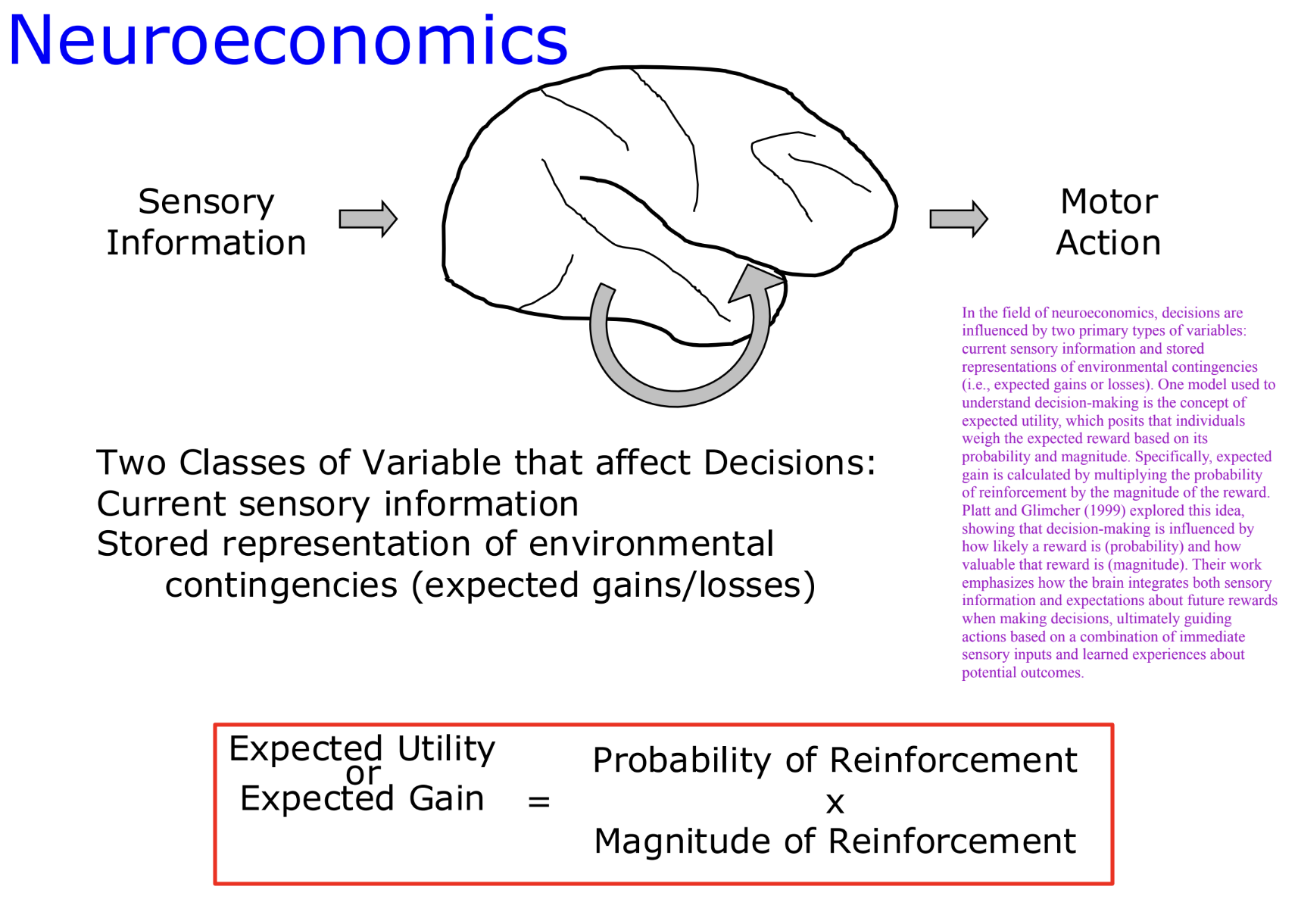
How is expected utility calculated and what does it mean?(Decision Variables and Subjective Choice)
Expected Utility (or Gain) = Probability of Reward × Magnitude of Reward
It represents the anticipated value of an outcome, guiding decision-making by evaluating both how likely a reward is and how large it is.
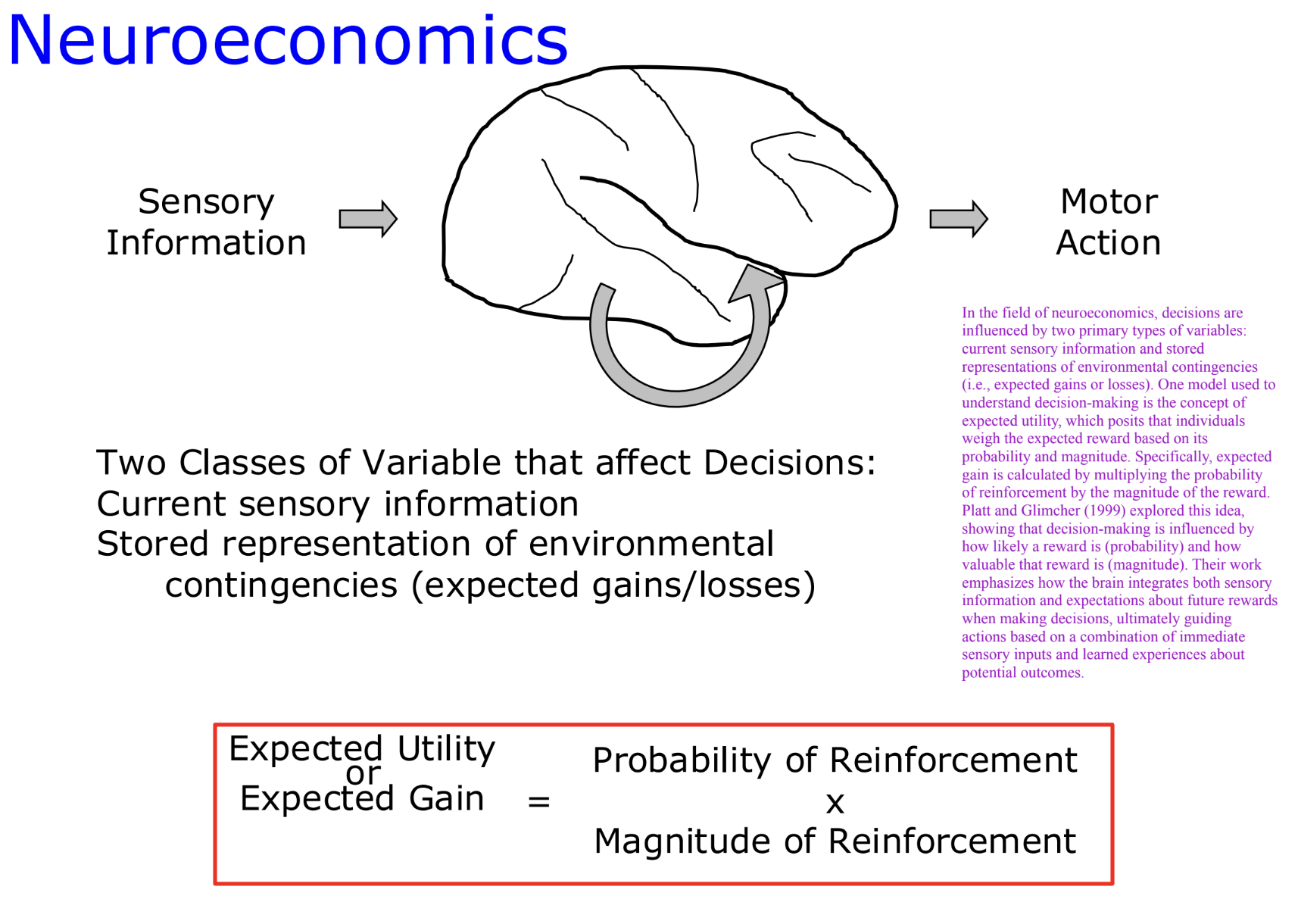
How did Platt & Glimcher (1999) test the role of reward probability and magnitude in decision-making? (Decision Variables and Subjective Choice)
Procedure:
Target onset → Cue change indicating either probability or magnitude of reward
Fixation offset → Saccade to target
Findings:
LIP neuron activity scaled with expected utility: higher firing rates occurred when reward probability and/or magnitude increased.
Showed that LIP encodes expected value, integrating both the likelihood and size of rewards to guide choices.
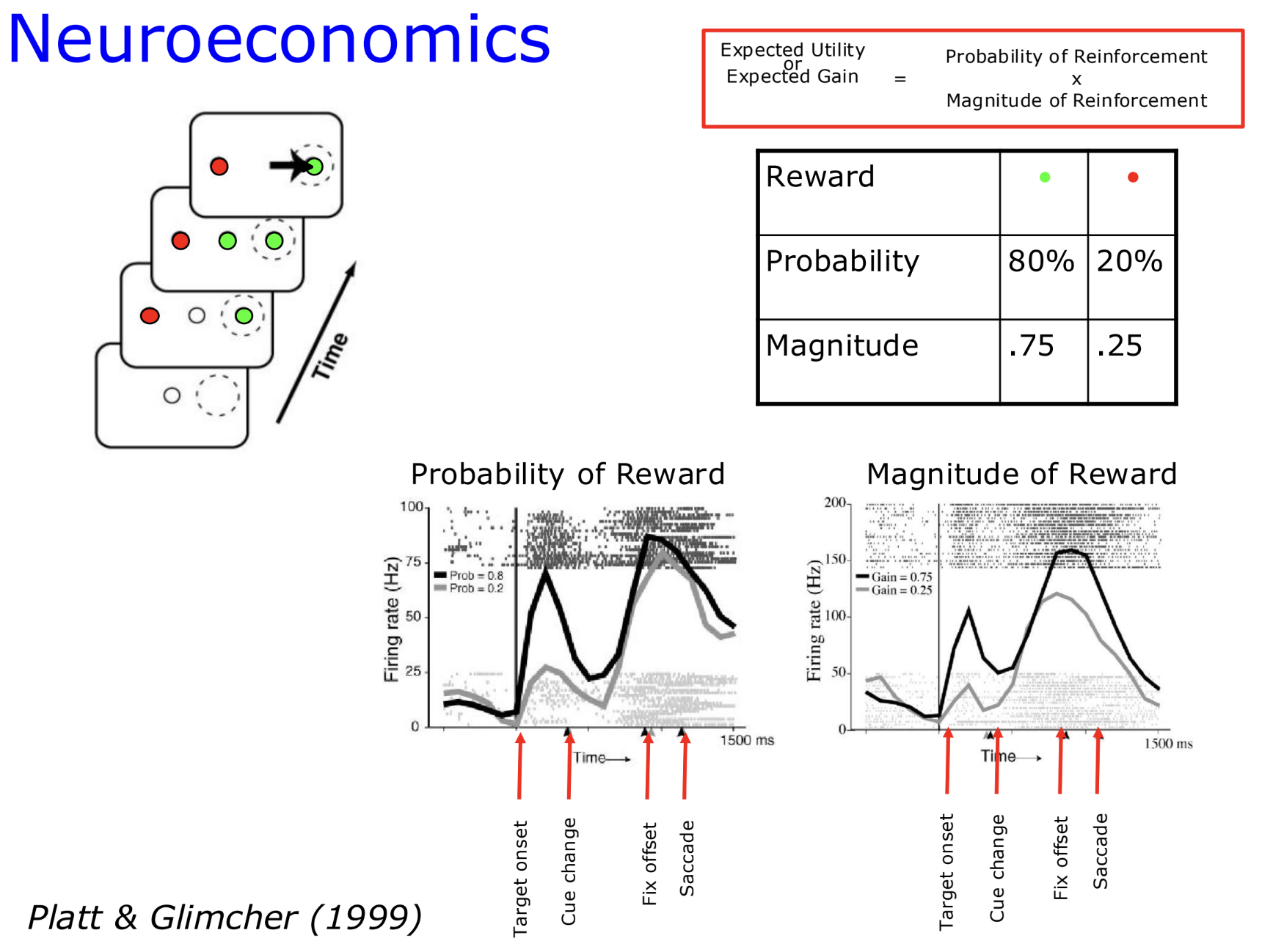
How are decisions and rewards linked in brain circuits like MT, LIP, FEF, and SC? (Rewards)
MT provides sensory input (e.g., motion cues).
LIP integrates this with value signals to inform decisions.
FEF plans the motor response (e.g., saccade).
SC executes the movement.
Reward information influences this whole loop by shaping goal-directed behavior and learning from outcomes.
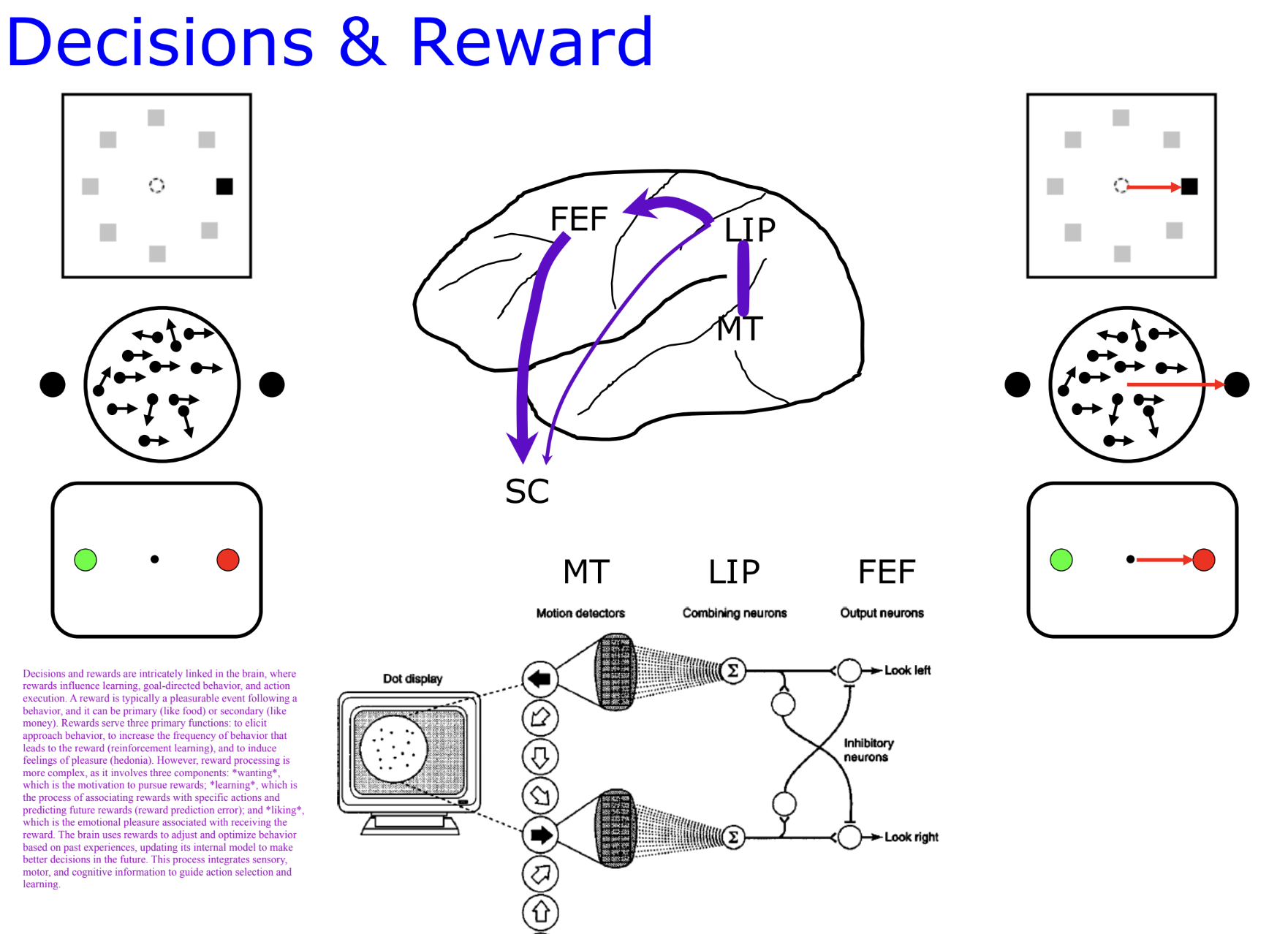
What is the basic definition of a reward? (Rewards)
A reward is a pleasurable event that follows a specific behavior and reinforces that behavior.
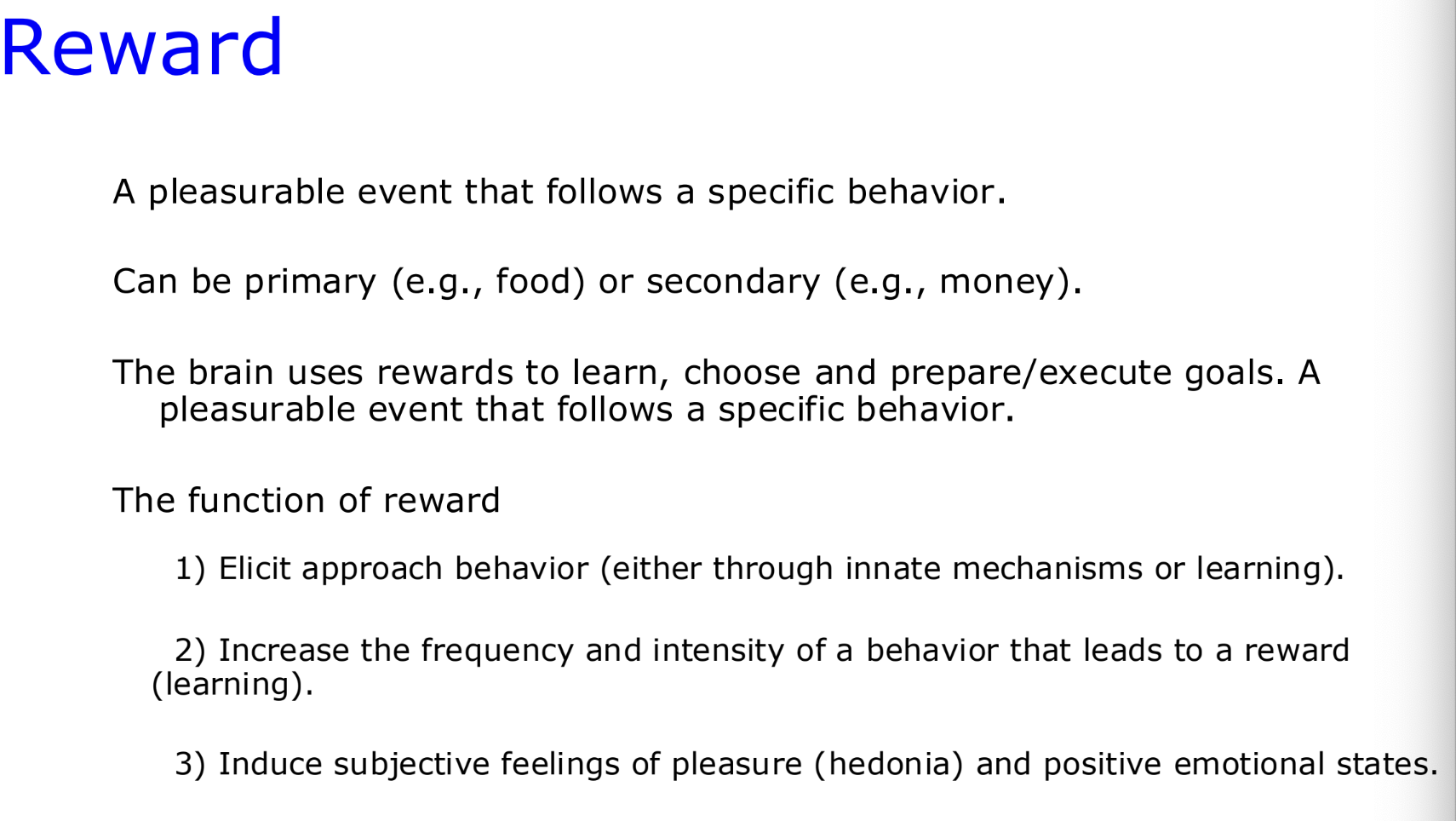
What are the different forms a reward can take? (Rewards)
Primary (e.g., food, water)
Secondary (e.g., money, tokens)
Abstract (e.g., music, approval)
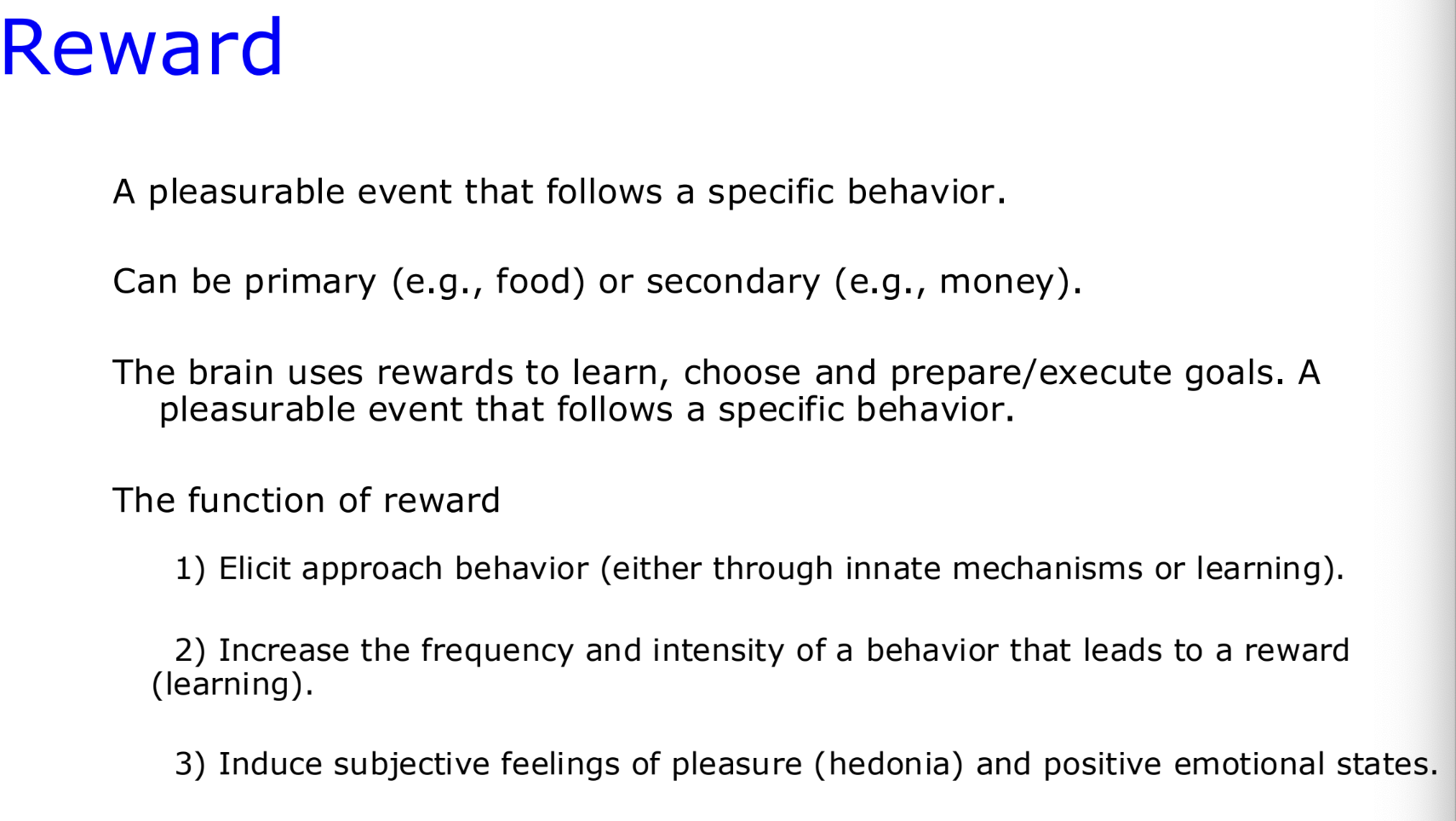
What does the brain use reward signals to accomplish? (Rewards)
Learn from outcomes
Update internal models of the world
Choose better actions in the future
Execute goal-directed behavior
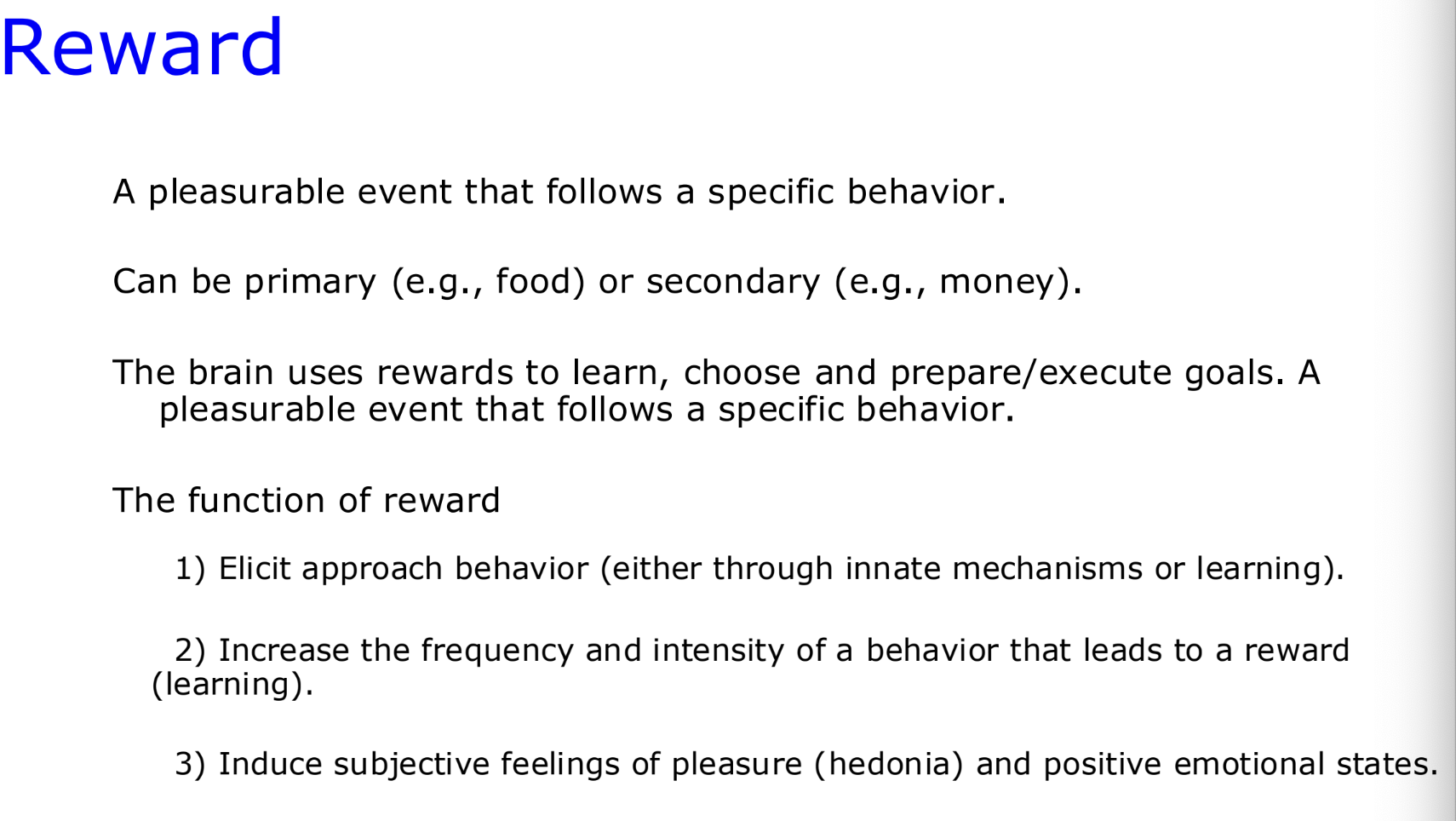
What are the core behavioral and psychological functions of reward? (Rewards)
Elicit approach behavior
Reinforce behavior (increase frequency of reward-related actions)
Induce pleasure (hedonia and positive emotional states)
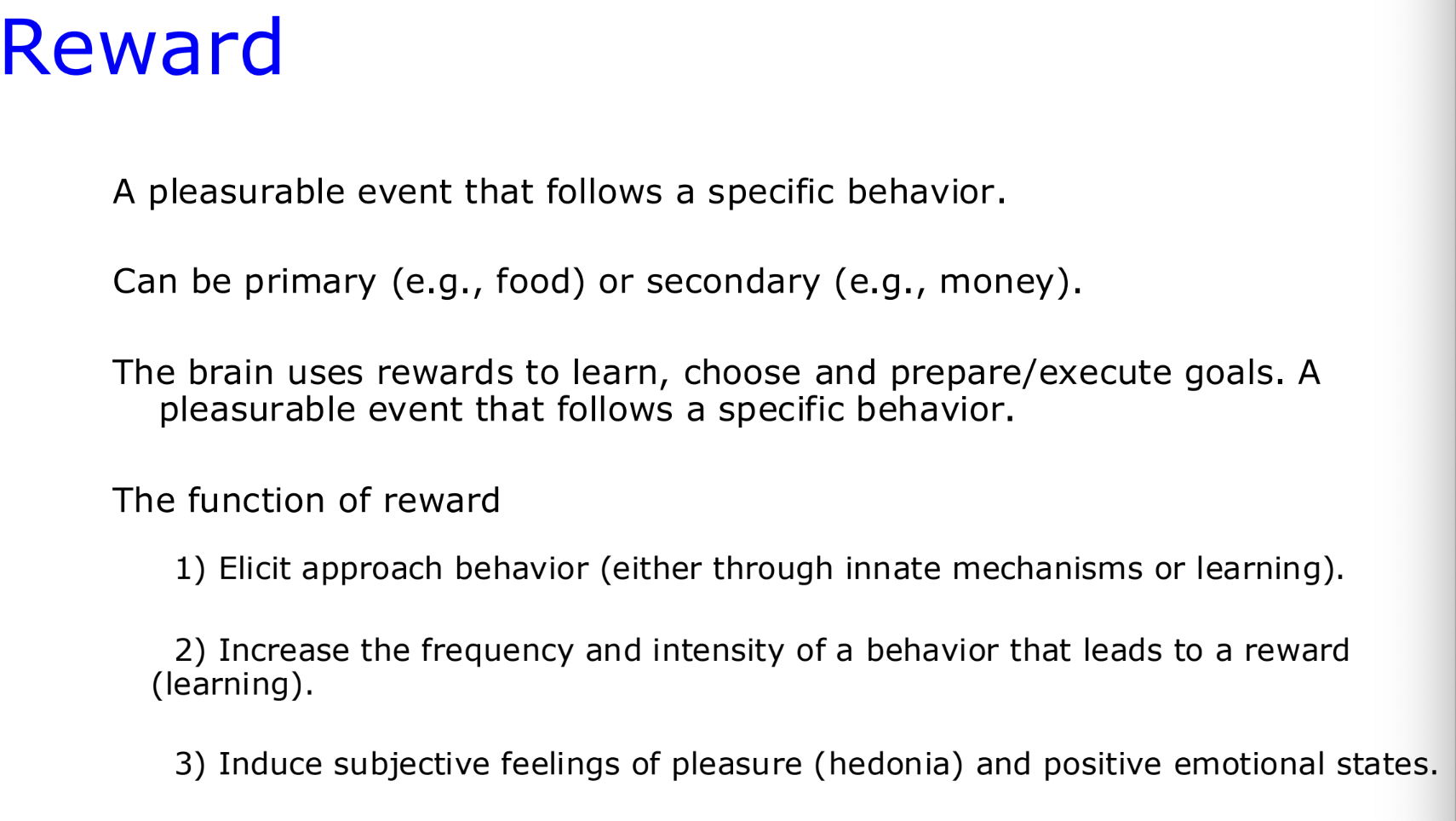
What is hedonia in the context of reward? (Rewards)
Hedonia is the subjective feeling of pleasure or enjoyment experienced when a reward is received.

Why is the concept of reward more nuanced than simple pleasure? (Rewards)
Because reward has multiple components:
Wanting (motivation)
Learning (associations/predictions)
Liking (pleasure)
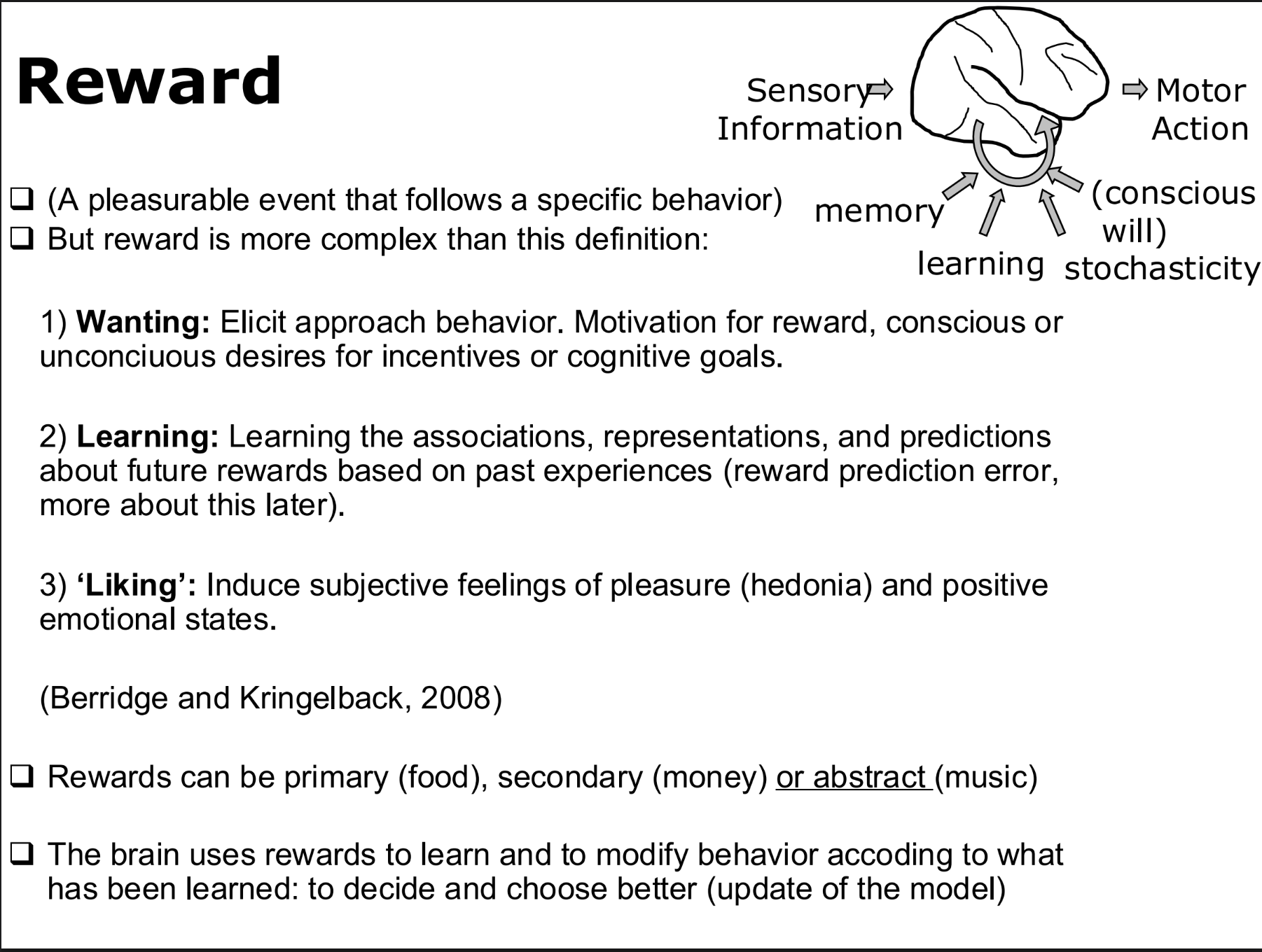
What does wanting mean in the reward process? (Rewards)
It is the motivational drive or desire (conscious or unconscious) to pursue a reward — drives approach behavior.
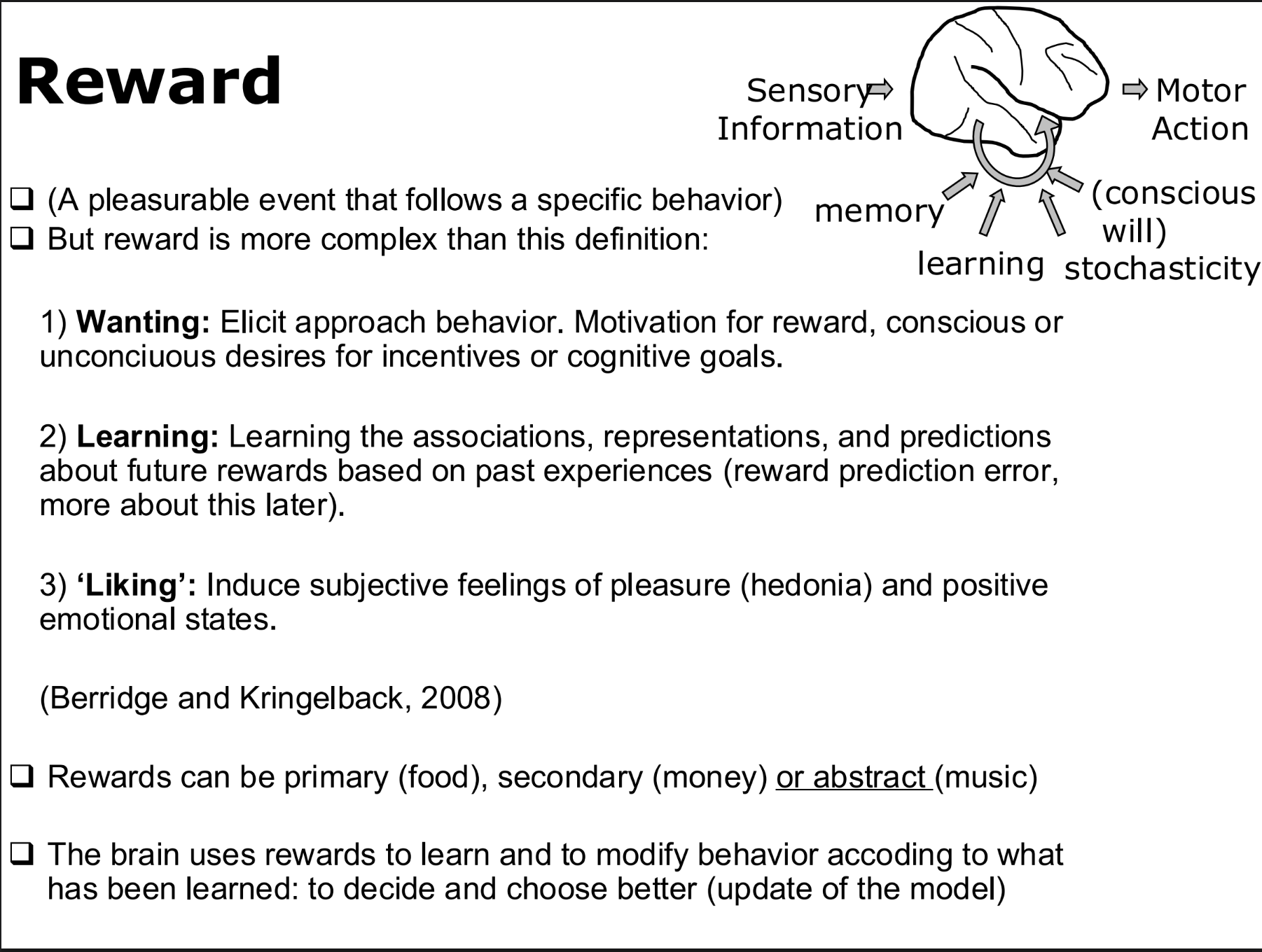
How does learning relate to reward processing? (Rewards)
It involves forming associations between actions and outcomes, and predicting future rewards based on past experience (reward prediction error).
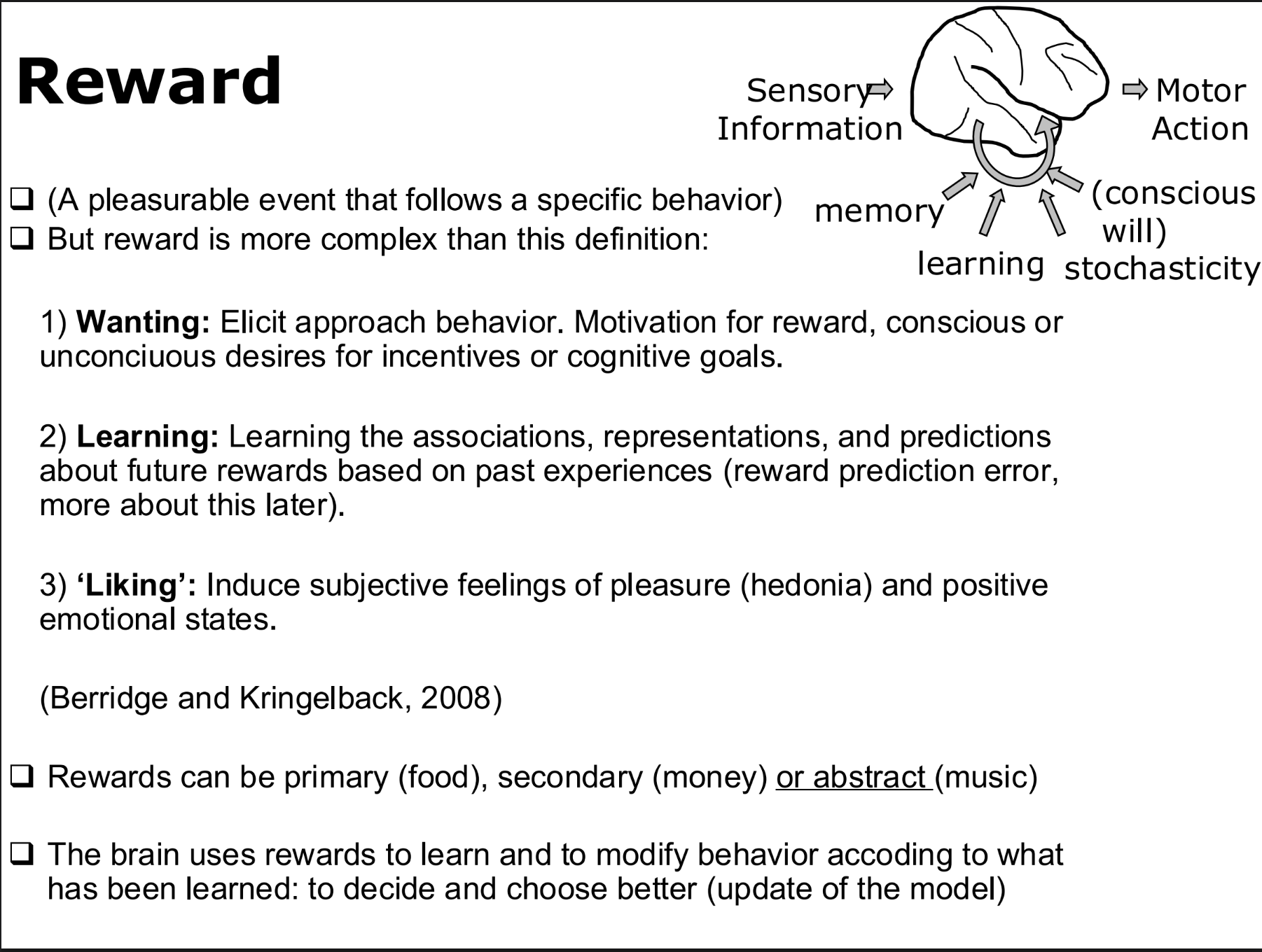
What is the liking component of reward? (Rewards)
It's the emotional pleasure or positive affective response experienced when receiving a reward (hedonia).

What is the role of the dopamine (DA) system in the brain? (Rewards: Dopamine)
The dopamine system is involved in reward, motivation, self-stimulation, motor control, and addiction. It helps drive behaviors that lead to rewarding outcomes.
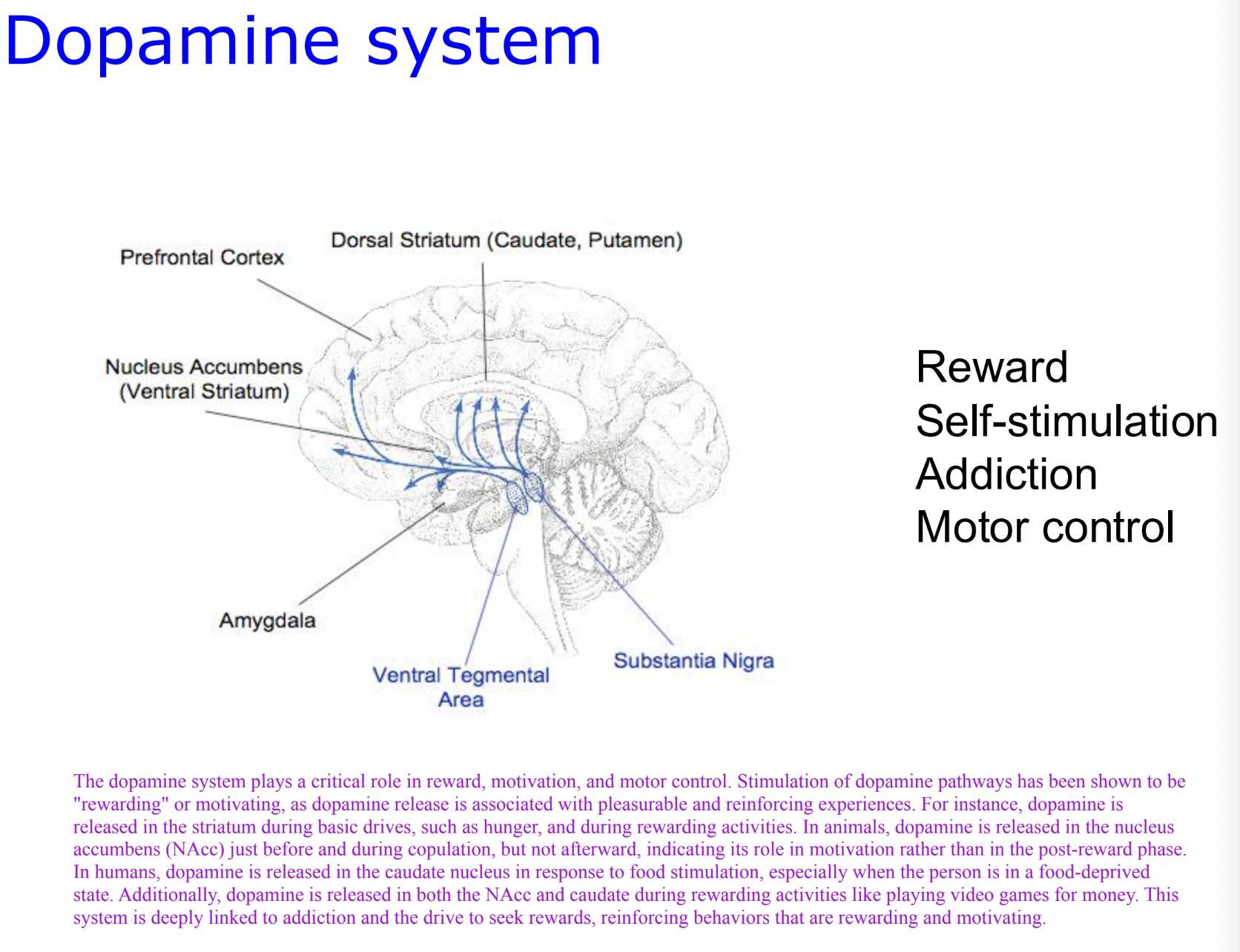
What are the four main functions or components of the dopamine system? (Rewards: Dopamine)
Reward
Self-stimulation
Addiction
Motor control
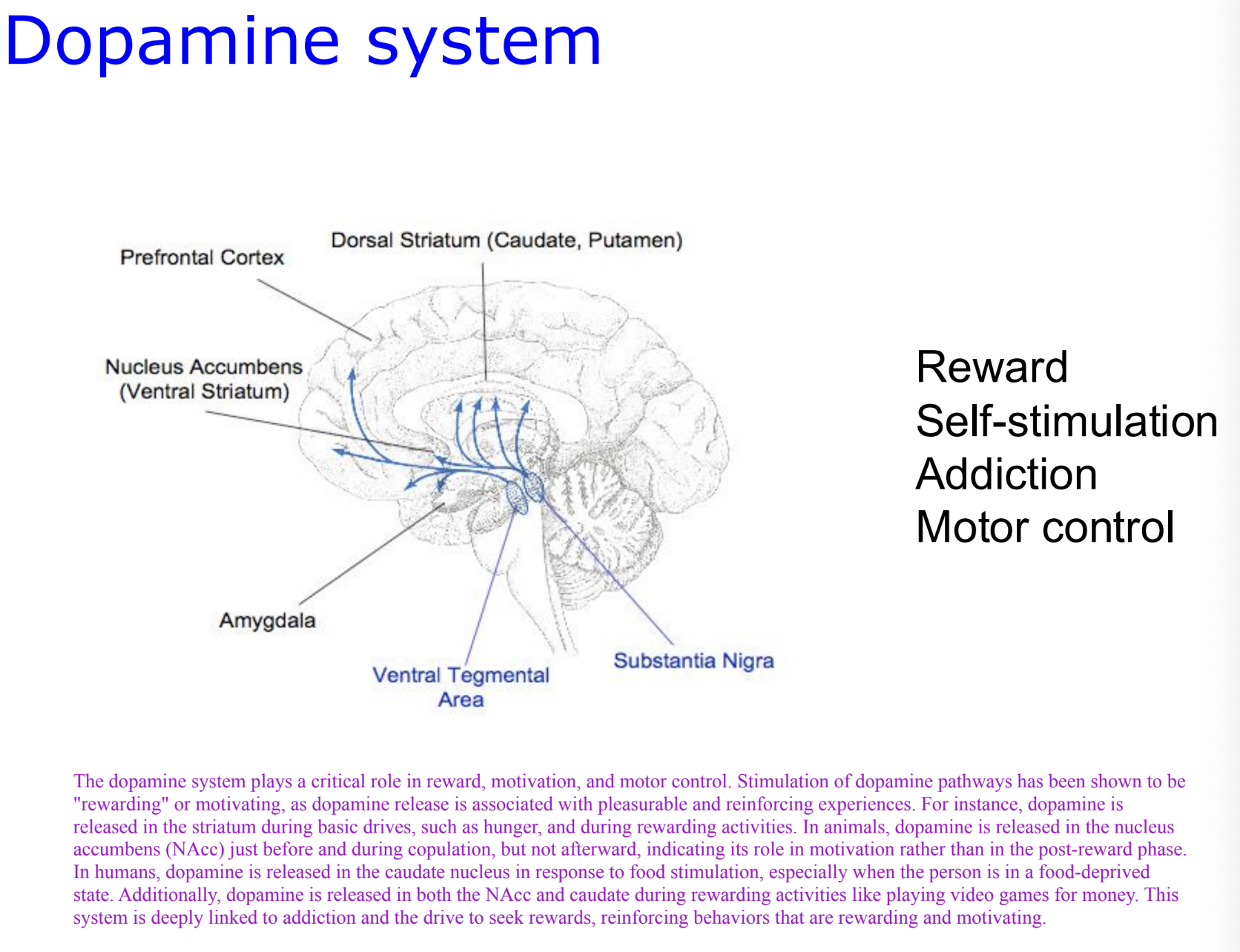
What happens when dopamine pathways are artificially stimulated? (Rewards: Dopamine)
Stimulation of dopamine pathways is experienced as rewarding or motivating. It reinforces behavior and increases the likelihood of repeating that behavior.

What did Peter Shizgal’s work at Concordia show about dopamine? (Rewards: Dopamine)
Rats would repeatedly self-stimulate dopamine pathways via electrical stimulation, choosing it over food or water, showing how powerfully rewarding dopamine activation is.
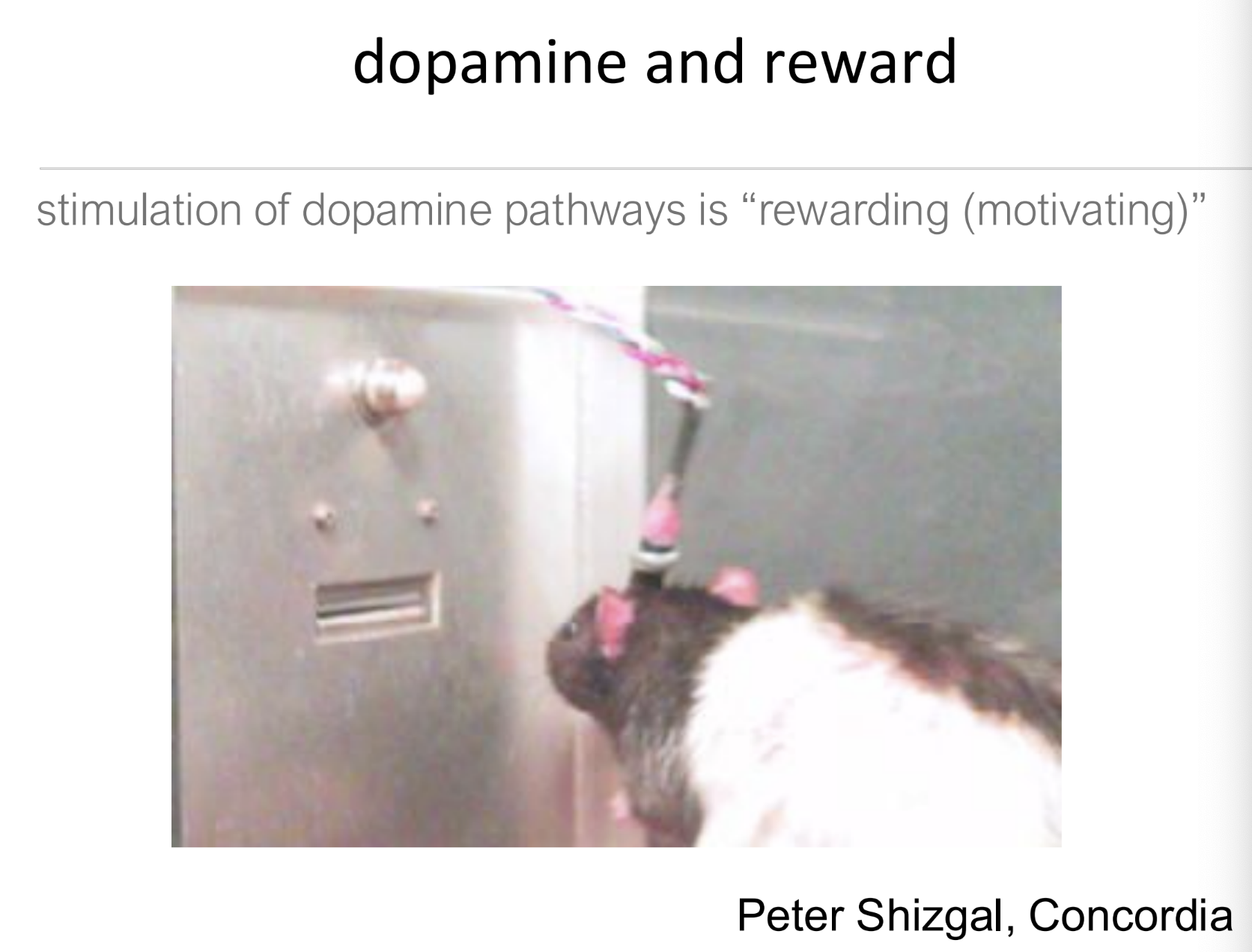
What do common rewards (like food or sex) trigger in the brain? (Rewards: Dopamine)
They lead to the release of dopamine (DA), particularly in the striatum and nucleus accumbens (NAcc), areas tied to motivation and reinforcement.

What are key moments when dopamine is released in rats? (Rewards: Dopamine)
DA is released in the nucleus accumbens right before and during copulation, but not afterward — showing its role in anticipation/motivation, not just reward.
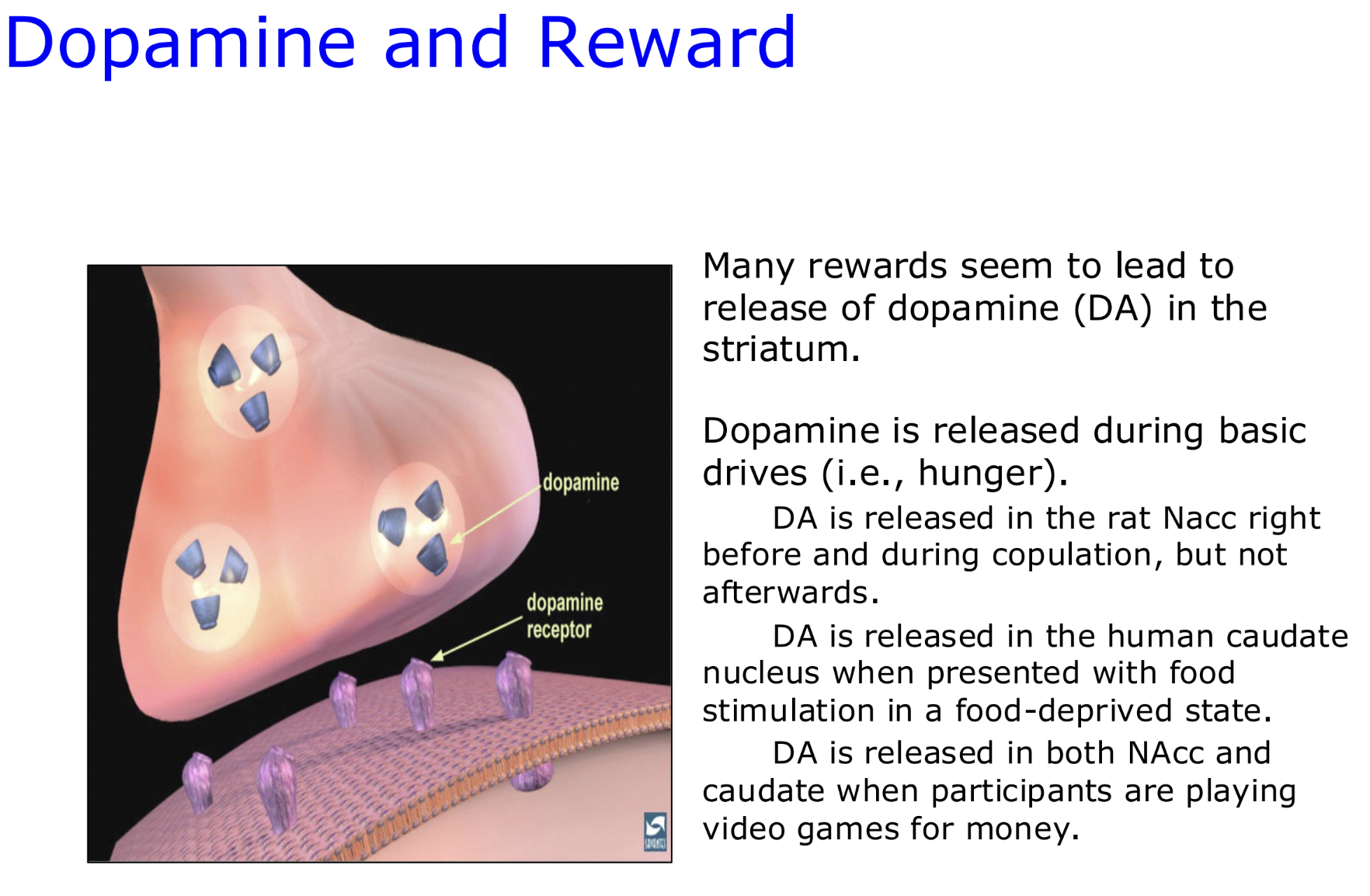
When does dopamine get released in humans? (Rewards: Dopamine)
DA is released in the caudate nucleus in response to food cues, especially when food-deprived. It’s also released in NAcc and caudate during activities like playing video games for money.
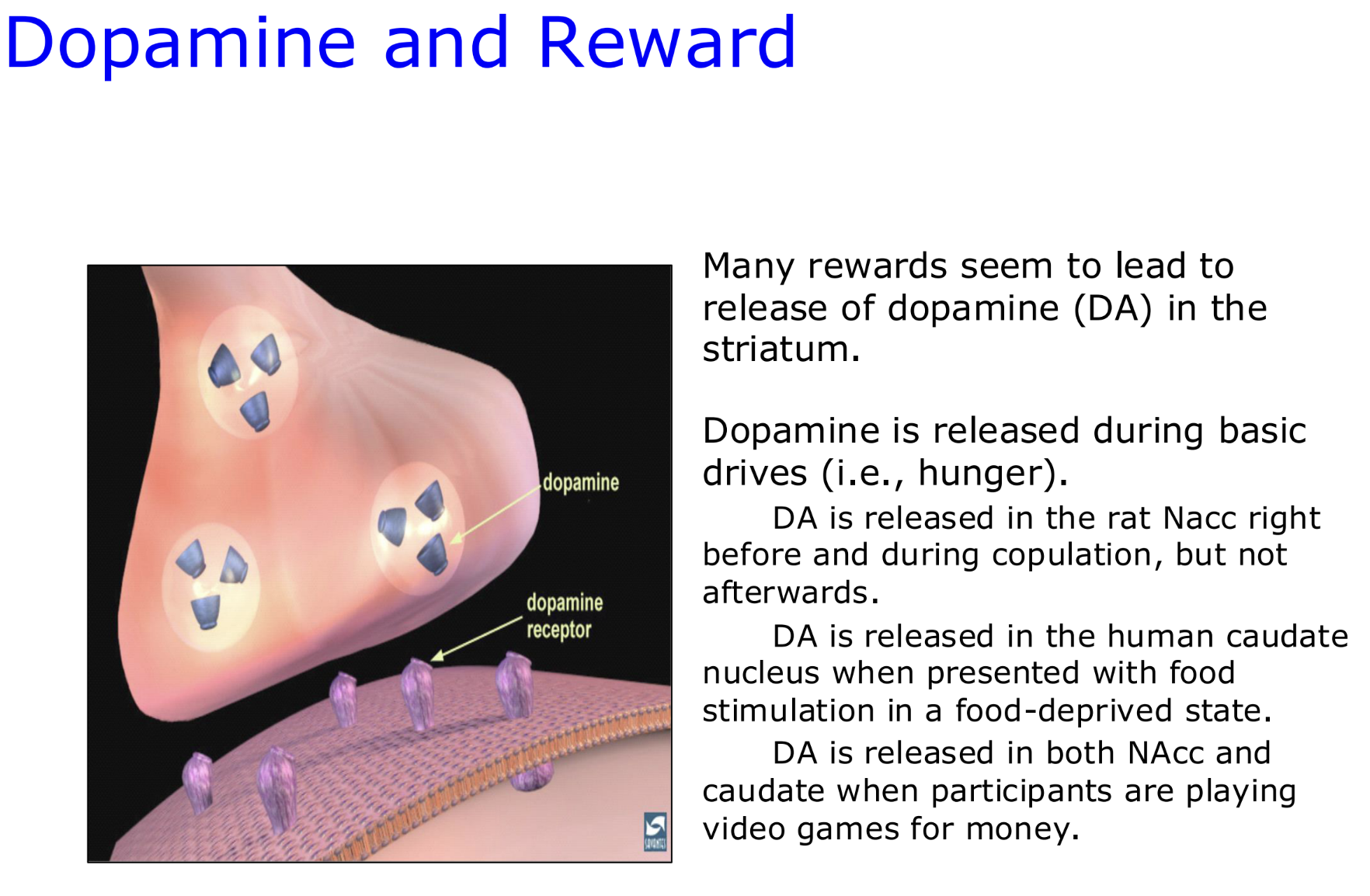
What happens in the brain when people play games for money? (Rewards: Dopamine)
DA is released in the NAcc and caudate during game play, especially in reward anticipation, showing dopamine’s role in motivation and effort toward a goal.
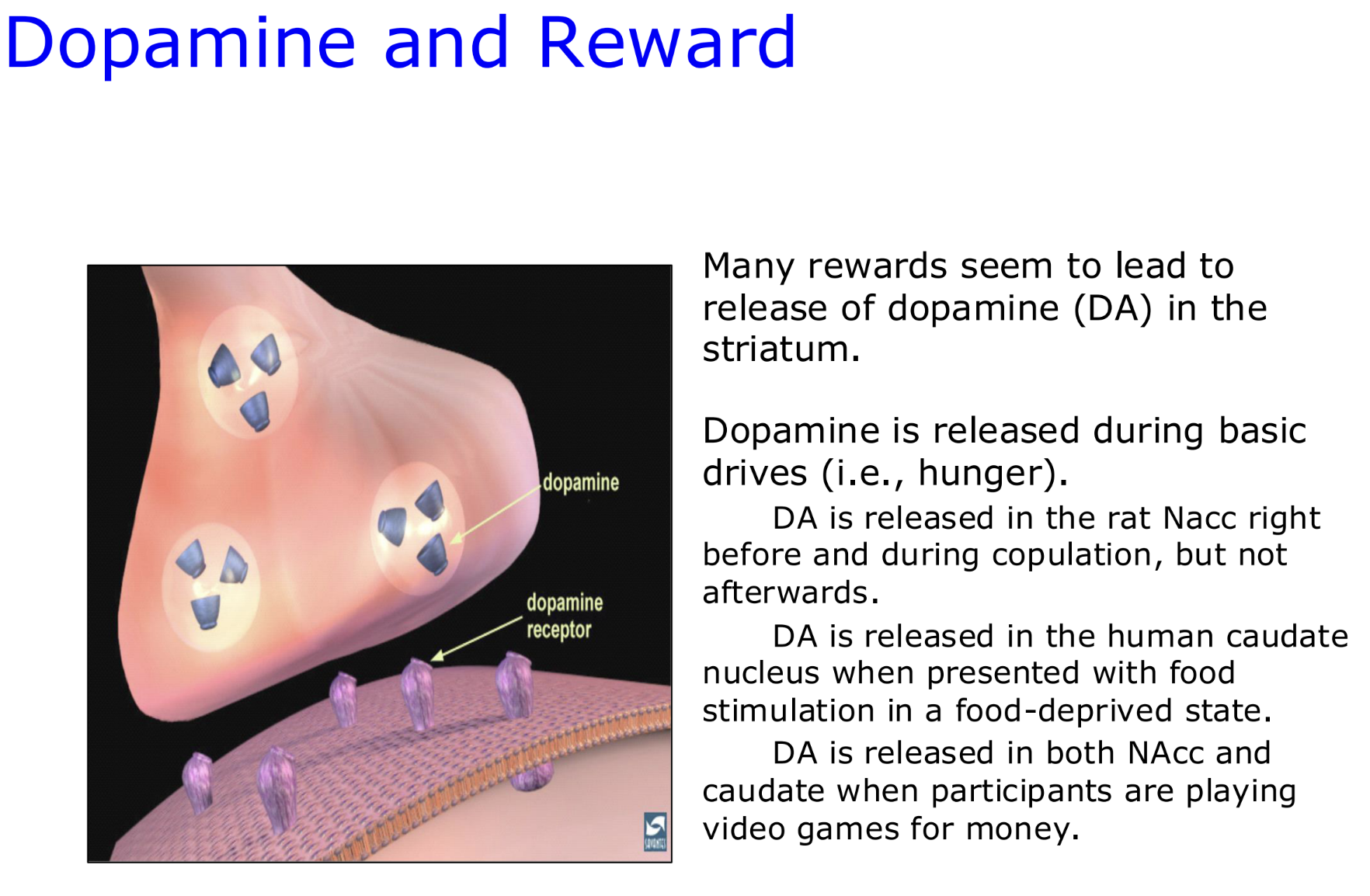
What does dopamine receptor binding refer to? (Rewards: Dopamine)
It refers to how dopamine molecules bind to dopamine receptors to transmit signals in the brain. Receptor binding is essential for dopamine’s effects.
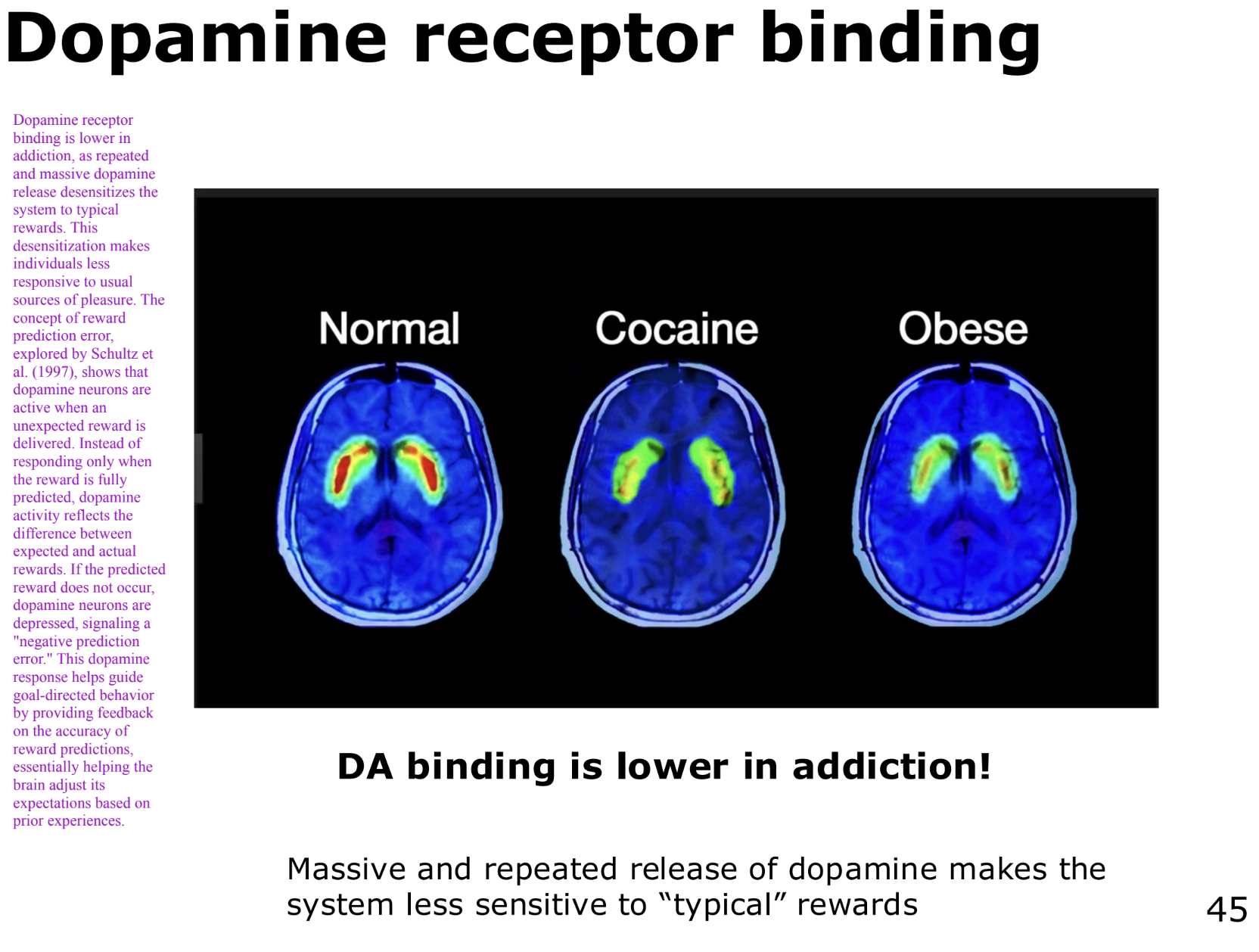
What happens to dopamine receptor binding in people with addiction? (Rewards: Dopamine)
Repeated dopamine surges cause lower receptor sensitivity, making the brain less responsive to typical rewards — contributing to tolerance and compulsive behavior.
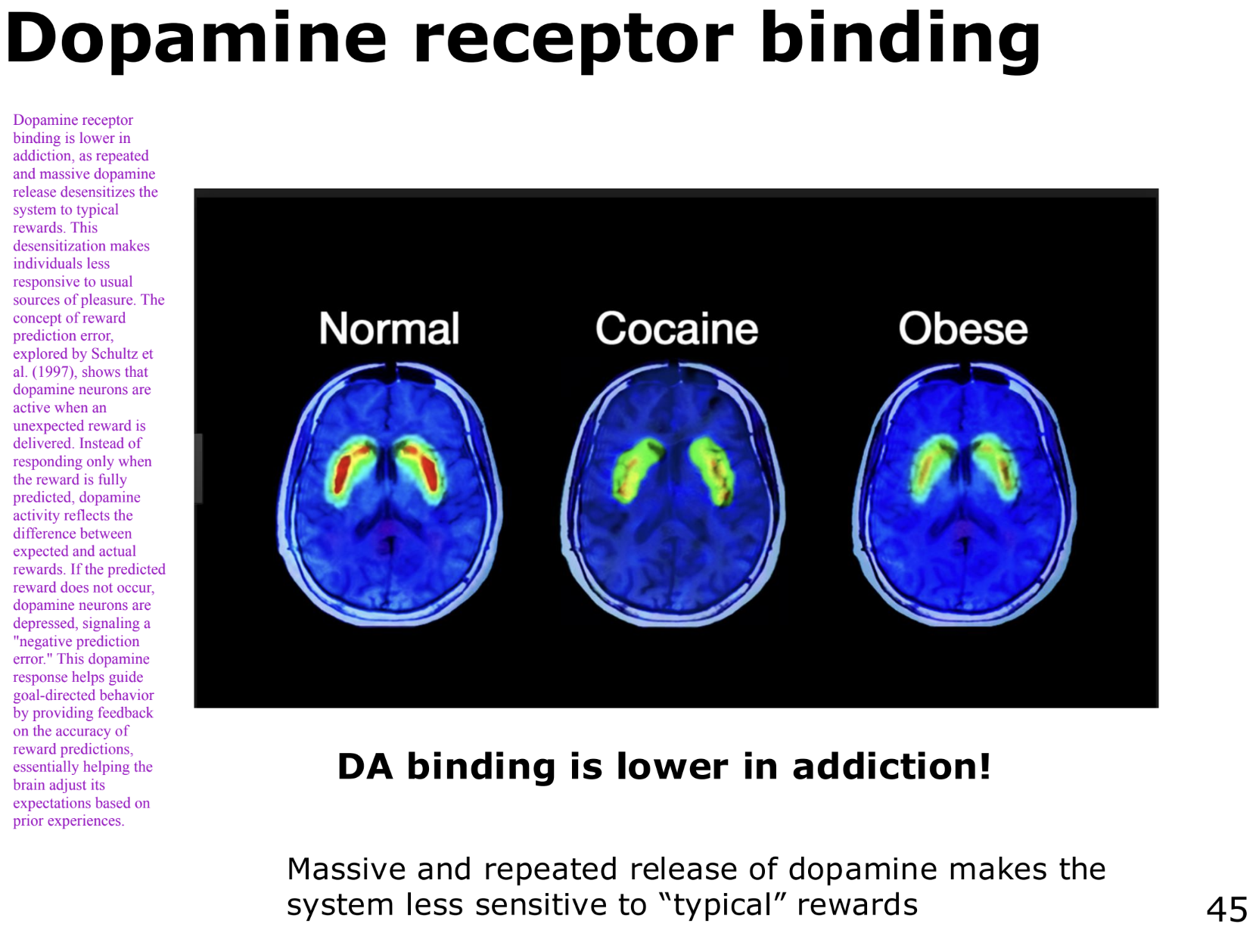
What causes the dopamine system to become less sensitive? (Rewards: Dopamine)
Massive and repeated dopamine release (e.g., from drugs or compulsive behaviors) desensitizes receptors, reducing the brain’s response to everyday rewards.
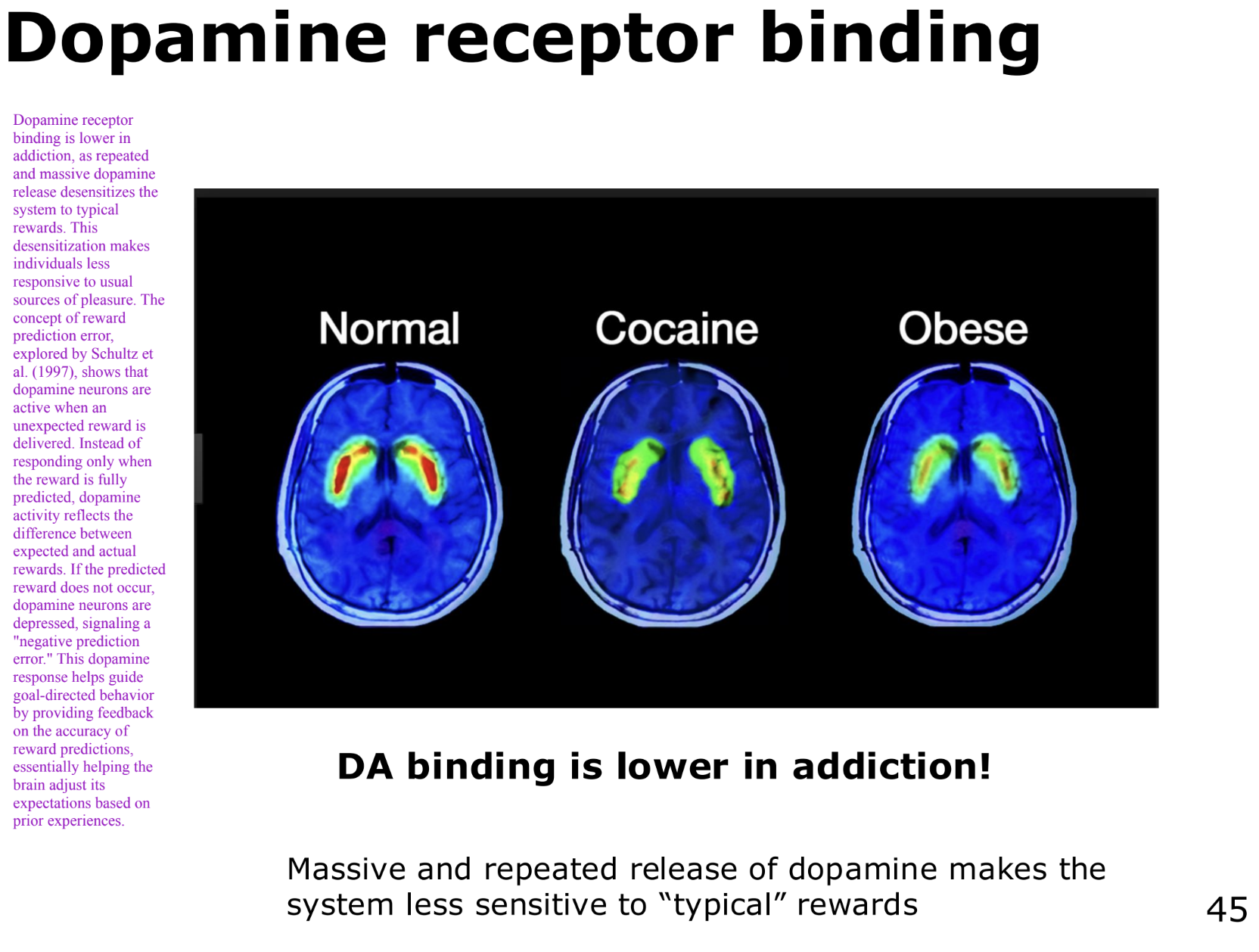
What is reward prediction error in the context of dopamine? (Reward Prediction Error)
Reward prediction error is the difference between the expected reward and the actual reward. Dopamine neurons encode this error, signaling whether the outcome of a reward was better or worse than expected, helping to adjust future behavior.
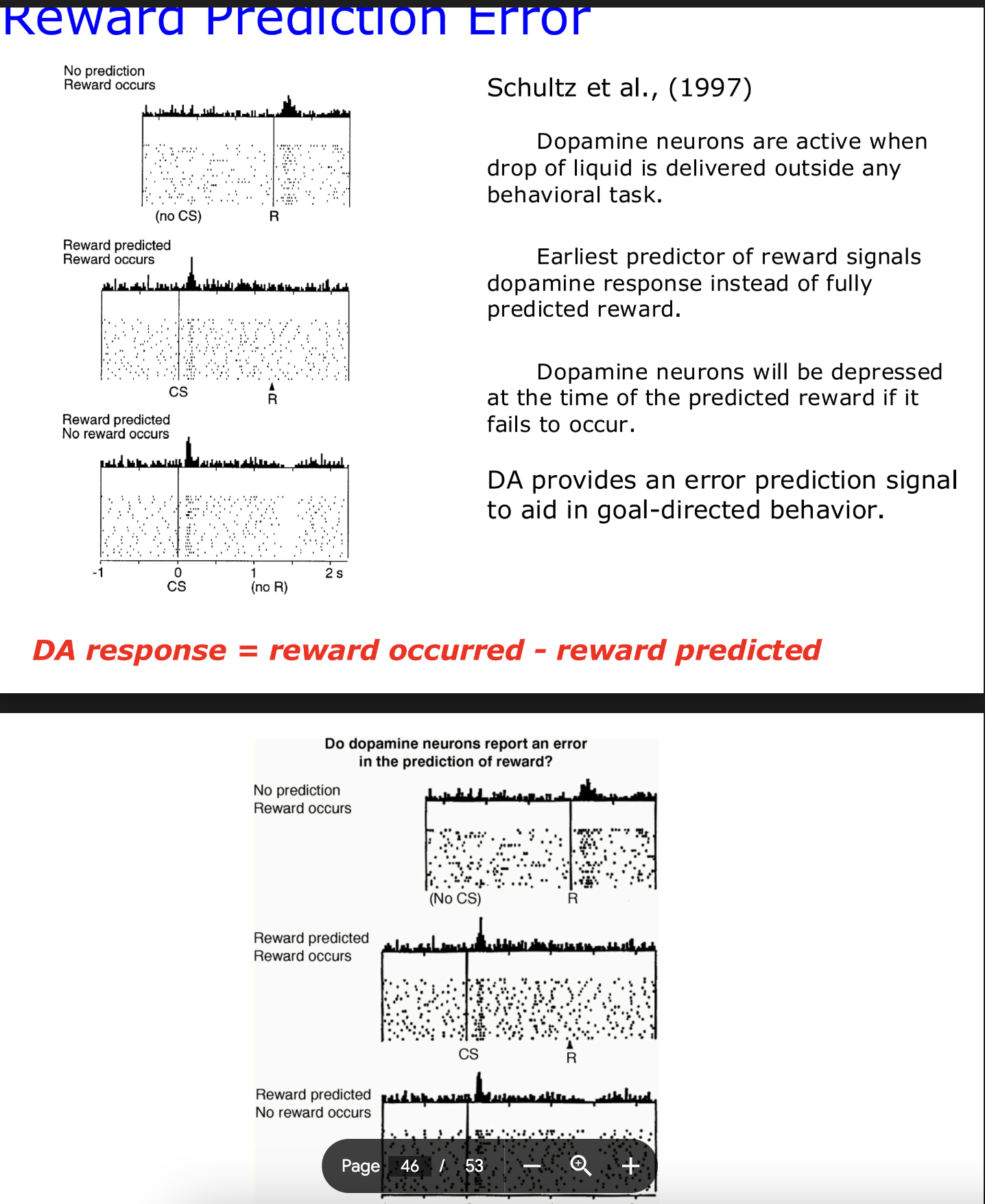
What did the Schultz et al. (1997) experiment show? (Reward Prediction Error)
The study demonstrated that dopamine neurons are active when a reward (e.g., a drop of liquid) is delivered, even in the absence of a specific behavioral task. This showed that dopamine plays a key role in predicting and processing rewards.
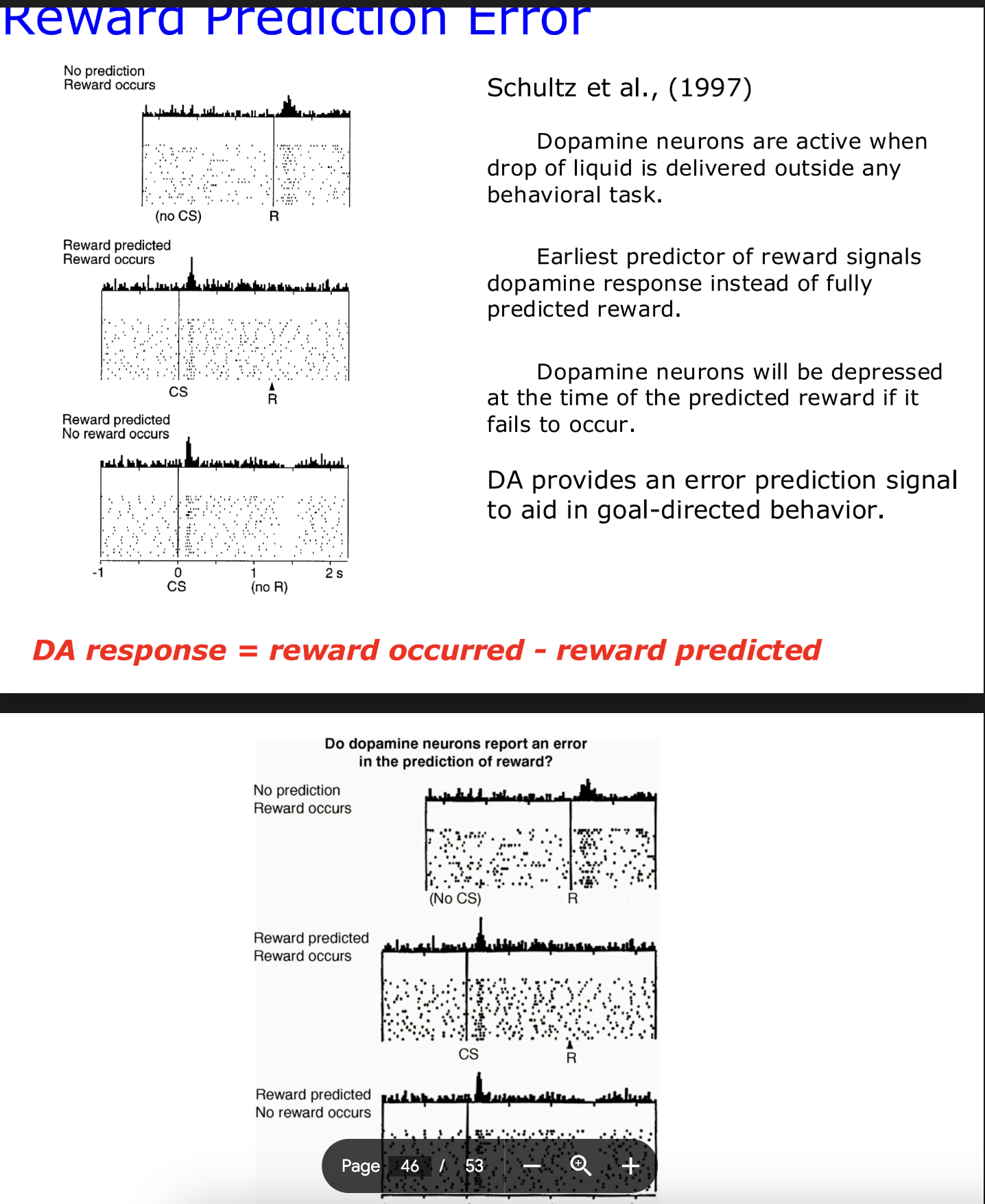
When are dopamine neurons active? (Reward Prediction Error)
Dopamine neurons are active when a reward is expected or received, particularly when there is an unexpected outcome that deviates from prior expectations.

What is the earliest predictor of reward signals? (Reward Prediction Error)
The dopamine response is the earliest predictor of reward signals, indicating the brain's anticipation of reward even before the reward is fully predicted or received.
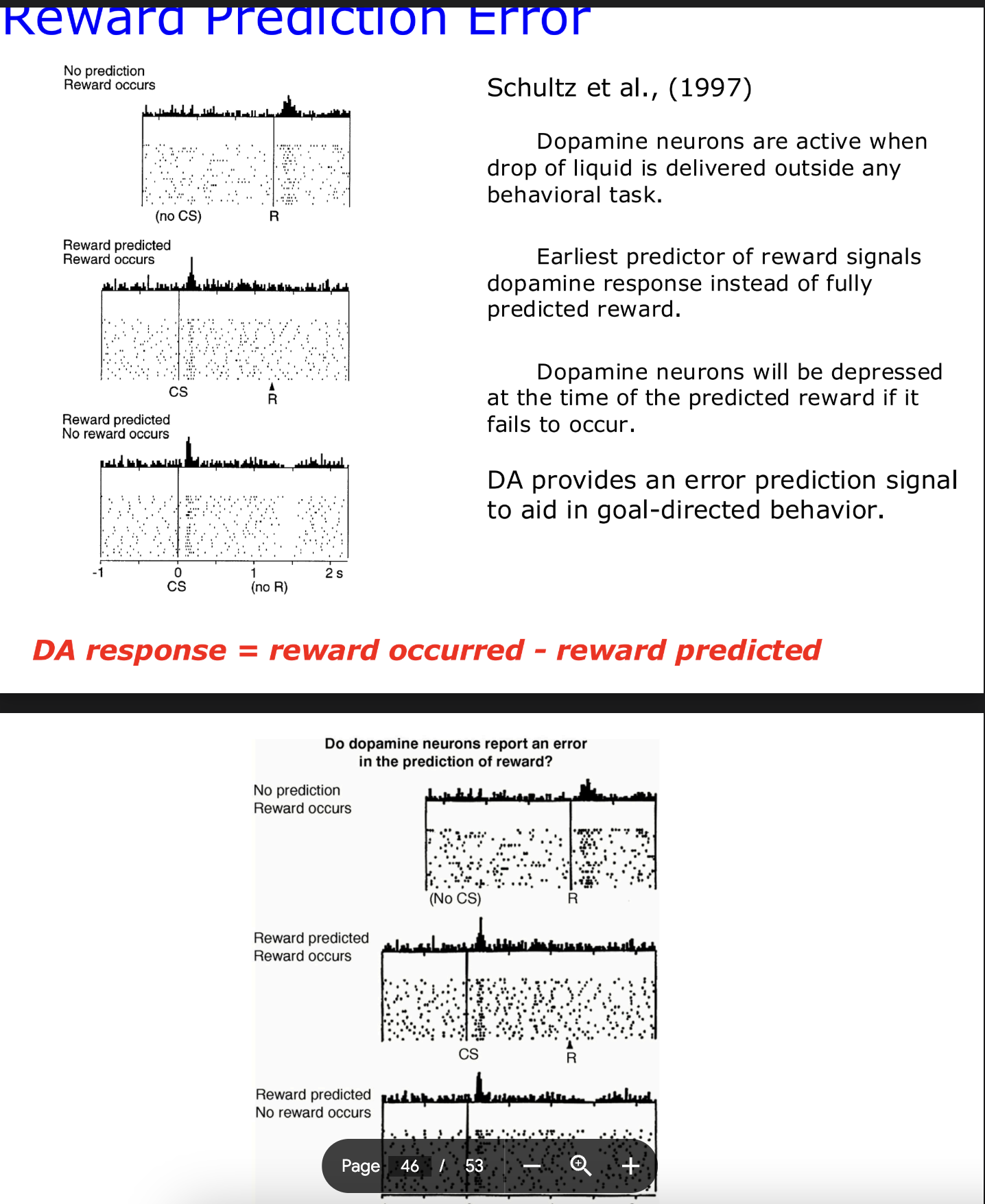
When will dopamine neurons be depressed? (Reward Prediction Error)
Dopamine neurons will be depressed when a predicted reward does not occur, signaling a negative reward prediction error and prompting adjustments in future behavior.
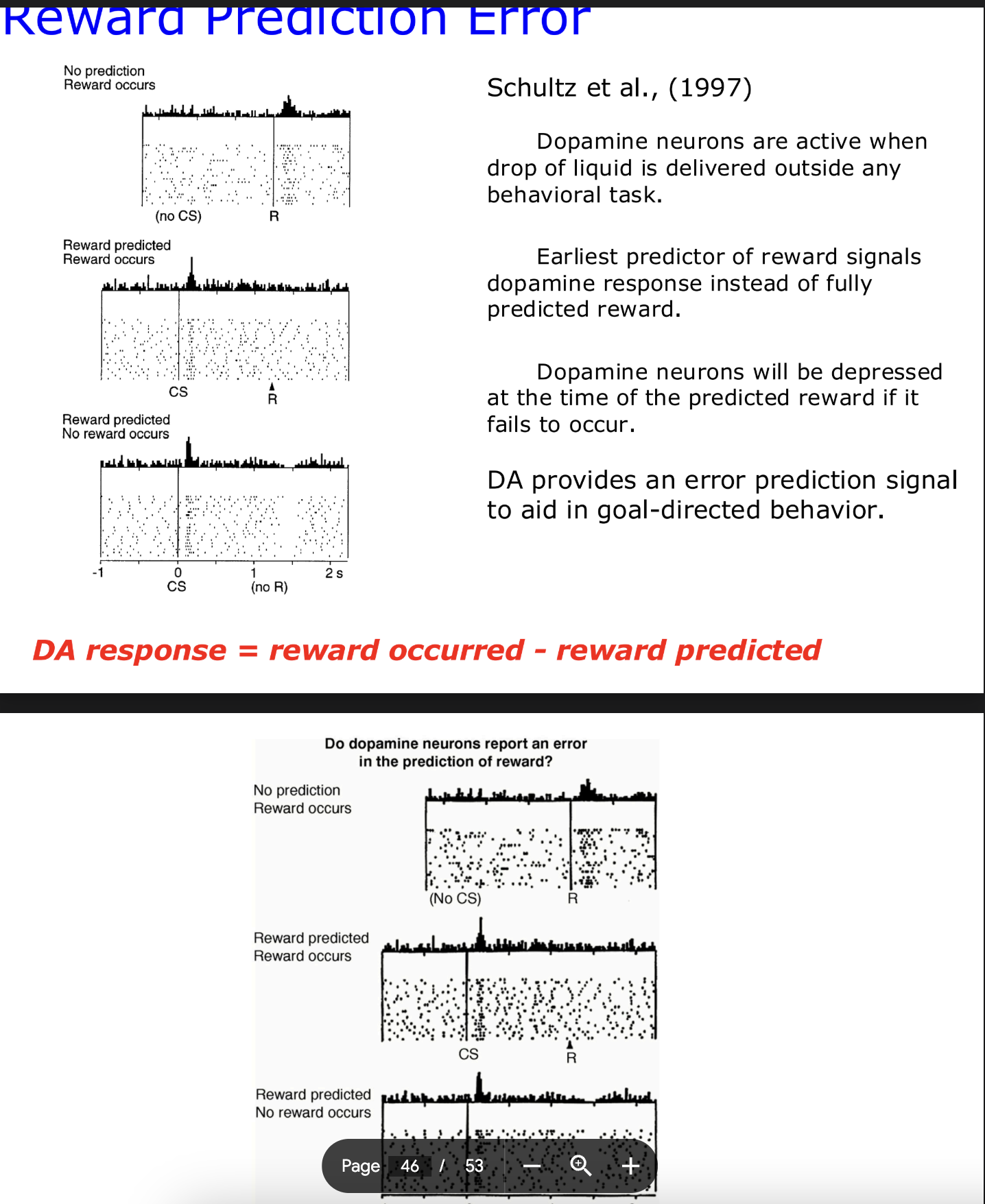
What does dopamine provide to aid in behavior? (Reward Prediction Error)
Dopamine provides an error prediction signal, helping to guide goal-directed behavior by indicating whether the reward prediction was accurate or needs to be adjusted based on previous outcomes.

What does the dopamine response equal or consist of? (Reward Prediction Error)
The dopamine response is the difference between the reward that occurred and the reward that was predicted—this constitutes the reward prediction error.
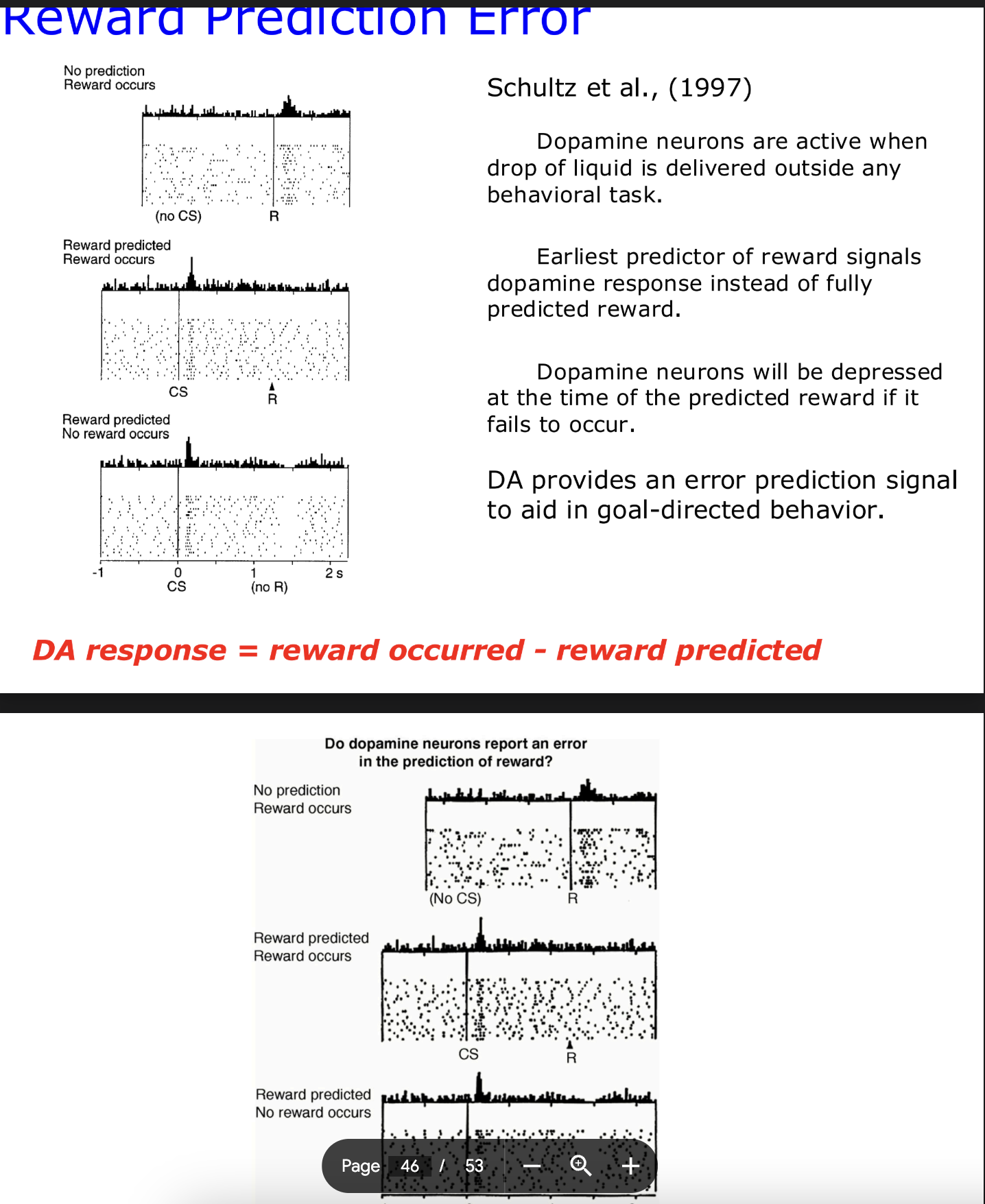
What is the interim summary for rewards and dopamine? (Summary)
Rewards drive behavior by signaling positive outcomes. Dopamine is central to reward processing, with its release occurring during rewarding situations. Dopamine is thought to help encode reward prediction errors, modifying behavior to optimize goal attainment.
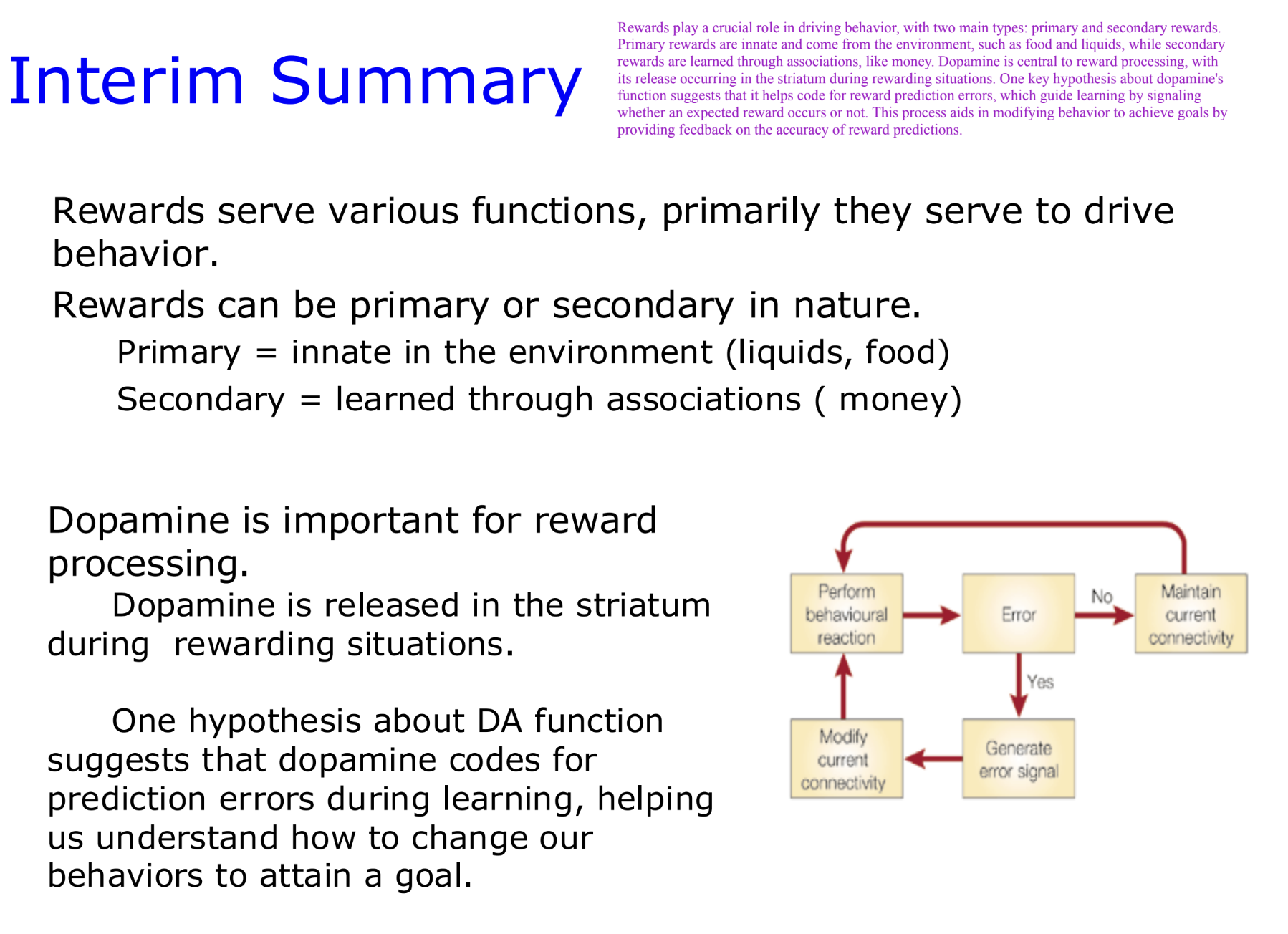
What is the summary for rewards in terms of neuroscience? (Summary)
Rewards serve two main functions: to motivate behavior and to reinforce learning. Rewards can be primary (innate, e.g., food) or secondary (learned, e.g., money). Dopamine plays a key role in processing rewards and motivating actions based on reward signals.
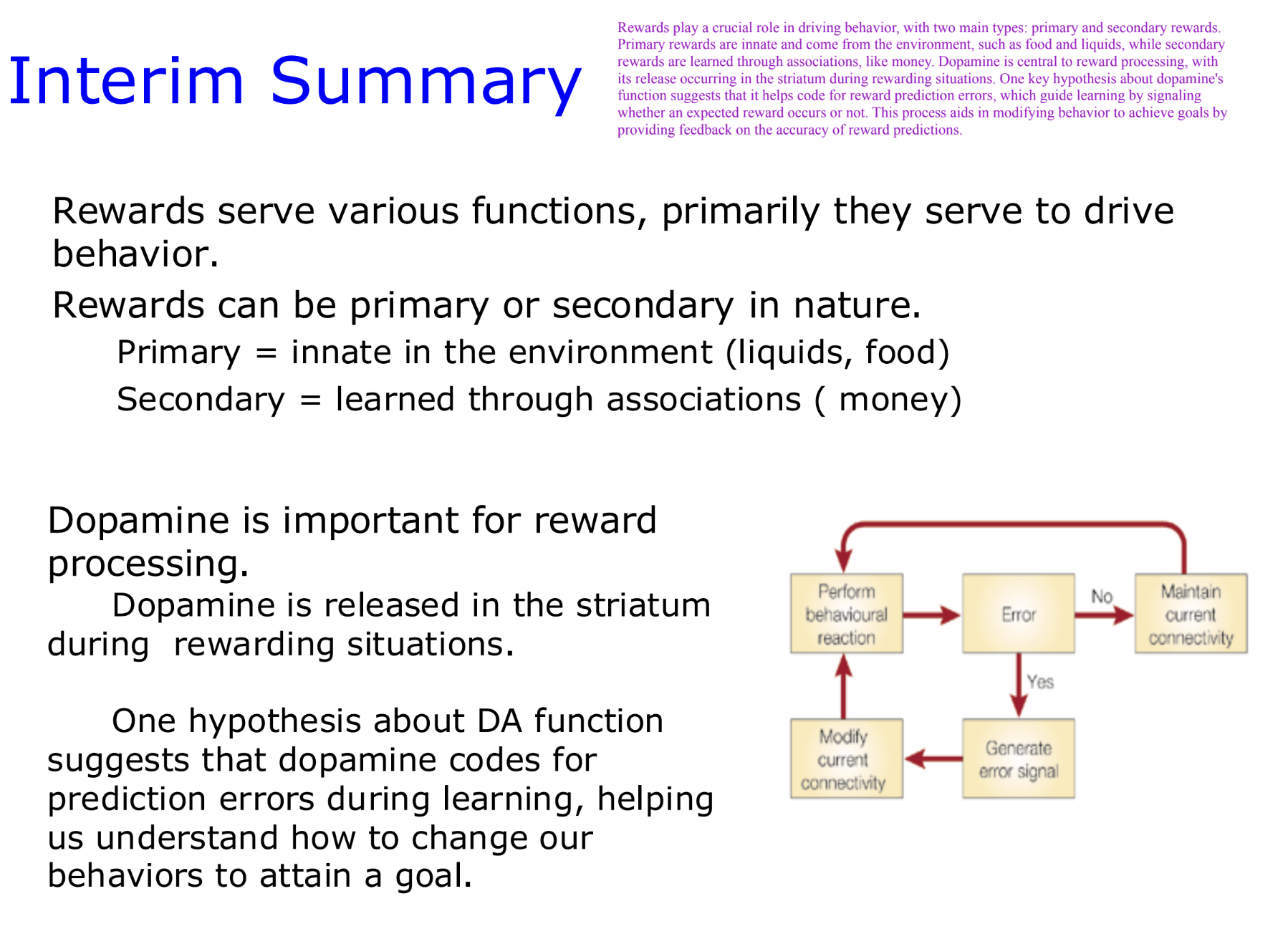
What is the summary for dopamine and its function in reward processing? (Summary)
Dopamine plays a crucial role in encoding reward prediction errors—the difference between expected and actual rewards. This process helps guide learning, behavior adjustment, and decision-making based on past experiences to attain desired outcomes.
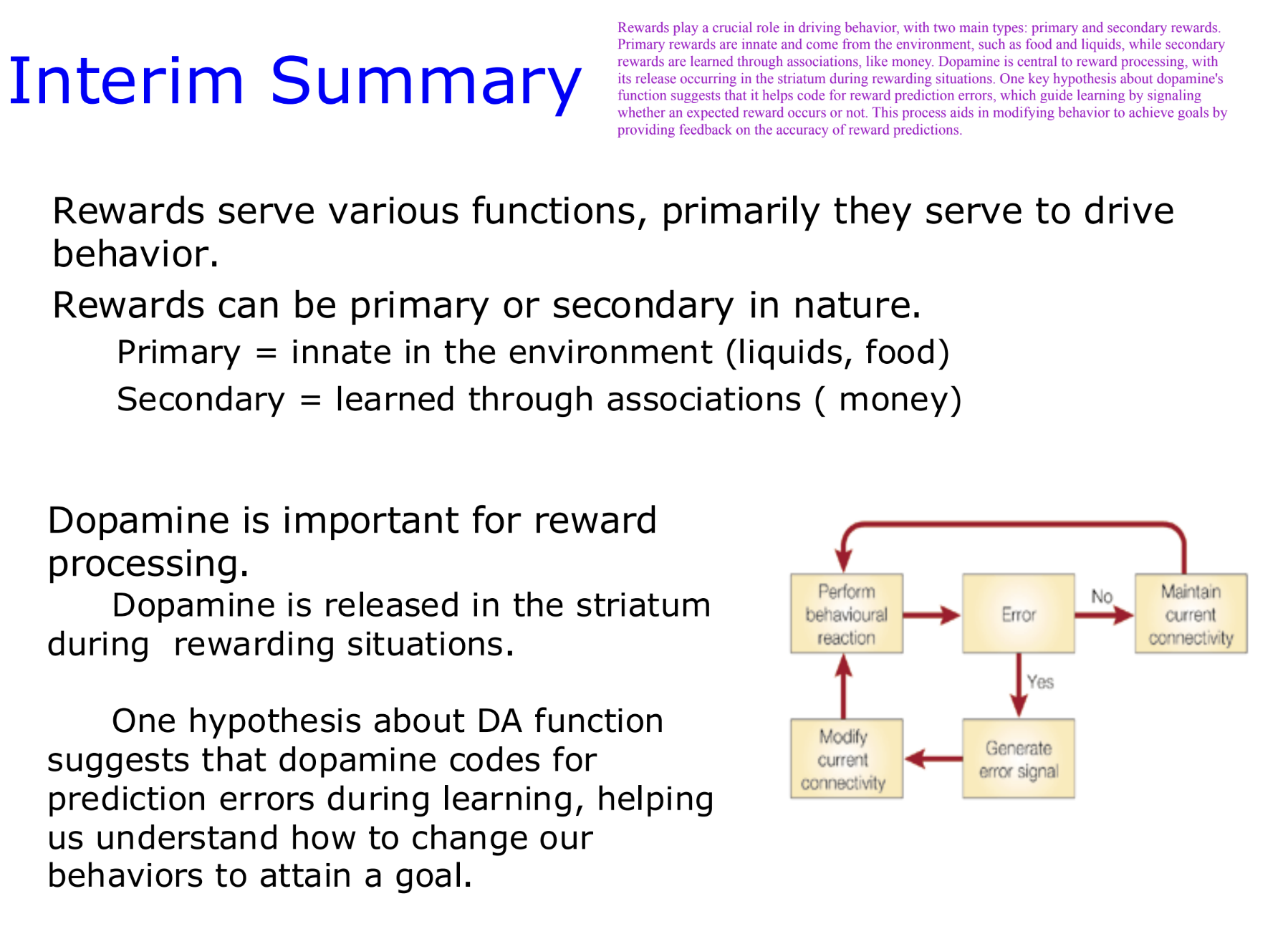
What is the prediction error hypothesis of dopamine? (Reward Prediction Error)
The prediction error hypothesis suggests that dopamine encodes the difference between expected and actual rewards. Positive prediction errors (unexpected rewards) trigger dopamine release, reinforcing behavior, while negative prediction errors (lack of expected rewards) lead to decreased dopamine activity.

How was the prediction error hypothesis of dopamine tested? (Reward Prediction Error)
The hypothesis was tested by Montague, Dayan, and Barto in the 1990s, where they showed that dopamine activity reflects the discrepancy between expected and actual rewards. This work demonstrated that dopamine helps guide behavioral learning based on these errors.
